Motorola Solutions 89FT7638 Fixed Outdoor Wireless User Manual
Motorola Solutions, Inc. Fixed Outdoor Wireless
Contents
- 1. Exhibit D Users Manual per 2 1033 b3
- 2. user manual
user manual

PMP 400/430 Series Networks
PTP 200/230 Series Bridges
Issue 6
August 2011

Notices
See important safety notice on exposure distance in Section 6.3 on page 71.
See important regulatory and legal notices in Section 6 on page 64.
Trademarks, Product Names, and Service Names
MOTOROLA SOLUTIONS, the stylized M Logo, Canopy, and all other trademarks indicated as
such herein are registered trademarks of Motorola, Inc. ® Reg. US Pat & Tm. Office. All other
product or service names are the property of their respective owners.
© 2011 Motorola Solutions, Inc. All rights reserved
http://www.motorola.com/canopy
http://motorola.wirelessbroadbandsupport.com
PMP 400/430 and PTP 200/230 Series Motorola PMP Solutions User Guide Supplement
Issue 6.0 May 2011 Page 2 of 77
Table of Contents
1 Introduction ............................................................................................................... 6
1.1 Document Change History ................................................................................. 7
1.2 Abbreviations ..................................................................................................... 8
1.3 Feedback on Documentation ............................................................................. 9
1.4 Technical Support .............................................................................................. 9
2 Product Description ................................................................................................ 11
2.1 Technology and Benefits ................................................................................. 22
2.1.1 nLOS Benefits and Limitations .......................................................................... 22
2.2 Applications ..................................................................................................... 23
2.3 Configuration Options – RF, IP, DFS ............................................................... 24
2.4 Power and Grounding ...................................................................................... 24
2.5 Administration Systems ................................................................................... 25
2.6 Specifications .................................................................................................. 26
2.6.1 Radio specifications (common to all formats) ................................................... 26
2.6.2 Specifications for PMP 430 (5.4 & 5.8-GHz) SM and PTP 230 (5.4 & 5.8-GHz)
BH radio with integrated antenna ................................................................................... 27
2.6.3 Specifications for PMP 400 (4.9 & 5.4-GHz) AP/SM and PTP 200 (4.9 & 5.4-
GHz) BH radio with integrated antenna .......................................................................... 28
2.6.4 Specification for PMP 400/430 AP and PTP 200 BH connectorized radio ....... 29
2.6.5 Specifications for PMP 400/430 kitted, connectorized radio (antenna included)29
2.7 Performance .................................................................................................... 31
3 Configuring .............................................................................................................. 41
3.1 Link Operation – 1X/2X/3X .............................................................................. 41
3.2 Transmitter Output Power (and no Jitter) ......................................................... 42
3.3 Downlink Data %, Range, and Control Slots .................................................... 44
3.4 DFS and Regulatory Parameters for 5.8 & 5.4 GHz Radios ............................. 46
3.4.1 Background and Operation ............................................................................... 46
3.4.2 Setting DFS and Regulatory Parameters .......................................................... 48
3.5 External Gain Field .......................................................................................... 52
3.6 Network Control Parameters ........................................................................... 53
3.7 Forward Error Correction ................................................................................. 53
3.8 Cyclic Prefix (Configurable only on PTP 200/230 BH & PMP 430 AP/SM) ....... 53
4 Installation ............................................................................................................... 55
4.1 Installing an AP with Connectorized Antenna .................................................. 55

PMP 400/430 and PTP 200/230 Series Motorola PMP Solutions User Guide Supplement
Issue 6.0 May 2011 Page 3 of 77
4.2 Installing an SM or BH with an Integrated Antenna .......................................... 62
5 Regulatory and Legal Notices ................................................................................ 64
5.1 Important Note on Modifications ...................................................................... 64
5.2 National and Regional Regulatory Notices....................................................... 64
5.2.1 U.S. Federal Communication Commission (FCC) Notification ......................... 64
5.2.2 Industry Canada (IC) Notification ...................................................................... 67
5.2.3 Regulatory Requirements for CEPT Member States (www.cept.org) ............... 68
5.2.4 European Union Notification for 5.8 GHz Product ............................................ 69
5.2.5 Equipment Disposal .......................................................................................... 69
5.2.6 EU Declaration of Conformity for RoHS Compliance ........................................ 69
5.2.7 UK Notification ................................................................................................... 69
5.2.8 Luxembourg Notification.................................................................................... 69
5.2.9 Czech Republic Notification .............................................................................. 70
5.2.10 Greece Notification ............................................................................................ 70
5.2.11 Brazil Notification ............................................................................................... 70
5.2.12 Labeling and Disclosure Table for China .......................................................... 70
5.3 Exposure Separation Distances ....................................................................... 71
5.3.1 Details of Exposure Separation Distances Calculations and Power
Compliance Margins ....................................................................................................... 71
5.4 Legal Notices ................................................................................................... 73
5.4.1 Software License Terms and Conditions .......................................................... 73
5.4.2 Hardware Warranty in US ................................................................................. 75
5.5 Limit of Liability ................................................................................................ 75
List of Tables
Table 1: Motorola PMP 400/430 and PTP 200/230 Series............................................. 12
Table 2: 5.8GHz OFDM - PMP 430 and PTP 230 Series Model Number Descriptions .. 12
Table 3: 5.4GHz OFDM - PMP 430 Series Model Number Descriptions ........................ 14
Table 4: 5.4GHz OFDM - PMP 400 and PTP 200/230 Model Number Descriptions ...... 15
Table 5: 4.9GHz OFDM - PMP 400 and PTP 200 Model Number Descriptions ............. 16
Table 6: CMM4 56VDC and 30 VDC Operation ............................................................. 17
Table 7: Ancillary Equipment and Model Numbers ........................................................ 20
Table 8: Performance Details ........................................................................................ 32
PMP 400/430 and PTP 200/230 Series Motorola PMP Solutions User Guide Supplement
Issue 6.0 May 2011 Page 4 of 77
Table 9: PMP 400/430 and PTP 200/230 Tx output power ............................................ 42
Table 10: PMP 400/430 AP Control Slot Settings .......................................................... 45
Table 11: 5.4 / 5.8 GHz OFDM DFS Operation based on Region Code ........................ 47
Table 12: US FCC IDs and Industry Canada Certification Numbers and Covered
Configurations ........................................................................................................ 65
Table 13: Disclosure Table ............................................................................................ 71
Table 14: Exposure Separation Distances ..................................................................... 71
Table 15: Calculated Exposure Distances and Power Compliance Margins .................. 72
List of Figures
Figure 1: PMP 430 CAP 54430 & 58430 ......................................................................... 6
Figure 2: PMP 400 CAP 54400 - 5.4 GHz ....................................................................... 6
Figure 3: PMP 400 CAP 49400 - 4.9 GHz ....................................................................... 6
Figure 4: PMP 430 CSM 54430 & 58430 ......................................................................... 6
Figure 5: PMP 400 CSM 54400 - 5.4GHz ........................................................................ 6
Figure 6: PMP 400 CSM 49400 - 4.9 GHz ....................................................................... 6
Figure 7: PTP 200 Integrated .......................................................................................... 7
Figure 8: PTP 200 Connectorized ................................................................................... 7
Figure 9: PTP 230 Integrated .......................................................................................... 7
Figure 10: CMM4 56 VDC Power Supply ...................................................................... 18
Figure 11: CMMmicro and CMM4 30 VDC Power Supply ...................................... 18
Figure 12: CMM4 - 56 VDC and 30 VDC terminal blocks .............................................. 18
Figure 13: 600SS Surge Suppression AP and SM diagram ........................................... 19
Figure 14: LOS, nLOS, and NLOS ................................................................................ 23
Figure 15: AP Grounding Lug ........................................................................................ 25
Figure 16: 600SS pole mount kit ................................................................................... 25
Figure 17: PMP 430 SM ................................................................................................ 28
Figure 18: PMP 430 SM with Optional LENS ................................................................ 28
Figure 19: PMP 400 and PTP 200 radio with integrated antenna .................................. 29
Figure 20: PMP 400/430 and PTP 200 BH connectorized radio .................................... 29
Figure 21: CAP 49400 ................................................................................................... 30
Figure 22: CAP 58430 and 54430 ................................................................................. 30
Figure 23: Dynamic Rate Adapt on AP "Configuration => General" page ...................... 41
Figure 24: SM Power Level on AP “Home => Session Status” page. ............................ 44
Figure 25: Max Range & Downlink Data on AP "Configuration => Radio" page. ............ 45
PMP 400/430 and PTP 200/230 Series Motorola PMP Solutions User Guide Supplement
Issue 6.0 May 2011 Page 5 of 77
Figure 26: DFS Status on AP "Home => DFS Status" page. ......................................... 46
Figure 27: Region Code on AP “Configuration => General” page .................................. 50
Figure 28: Configured Region Code on SM Configuration => General page ................. 51
Figure 29: Active Region Code on SM Home => General Status page .......................... 51
Figure 30: Ground lug highlighted on AP ....................................................................... 61
Figure 31: Dielectric Grease – Apply to RJ45 connector ............................................... 62
Figure 32: Dielectric Grease - Insert Ethernet Cable ..................................................... 63
List of Procedures
Procedure 1: Assembling a 5.8 or 5.4 GHz AP, and attaching to tower ......................... 56
Procedure 2: Assembling a 4.9 GHz AP, and attaching to tower ................................... 58
Procedure 3: Cabling and Grounding/Earthing the AP ................................................... 61
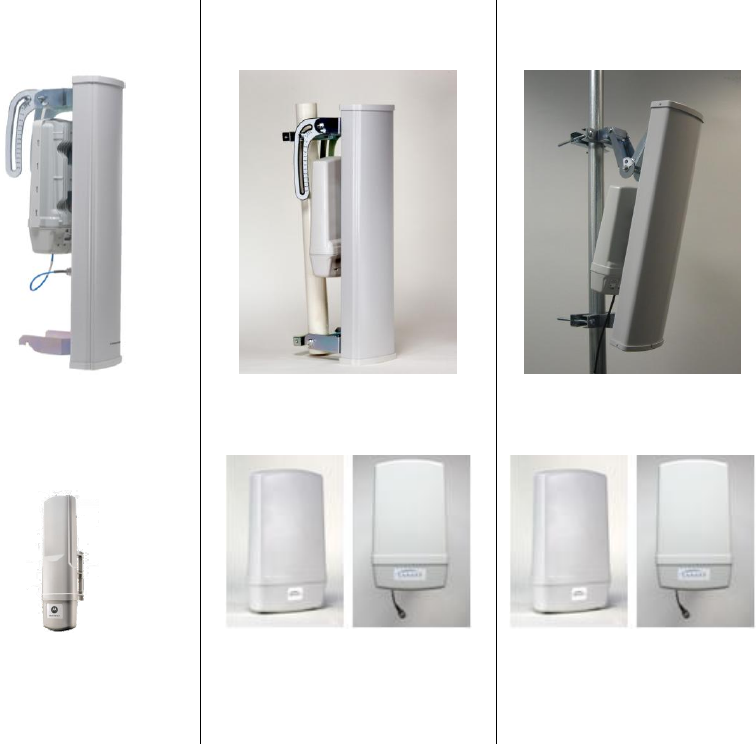
PMP 400/430 and PTP 200/230 Series Motorola PMP Solutions User Guide Supplement
Issue 6.0 May 2011 Page 6 of 77
1 Introduction
This guide provides product configuration information specific to the PMP 400/430 Series
networks and PTP 200/230 Series bridges in 5.8-GHz, 5.4-GHz and 4.9-GHz bands. Note: PMP
400 5.4-GHz Series is replaced with PMP 430 5.4-GHz Series.
PMP 430 Series
– 5.4 & 5.8 GHz
Figure 1: PMP 430 CAP
54430 & 58430
PMP 400 Series
– 5.4 GHz
Figure 2: PMP 400 CAP 54400
- 5.4 GHz
PMP 400 Series
– 4.9 GHz
Figure 3: PMP 400 CAP
49400 - 4.9 GHz
Figure 4: PMP 430 CSM
54430 & 58430
Figure 5: PMP 400 CSM 54400
- 5.4GHz
Integrated and Connectorized
Figure 6: PMP 400 CSM
49400 - 4.9 GHz
Integrated and Connectorized
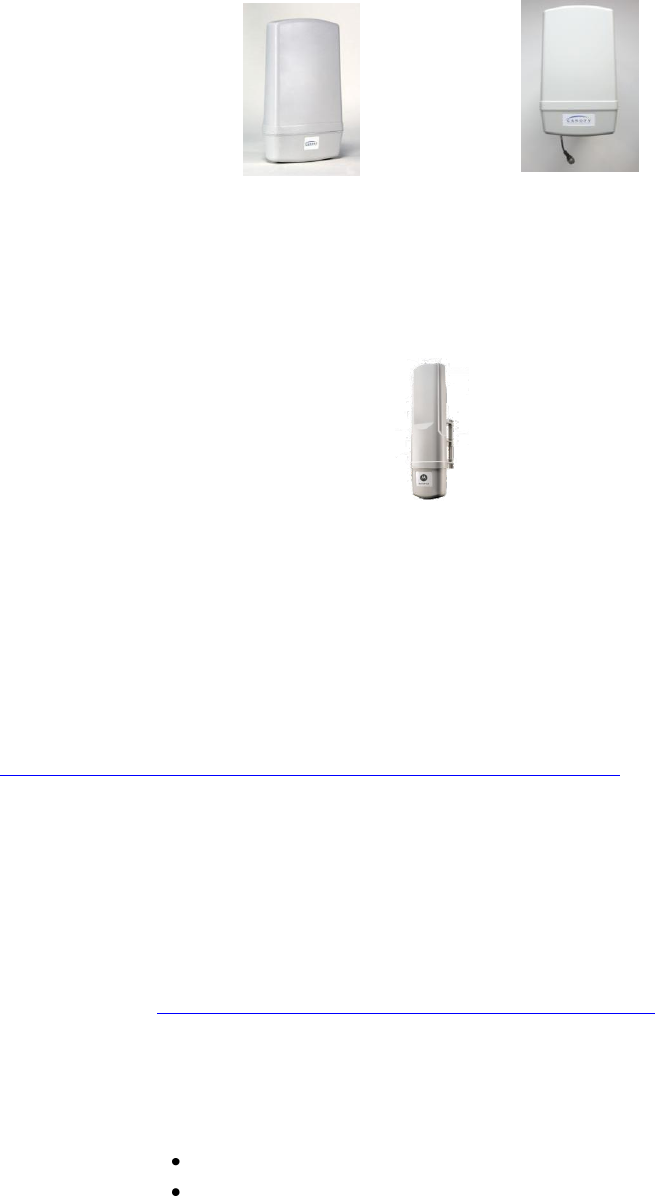
PMP 400/430 and PTP 200/230 Series Motorola PMP Solutions User Guide Supplement
Issue 6.0 May 2011 Page 7 of 77
PTP 200 Series Backhauls –5.4 and 4.9 GHz
Figure 7: PTP 200
Integrated
PTP 54200 and 49200
Figure 8: PTP 200
Connectorized
PTP 54200 and 49200
PTP 230 Series Backhauls –5.4 and 5.8 GHz
Figure 9: PTP 230
Integrated
PTP 54230 and 58230
This guide should be used along with the Motorola PMP Solutions User Guide, which covers
general information, including all network features, RF control features, and GUI (Graphical User
Interface) features common across PMP 100, 400, and 500 Series networks and PTP 100 and
200 Series bridges. The Motorola PMP Solutions User Guide is available from the “User Guides”
section of the Canopy Document Library,
http://motorola.motowi4solutions.com/support/library/?region=1&cat=8.
This guide assumes that the reader has general RF (Radio Frequency) and Internet Protocol (IP)
knowledge and background.
This issue, Issue 6, is consistent with features provided by Canopy Release 11.0.1 (and
consistent with features provided by PTP 230 Canopy Release 10.7). Separate Release Notes for
each release are available and include open issues and other important information specific to
each release.
R11.0.1 and R10.7 Software and software release notes can be downloaded from the Motorola
support web site: http://motorola.wirelessbroadbandsupport.com/software/.
1.1 DOCUMENT CHANGE HISTORY
Issue 1
First Issue
Issue 2
Added the following:
PTP 200 Series – 5.4-GHz BHs
PMP 400 and PTP 200 – Products using AES encryption

PMP 400/430 and PTP 200/230 Series Motorola PMP Solutions User Guide Supplement
Issue 6.0 May 2011 Page 8 of 77
Software Release 8.4.3 features
Issue 3
Added the following 4.9-GHz public safety band products:
PTP 200 Series – 4.9-GHz BHs
PMP 400 Series – 4.9-GHz APs and SMs
Software Release 9.4.2 features
Issue 4
Added the following:
Software Release 9.5 features to support PMP 400 and PTP 200
PMP 430 Series – 5.8-GHz APs and SMs
Software Release 10.0 features to support PMP 430 (10MHz channel)
Updated customer support email and phone numbers
Issue 5
Added the following:
PMP 430 Series 5.4-GHz AP and SM
PMP 430 Series (5.4 and 5.8-GHz OFDM) with Release 10.3
o Configurable 5, 10 and 20 MHz channel bandwidth
Note: PMP 400 Series 5.4-GHz OFDM supports 10MHz channels.
o 2.5MHz center channels when configured for 5MHz channel bandwidth
o Added support for 1/16 Cyclic Prefix in addition to 1/4 and 1/8
Note: PMP 400 Series 5.4-GHz OFDM supports 1/4 Cyclic Prefix
o Increased Packets Per Second (PPS) from 6,800 to 15,000 PPS
o 802.1ad Q-in-Q DVLAN (Double VLAN) tagging
o Dynamic Rate Adapt – configurable (1X, 2X, 3X) uplink/downlink rate
PMP 400 and PTP 200 Series with Release 10.3
o 802.1ad Q-in-Q DVLAN (Double VLAN) tagging
o Dynamic Rate Adapt – configurable(1X, 2X, 3X) uplink/downlink rate
Issue 6
Added the following:
PTP 230 Series 5.4 and 5.8-GHz BHM and BHS
1.2 ABBREVIATIONS
The following abbreviations may be used in these notes:
1X
1X (QPSK) modulation
2X
2X (16 QAM) modulation
3X
3X (64 QAM) modulation
AES
AP
Advanced Encryption Standard
Access Point Module
BH
Backhaul Module, either timing master or timing slave
BHM
Backhaul Module – Master
BHS
CAP
CIR
Backhaul Module – Slave
Access Point Module
Committed Information Rate
CMM
Cluster Management Module (CMM4 or CMMicro)
CNUT
CSM
Canopy Network Updater Tool
Subscriber Module
DES
DFS
Data Encryption Standard
Dynamic Frequency Selection for radar avoidance

PMP 400/430 and PTP 200/230 Series Motorola PMP Solutions User Guide Supplement
Issue 6.0 May 2011 Page 9 of 77
DHCP
DiffServ
Dynamic Host Configuration Protocol
Differentiated Services
EIRP
Equivalent Isotropically Radiated Power
ETSI
European Telecommunications Standards Institute
EU
FCC
FSK
GHz
GPS
European Union
Federal Communications Commission (United States)
Frequency Shift Keying
Gigahertz
Global Positioning System
Note: CMM uses GPS to synchronize APs & BHs
LoS
MIB
MIR
NAT
Line of Sight
Management Information Base for SNMP
Maximum Information Rate
Network Address Translation
nLoS
NLoS
OFDM
Near Line of Sight
Non Line of Sight
Orthogonal Frequency Division Multiplexing
PMP
PPS
PTP
Point-to-Multi-Point (AP to SMs)
Packet Per Second
Point-to-Point (Backhauls)
QAM
Quadrature Amplitude Modulation
QPSK
Quadrature Phase Shift Keying
RF
Radio Frequency
SM
VDC
VLAN
Subscriber Module
Volts Direct Current
Virtual Local Area Network
1.3 FEEDBACK ON DOCUMENTATION
Is this document accurate, complete, and clear? How can it be improved? Please send your
feedback on Canopy documentation to technical-documentation@canopywireless.com.
1.4 TECHNICAL SUPPORT
Tip! Do not clear the Event Log after you encounter issues. It may be useful to
Technical Support, if you need to escalate the issue.
Here is the escalation path for resolution of a problem:
1. Check documentation:
this document
Canopy System Release 8 Users Guide, available at
http://motorola.wirelessbroadbandsupport.com/software.
2. Consider checking the Community Forum and Knowledge Base at
http://motorola.wirelessbroadbandsupport.com/support/community.
3. Escalate the problem to your Canopy supplier or reseller.
4. Escalate the problem to Canopy Technical Support or other designated Tier 3
technical support:

PMP 400/430 and PTP 200/230 Series Motorola PMP Solutions User Guide Supplement
Issue 6.0 May 2011 Page 10 of 77
U.S. and Canada Email: technical-support@canopywireless.com
1-866-961-9288
Latin and Central America Email: technical-support@canopywireless.com
Argentina 0800-666-2789
Brazil 0800-891-4360
Columbia 01-800-912-0557
Mexico 001-800-942-7721
Peru 0800-70-086
All other countries +420 533 336 946
Europe, Middle East, Email: essc@motorola.com
and Africa Denmark 043682114
France 0157323434
Germany 06950070204
Italy 0291483230
Lithuania 880 030 828
Netherlands 0202061404
Norway 24159815
Portugal 0217616160
Spain 0912754787
Russia 810 800 228 41044
Saudi Arabia 800 844 5345
South Africa 0800981900
United Kingdom 0203 0277499
Asia Pacific Email: WiBBsupport.apac@motorola.com
+6048503854 (9am - 5pm Malaysia Time)
+420 533 336 946 (outside hours)
When you send e-mail or call, please include, as appropriate, software release on each module,
IP addresses, MAC addresses, and features enabled, like NAT, VLAN, high priority channel, or
CIR. You may be asked to run the Support Tool on CNUT or Prizm to provide a complete network
picture.

PMP 400/430 and PTP 200/230 Series Motorola PMP Solutions User Guide Supplement
Issue 6.0 May 2011 Page 11 of 77
2 Product Description
PMP 400/430 Series networks and PTP 200/230 Series bridges add OFDM-based (Orthogonal
Frequency Division Multiplexing) products to the Canopy family.
PMP 430 5.4 and 5.8-GHz SMs as shown in Figure 4 on page 6 use the Canopy SM form
factor with an integrated antenna.
PMP 400 5.4-GHz SMs as shown in Figure 5 on page 6 are available with either an
integrated antenna or an external N-type connector on a short length of coaxial cable for
connecting to a connectorized antenna.
PMP 400 5.4-GHz AP and PMP 430 5.4 and 5.8-GHz APs as shown on page 6 are
always connectorized, and sold either as a radio with a connectorized antenna as a kit, or
as a radio with an external N-type connector on a short length of coaxial cable for
connecting to an operator-provided antenna. U.S. customers must use the kit version
since the FCC requires the radio to be regulatory certified with the connectorized
antenna.
PTP 200 5.4 and 4.9-GHz BHs as shown in Figure 7 and Figure 8 on page 7 are
available with either an integrated antenna or an external N-type connector on a short
length of coaxial cable for connecting to a connectorized antenna.
PTP 230 5.4 and 5.8-GHz BHs as shown in Figure 9 on page 7 use the Canopy SM form
factor with an integrated antenna.
PMP 400/430 Series networks are available in multiple bands:
PMP 58430 APs and SM provide connectivity in the unlicensed 5.8 GHz band.
PMP 54430 APs and SMs provide connectivity in the unlicensed 5.4 GHz band.
PMP 54400 APs and SMs provide connectivity in the unlicensed 5.4 GHz band.
PMP 49400 APs and SMs provide connectivity in the licensed 4.9 GHz band allocated to
public safety services. State and local governmental entities are eligible to hold 4.9 GHz
licenses.
PTP 200/230 Series networks are available in multiple bands:
PTP 54200 BHs provide connectivity in the unlicensed 5.4 GHz band.
PTP 49200 BHs provide connectivity in the licensed 4.9 GHz band allocated to public
safety services. State and local governmental entities are eligible to hold 4.9 GHz
licenses.
PTP 54230 BHs provide connectivity in the unlicensed 5.4 GHz band.
PTP 58230 BHs provide connectivity in the unlicensed 5.8 GHz band.
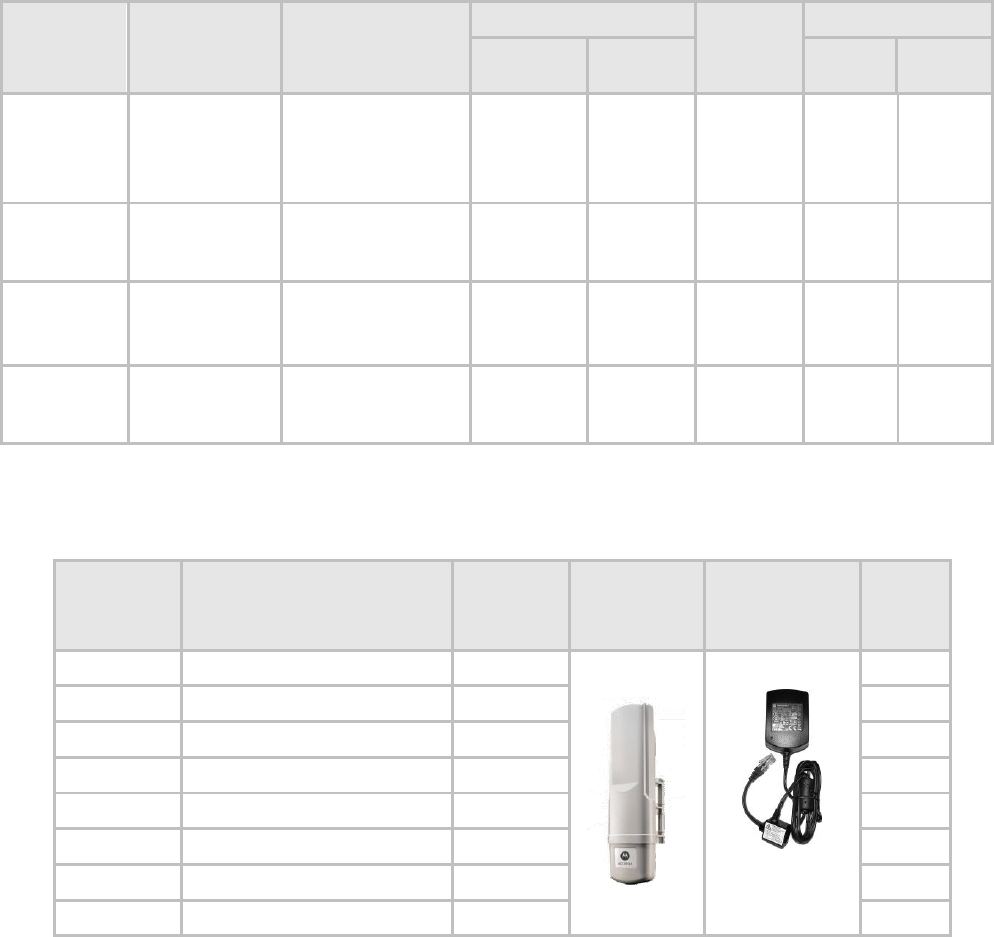
PMP 400/430 and PTP 200/230 Series Motorola PMP Solutions User Guide Supplement
Issue 6.0 May 2011 Page 12 of 77
Table 1 shows the Motorola PMP 400/430 Series and PTP 200/230 Series of products by
frequency band, channel bandwidth, cyclic prefix and current software version.
Table 1: Motorola PMP 400/430 and PTP 200/230 Series
Frequency
PMP Series
(Point-to-
MultiPoint)
PTP Series
(Point-To-Point)
Channel Bandwidth
Cyclic
Prefix
Software Version
PMP
Series
PTP
Series
PMP
Series
PTP
Series
5.8 GHz
PMP 430
Series -
58430
PTP 230 Series
-58230
5, 10 or
20MHz
10 or
20MHz
1/4, 1/8
or 1/16
11.0.1
10.7
5.4 GHz
PMP 430
Series -
54430
PTP 230 Series
-54230
5, 10 or
20MHz
10 or
20MHz
1/4, 1/8
or 1/16
11.0.1
10.7
5.4 GHz
PMP 400
Series
- 54400
PTP 200 Series
- 54200
10MHz
10MHz
1/4
11.0.1
11.0.1
4.9 GHz
PMP 400
Series -
49400
PTP 200 Series
- 49200
10MHz
10MHz
1/4
11.0.1
11.0.1
Table 2 shows the Motorola PMP 430 Series (5.8 GHz OFDM) AP and SM models.
Table 2: 5.8GHz OFDM - PMP 430 and PTP 230 Series Model Number Descriptions
CSM 58430
Model
Number
5.8GHz OFDM Subscriber
Module (SM) Description
Encryption
Picture
Power 29.5
VDC
Supply Type
Specs
in
Section
5790SM4
5.8 GHz OFDM SM – 4 Mbps
DES
Refer to Table 7
for Models
2.6.2
5791SM4
5.8 GHz OFDM SM – 4 Mbps
AES
2.6.2
5790SM10
5.8 GHz OFDM SM – 10 Mbps
DES
2.6.2
5791SM10
5.8 GHz OFDM SM – 10 Mbps
AES
2.6.2
5790SM20
5.8 GHz OFDM SM – 20 Mbps
DES
2.6.2
5791SM20
5.8 GHz OFDM SM – 20 Mbps
AES
2.6.2
5790SM40
5.8 GHz OFDM SM – Uncapped
DES
2.6.2
5791SM40
5.8 GHz OFDM SM – Uncapped
AES
2.6.2
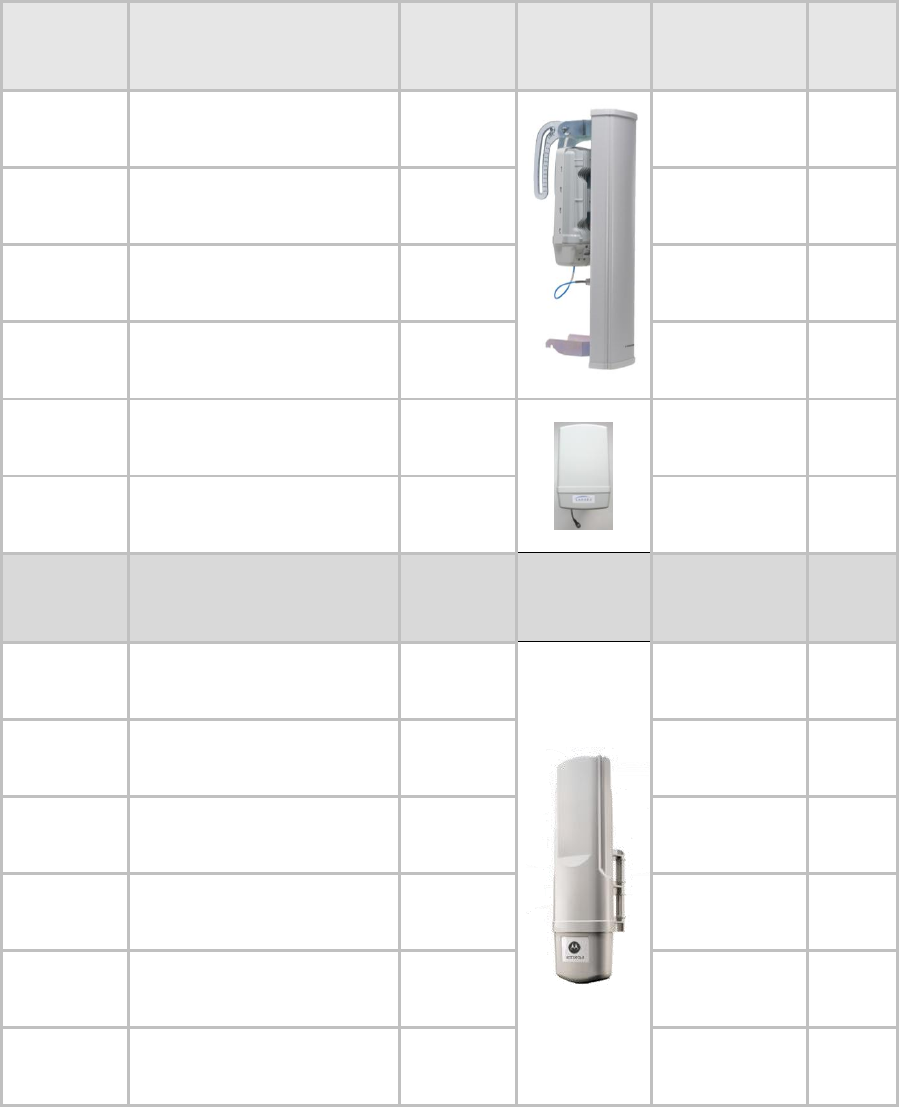
PMP 400/430 and PTP 200/230 Series Motorola PMP Solutions User Guide Supplement
Issue 6.0 May 2011 Page 13 of 77
CAP 58430
Model
Number
5.8GHz OFDM Access Point
(AP) Description
Encryption
Picture
CMM Type
Specs
in
Section
5780AP
5.8 GHz OFDM Connectorized
AP w/antenna
DES
Requires CMM4
w/56 VDC
supply
2.6.5
5780APUS
5.8 GHz OFDM Connectorized
AP w/antenna - US Model
DES
Requires CMM4
w/56 VDC
supply
2.6.5
5781AP
5.8 GHz OFDM Connectorized
AP w/antenna
AES
Requires CMM4
w/56 VDC
supply
2.6.5
5781APUS
5.8 GHz OFDM Connectorized
AP w/antenna - US Model
AES
Requires CMM4
w/56 VDC
supply
2.6.5
5780APC
5.8 GHz OFDM Connectorized
AP – No antenna
DES
Requires CMM4
w/56 VDC
supply
2.6.4
5781APC
5.8 GHz OFDM Connectorized
AP - No antenna
AES
Requires CMM4
w/56 VDC
supply
2.6.4
PTP 58230
Model
Number
5.8GHz OFDM Backhaul (BH)
Description
Encryption
Picture
CMM Type
Specs
in
Section
5780BH10
5.8 GHz OFDM BH – 10 Mbps
DES
Requires CMM4
w/56 VDC
supply
2.6.6
5780BH20
5.8 GHz OFDM BH – 20 Mbps
DES
Requires CMM4
w/56 VDC
supply
2.6.6
5780BH50
5.8 GHz OFDM BH –
Uncapped
DES
Requires CMM4
w/56 VDC
supply
2.6.6
5781BH10
5.8 GHz OFDM BH – 10 Mbps
AES
Requires CMM4
w/56 VDC
supply
2.6.6
5781BH20
5.8 GHz OFDM BH – 20 Mbps
AES
Requires CMM4
w/56 VDC
supply
2.6.6
5781BH50
5.8 GHz OFDM BH –
Uncapped
AES
Requires CMM4
w/56 VDC
supply
2.6.6
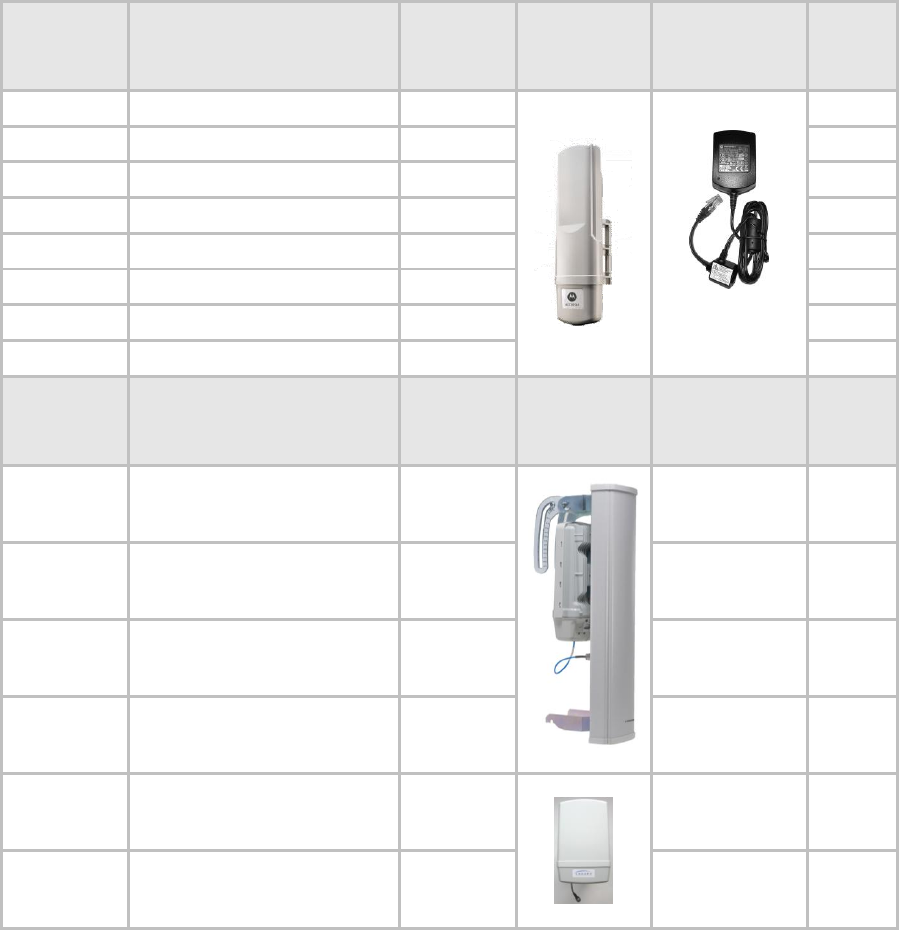
PMP 400/430 and PTP 200/230 Series Motorola PMP Solutions User Guide Supplement
Issue 6.0 May 2011 Page 14 of 77
Table 3 shows the Motorola PMP 430 Series (5.4 GHz OFDM) AP and SM models.
Table 3: 5.4GHz OFDM - PMP 430 Series Model Number Descriptions
CSM 54430
Model
Number
5.4GHz OFDM Subscriber
Module (SM) Description
Encryption
Picture
Power 29.5
VDC
Supply Type
Specs
in
Section
5490SM4
5.4 GHz OFDM SM – 4 Mbps
DES
Refer to Table 7
for Models
2.6.2
5491SM4
5.4 GHz OFDM SM – 4 Mbps
AES
2.6.2
5490SM10
5.4 GHz OFDM SM – 10 Mbps
DES
2.6.2
5491SM10
5.4 GHz OFDM SM – 10 Mbps
AES
2.6.2
5490SM20
5.4 GHz OFDM SM – 20 Mbps
DES
2.6.2
5491SM20
5.4 GHz OFDM SM – 20 Mbps
AES
2.6.2
5490SM40
5.4 GHz OFDM SM – Uncapped
DES
2.6.2
5491SM40
5.4 GHz OFDM SM – Uncapped
AES
2.6.2
CAP 54430
Model
Number
5.4GHz OFDM Access Point
(AP) Description
Encryption
Picture
CMM Type
Specs
in
Section
5480AP
5.4 GHz OFDM Connectorized
AP w/antenna
DES
Requires CMM4
w/56 VDC
supply
2.6.5
5480APUS*
5.4 GHz OFDM Connectorized
AP w/antenna - US Model
DES
Requires CMM4
w/56 VDC
supply
2.6.5
5481AP
5.4 GHz OFDM Connectorized
AP w/antenna
AES
Requires CMM4
w/56 VDC
supply
2.6.5
5481APUS*
5.4 GHz OFDM Connectorized
AP w/antenna - US Model
AES
Requires CMM4
w/56 VDC
supply
2.6.5
5480APC
5.4 GHz OFDM Connectorized
AP – No antenna
DES
Requires CMM4
w/56 VDC
supply
2.6.4
5481APC
5.4 GHz OFDM Connectorized
AP - No antenna
AES
Requires CMM4
w/56 VDC
supply
2.6.4
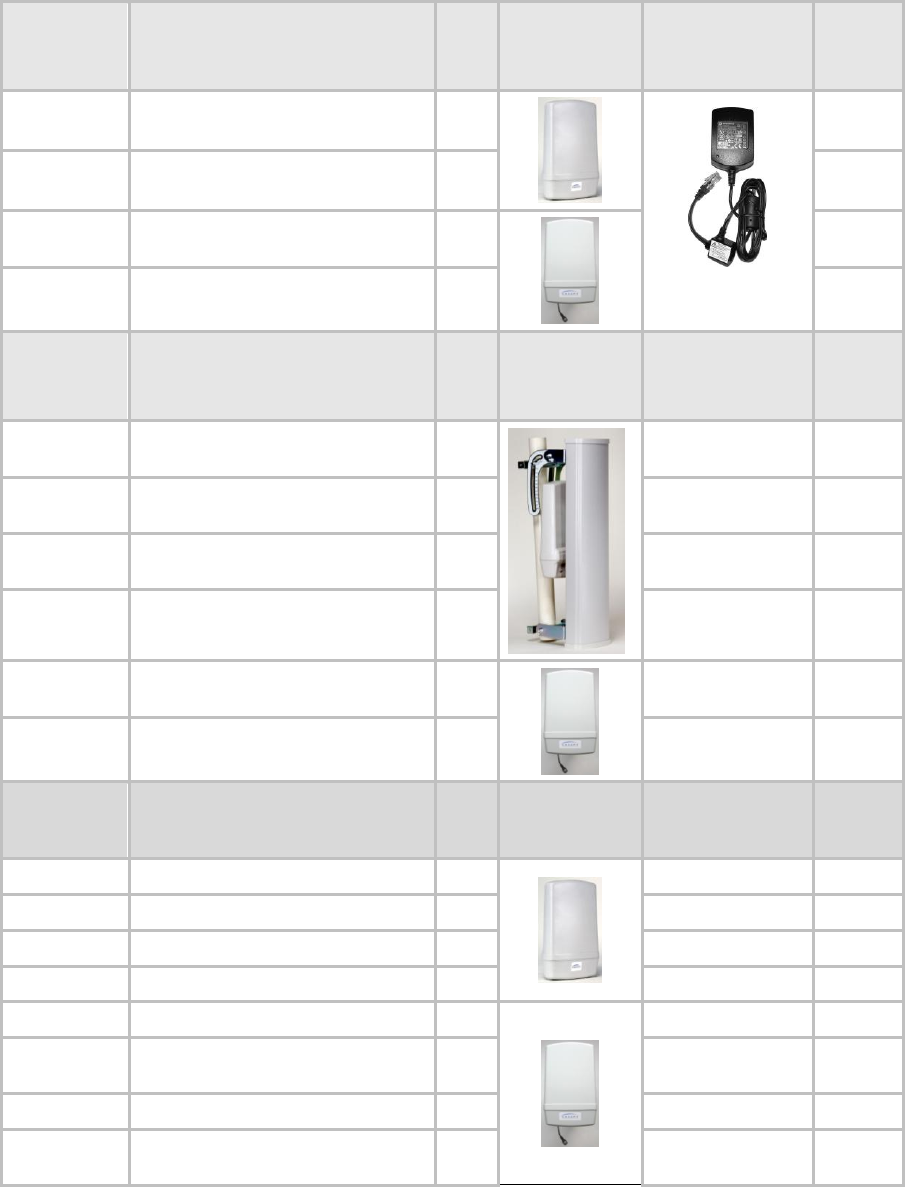
PMP 400/430 and PTP 200/230 Series Motorola PMP Solutions User Guide Supplement
Issue 6.0 May 2011 Page 15 of 77
Table 4 shows the Motorola PMP 400 and PTP 200/230 Series (5.4 GHz OFDM) models
available.
Table 4: 5.4GHz OFDM - PMP 400 and PTP 200/230 Model Number Descriptions
CSM 54400
Model
Number
5.4 GHz OFDM Subscriber
Module (SM) Description
DES
or
AES
Picture
Power 29.5 VDC
Supply Type
Specs
in
Section
5440SM
5.4 GHz OFDM SM
DES
Refer to Table 7
for Models
2.6.3
5441SM
5.4 GHz OFDM SM
AES
2.6.3
5440SMC
5.4 GHz OFDM Connectorized SM
DES
2.6.4
5441SMC
5.4 GHz OFDM Connectorized SM
AES
2.6.4
CAP 54400
Model
Number
5.4 GHz OFDM Access Point (AP)
Description
DES
or
AES
Picture
CMM Type
Specs
in
Section
5440AP
5.4 GHz OFDM Connectorized AP
w/antenna
DES
CMMmicro or CMM4
2.6.5
5440APUS
5.4 GHz OFDM Connectorized AP
w/antenna - US Model
DES
CMMmicro or CMM4
2.6.5
5441AP
5.4 GHz OFDM Connectorized AP
w/antenna
AES
CMMmicro or CMM4
2.6.5
5441APUS
5.4 GHz OFDM Connectorized AP
w/antenna - US Model
AES
CMMmicro or CMM4
2.6.5
5440APC
5.4 GHz OFDM Connectorized AP
– No Antenna
DES
CMMmicro or CMM4
2.6.4
5441APC
5.4 GHz OFDM Connectorized AP
– No Antenna
AES
CMMmicro or CMM4
2.6.4
PTP 54200
Model
Number
5.4 GHz OFDM Backhaul (BH)
Description
DES
or
AES
Picture
CMM Type
Specs
in
Section
5440BH
5.4 GHz OFDM BH
DES
CMMmicro or CMM4
2.6.3
5440BHUS
5.4 GHz OFDM BH – US Model
DES
CMMmicro or CMM4
2.6.3
5441BH
5.4 GHz OFDM BH
AES
CMMmicro or CMM4
2.6.3
5441BHUS
5.4 GHz OFDM BH – US Model
AES
CMMmicro or CMM4
2.6.3
5440BHC
5.4 GHz OFDM Connectorized BH
DES
CMMmicro or CMM4
2.6.4
5440BHCUS
5.4 GHz OFDM Connectorized BH
– US Model
DES
CMMmicro or CMM4
2.6.4
5441BHC
5.4 GHz OFDM Connectorized BH
AES
CMMmicro or CMM4
2.6.4
5441BHCUS
5.4 GHz OFDM Connectorized BH
– US Model
AES
CMMmicro or CMM4
2.6.4
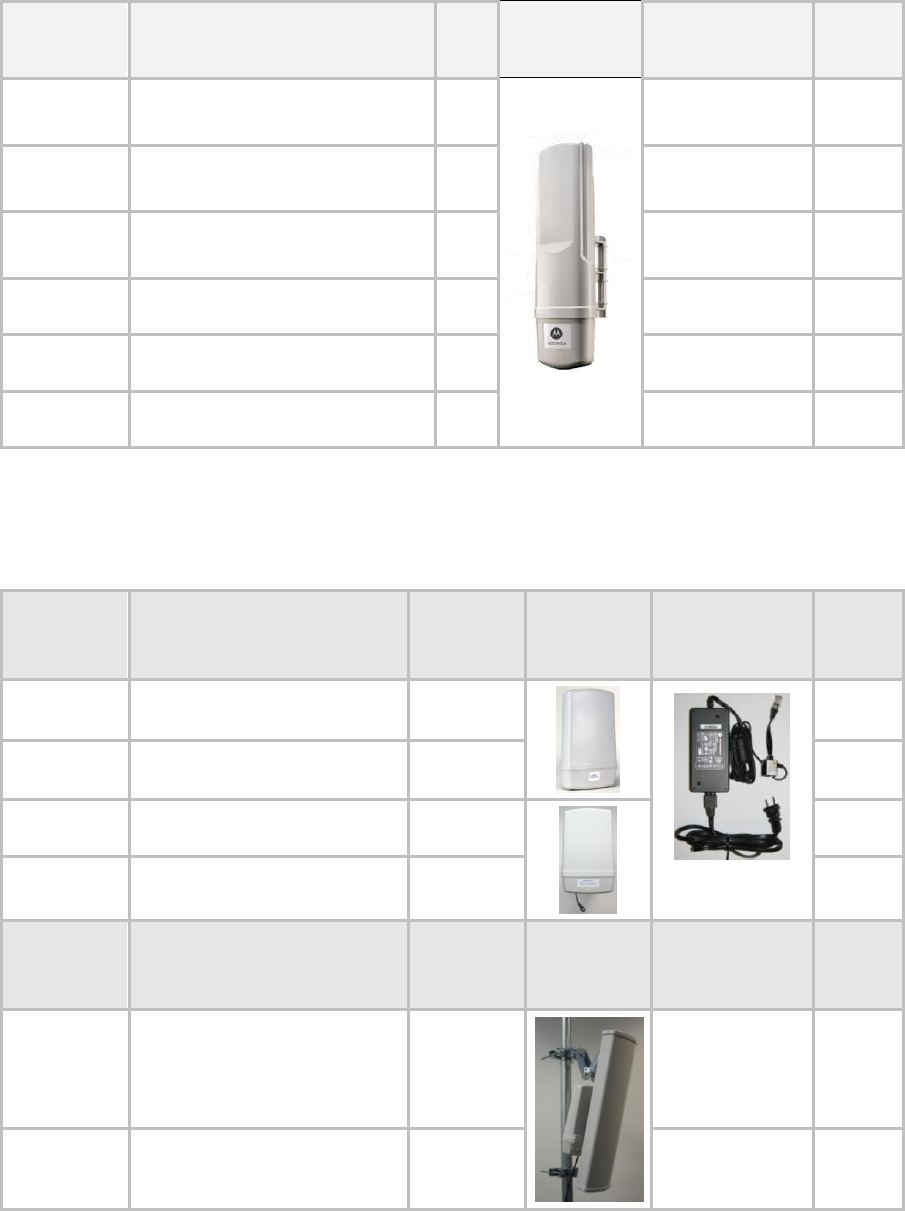
PMP 400/430 and PTP 200/230 Series Motorola PMP Solutions User Guide Supplement
Issue 6.0 May 2011 Page 16 of 77
PTP 54230
Model
Number
5.4 GHz OFDM Backhaul (BH)
Description
DES
or
AES
Picture
CMM Type
Specs
in
Section
5480BH10
5.4 GHz OFDM BH – 10 Mbps
DES
Requires CMM4
w/56 VDC supply
2.6.6
5480BH20
5.4 GHz OFDM BH – 20 Mbps
DES
Requires CMM4
w/56 VDC supply
2.6.6
5480BH50
5.4 GHz OFDM BH – Uncapped
DES
Requires CMM4
w/56 VDC supply
2.6.6
5481BH10
5.4 GHz OFDM BH – 10 Mbps
AES
Requires CMM4
w/56 VDC supply
2.6.6
5481BH20
5.4 GHz OFDM BH – 20 Mbps
AES
Requires CMM4
w/56 VDC supply
2.6.6
5481BH50
5.4 GHz OFDM BH – Uncapped
AES
Requires 56 VDC
supply
2.6.6
Table 5 shows the Motorola PMP 400 and PTP 200 Series (4.9 GHz OFDM) AP, SM and BH
models.
Table 5: 4.9GHz OFDM - PMP 400 and PTP 200 Model Number Descriptions
CSM 49400
Model
Number
4.9 GHz OFDM Subscriber
Module (SM) Description
Encryption
Picture
Power 56 VDC
Supply Type
Specs
in
Section
4940SM
4.9 GHz OFDM SM
DES
Refer to Table 7
for Models
2.6.3
4941SM
4.9 GHz OFDM SM
AES
2.6.3
4940SMC
4.9 GHz OFDM Connectorized
SM
DES
2.6.4
4941SMC
4.9 GHz OFDM Connectorized
SM
AES
2.6.4
CAP 49400
Model
Number
4.9 GHz OFDM Access Point
(AP) Module Description
Encryption
Picture
Power 56 VDC
CMM Type
Specs
in
Section
4940AP
4.9 GHz OFDM Connectorized
AP w/antenna
DES
Requires CMM4
w/56 VDC supply
2.6.5
4941AP
4.9 GHz OFDM Connectorized
AP w/antenna
AES
Requires CMM4
w/56 VDC supply
2.6.5
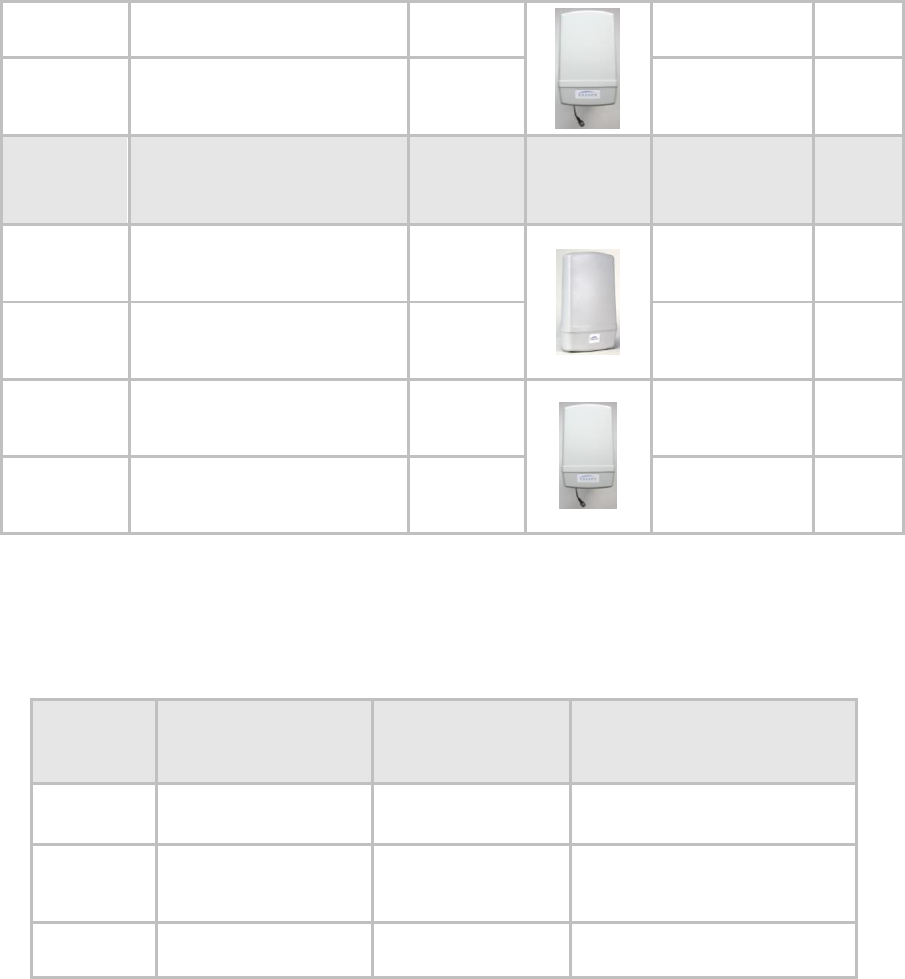
PMP 400/430 and PTP 200/230 Series Motorola PMP Solutions User Guide Supplement
Issue 6.0 May 2011 Page 17 of 77
4940APC
4.9 GHz OFDM Connectorized
AP – No antenna
DES
Requires CMM4
w/56 VDC supply
2.6.4
4941APC
4.9 GHz OFDM Connectorized
AP – No antenna
AES
Requires CMM4
w/56 VDC supply
2.6.4
PTP 49200
Model
Number
4.9 GHz OFDM Backhaul (BH)
Description
Encryption
Picture
Power 56 VDC
CMM Type
Specs
in
Section
4940BH
4.9 GHz OFDM BH
DES
Wall type 56VDC
supply or CMM4
w/56 VDC supply
2.6.3
4941BH
4.9 GHz OFDM BH
AES
Wall type 56VDC
supply or CMM4
w/56 VDC supply
2.6.3
4940BHC
4.9 GHz OFDM Connectorized
BH – No antenna
DES
Wall type 56VDC
supply or CMM4
w/56 VDC supply
2.6.4
4941BHC
4.9 GHz OFDM Connectorized
BH – No antenna
AES
Wall type 56VDC
supply or CMM4
w/56 VDC supply
2.6.4
A Cluster Management Module (CMM4) provides GPS synchronization and power to the PMP
400/430 and PTP 200/230 series of products: Table 6 details the power requirements of the APs
and BHs.
Table 6: CMM4 56VDC and 30 VDC Operation
Frequency
PMP Series
Access Point (AP)
PTP 230 Series
Backhaul (BH)
Canopy Custom
Power over Ethernet (PoE)
5.8 GHz
5.4 GHz
PMP 430 Series –
CAP 58430/54430
PTP 230 Series –
PTP 58230/54230
56 VDC - Power on pins 5 &
8, return on pins 4 & 7
5.4 GHz
PMP 400 Series –
CAP 54400
PTP 200 Series –
PTP 54200
30 VDC - power on pins 7
and 8 and return on pins 4
and 5
4.9 GHz
PMP 400 Series –
CAP 49400
PTP 200 Series –
PTP 49200
56 VDC - Power on pins 5 &
8, return on pins 4 & 7
The CMM4 can be configured with either or both a 56VDC and a 30VDC external power supply
as shown in Figure 10 and Figure 11. The CMM4 must be used for 56 VDC operations which are
required for the PMP 430 5.4 and 5.8-GHz AP, PMP 400 4.9-GHz AP, PTP 200 4.9-GHz BH, and
PTP 230 5.4 and 5.8-GHz BH. The CMMmicro only supports 30 VDC operations.
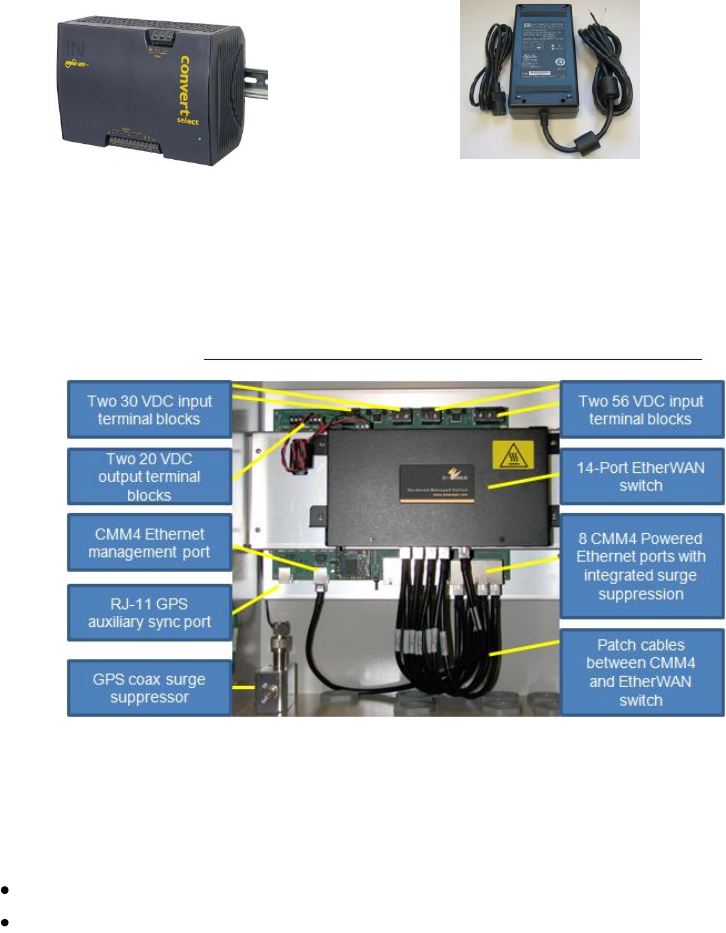
PMP 400/430 and PTP 200/230 Series Motorola PMP Solutions User Guide Supplement
Issue 6.0 May 2011 Page 18 of 77
Figure 10: CMM4 56 VDC Power Supply
Figure 11: CMMmicro and CMM4
30 VDC Power Supply
Shown in Figure 12 is a CMM4 with labels for the various parts. When using both a 56 VDC and
30 VDC power supply, it is necessary to install a resistor in the 30 VDC terminal blocks. Refer to
instructions included with the CMM4.
For details on configuring the CMM4, refer to the CMM4 User Guide which is available from the
Motorola support web site. http://motorola.wirelessbroadbandsupport.com/software/
Figure 12: CMM4 - 56 VDC and 30 VDC terminal blocks
A Cluster Management Module (CMMmicro) provides GPS synchronization and 30 VDC power to
the:
5.4-GHz PMP 400 Series - CAP 54400 uses 30 VDC
5.4-GHz PTP 200 Series - PTP 54200 uses 30 VDC
A 600SSD surge suppressor provides over-voltage and over-current protection to APs, SMs, and
BHs in various configurations. The diagram in Figure 13 illustrates the use of the 600SS surge
suppressor with the PMP 400/430 AP and SM.
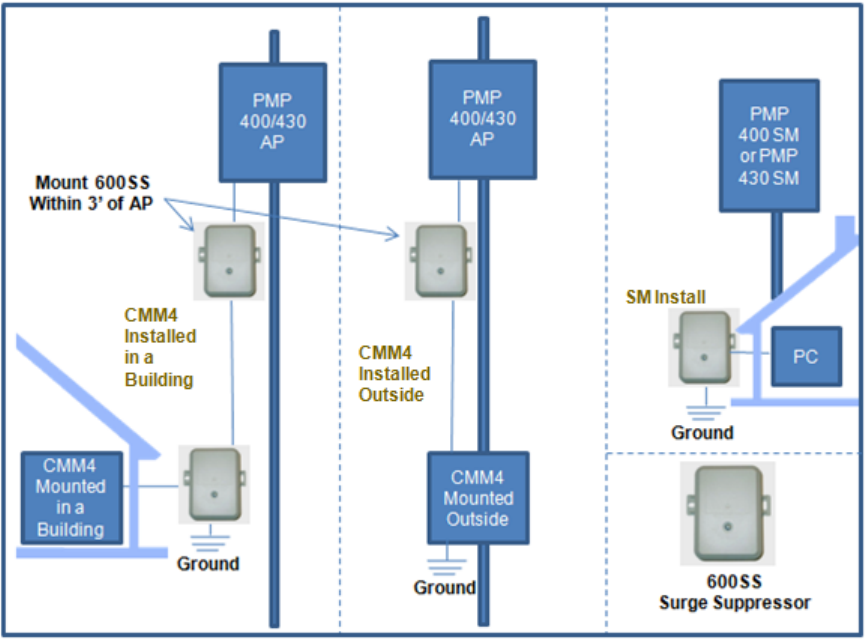
PMP 400/430 and PTP 200/230 Series Motorola PMP Solutions User Guide Supplement
Issue 6.0 May 2011 Page 19 of 77
Figure 13: 600SS Surge Suppression AP and SM diagram
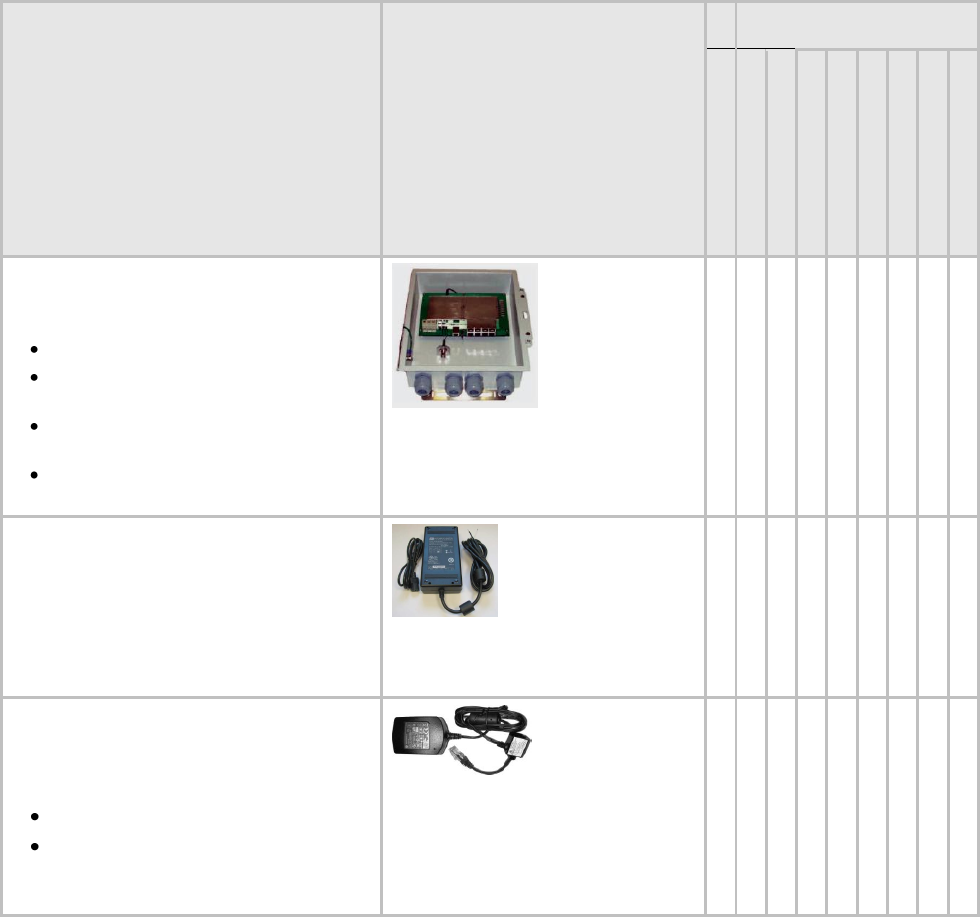
PMP 400/430 and PTP 200/230 Series Motorola PMP Solutions User Guide Supplement
Issue 6.0 May 2011 Page 20 of 77
Table 7 lists various ancillary equipment and model numbers.
Table 7: Ancillary Equipment and Model Numbers
Name
Model or Part Number
Typically use with
C
A
P
5
x
4
3
0
C
S
M
5
x
4
3
0
P
T
P
5
x
2
3
0
C
A
P
5
4
4
0
0
C
S
M
5
4
4
0
0
P
T
P
5
4
2
0
0
C
A
P
4
9
4
0
0
C
S
M
4
9
4
0
0
P
T
P
4
9
2
0
0
Cluster Management Module micro
(CMMmicro – 30 VDC power supply)
Controller and 8-port embedded switch
Outdoor enclosure for controller and
switch (but not power supply)
30 VDC power supply included with two
models (with 10 ft (3m) DC cable)
GPS antenna and mounting bracket
1070CK (with N. American AC cord
for power supply)
1070CK-02 (no AC cord)
1070CK-03 (no power supply)
X
X
CMMmicro or CMM4 30 VDC power supply
(w 10 ft (3 m) DC cable)
ACPS112WA (with N. American AC
cord for power supply)
APCS112W-02A (no AC cord)
X
X
PMP 400/430 5.8 & 5.4 GHz SM 29.5 VDC
power supply
(also for isolated 5.4GHz AP or BH)
Includes 6 ft (2m) DC cord
No AC cord needed (plugs directly
into AC receptacle)
ACPSSW-09B (US, UK, Euro clips)
ACPSSW-13B (N. America)
ACPSSW-10C (Argentina)
ACPWWS-11C (China)
ACPSSW-12A (Australia)
X
X
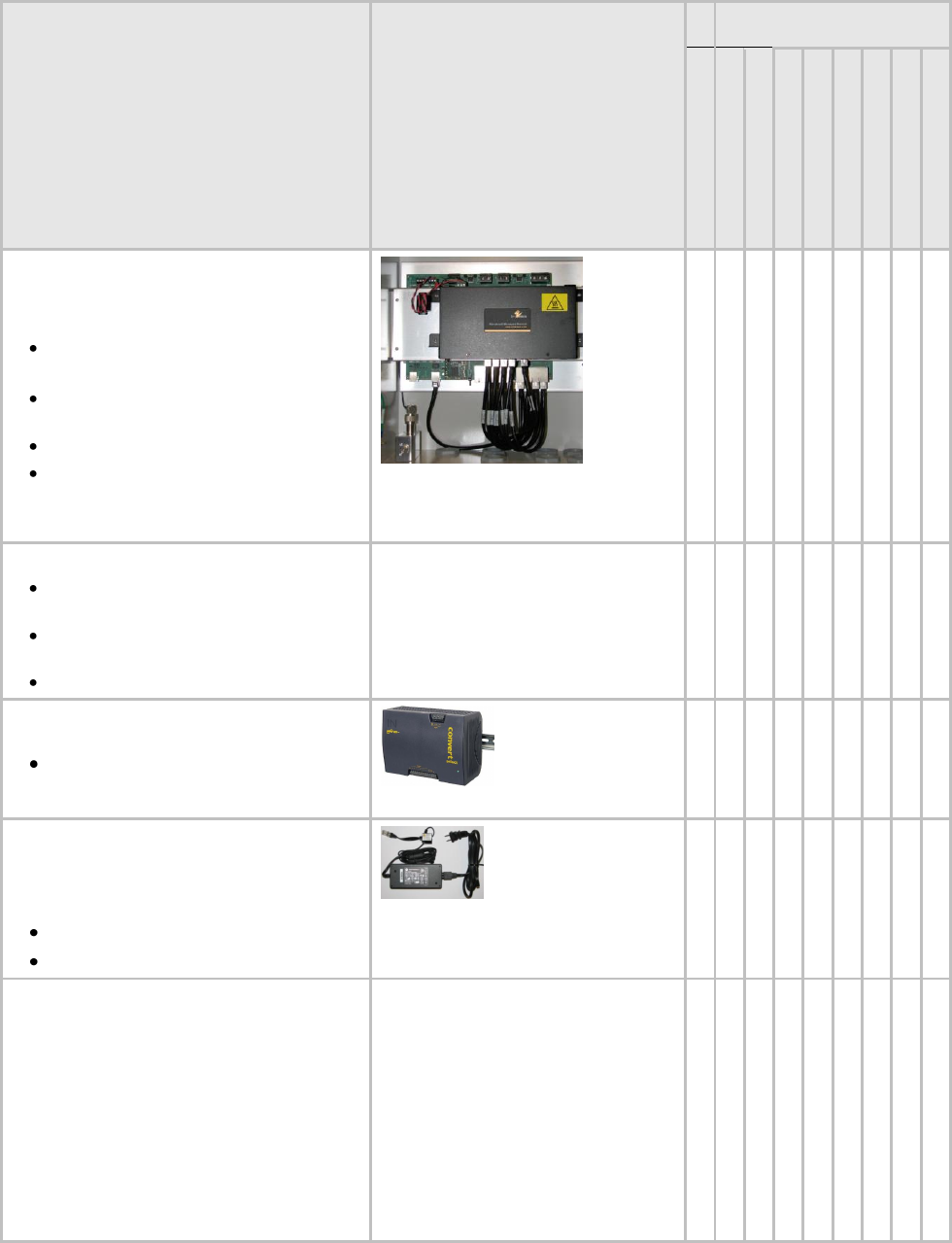
PMP 400/430 and PTP 200/230 Series Motorola PMP Solutions User Guide Supplement
Issue 6.0 May 2011 Page 21 of 77
Name
Model or Part Number
Typically use with
C
A
P
5
x
4
3
0
C
S
M
5
x
4
3
0
P
T
P
5
x
2
3
0
C
A
P
5
4
4
0
0
C
S
M
5
4
4
0
0
P
T
P
5
4
2
0
0
C
A
P
4
9
4
0
0
C
S
M
4
9
4
0
0
P
T
P
4
9
2
0
0
Cluster Management Module 4 (CMM4)
Controller and 14-port EtherWAN switch
(old version had 9-port EtherWAN switch)
Outdoor enclosure for controller and
switch (but not power supply)
No power supply
GPS antenna and mounting bracket
1090CK
Power supply is not included – Order
56 VDC and/or 30 VDC power supply
X
X
X
X
X
Cluster Management Module (CMM4)
Controller ONLY – Without EtherWAN
switch
Outdoor enclosure for controller
(but not power supply)
GPS antenna and mounting bracket
1091
Power supply is not included – Order
56 VDC and/or 30 VDC power supply
X
X
X
X
X
56 VDC power supply for CMM4
Does not include DC cable or AC line
cord – Procure locally
SGPN4076
X
X
X
PMP 400 4.9GHz SM 56 VDC power supply
(also for standalone use with PMP 430 5.4
and 5.8 GHz AP, PMP 400 4.9 GHz AP or
PTP 200 5.4 and 4.9 GHz BH)
Includes 6 ft (2m) DC cord
Requires country-specific AC cord
SGPN4063A
Power cord is not included - Order
country specific AC cord
X
4.9 GHz SM 56 VDC power supply AC cords
(also for standalone use with PMP 430 5.4
and 5.8 GHz AP, PMP 400 4.9 GHz AP or
PTP 200 5.4 and 4.9 GHz BH)
SGKN4427A (US/Canada/Mexico)
SGKN4426A (Europe)
SGKN4425A (Australia)
SGKN4424A (China-Mainland)
SGKN4423A (Japan)
SGKN4422A (Korea)
SGKN4421A (United
Kingdom/Singapore)
SGKN4420A (India/Pakistan/South Africa)
SGKN4419A (Argentina)
X
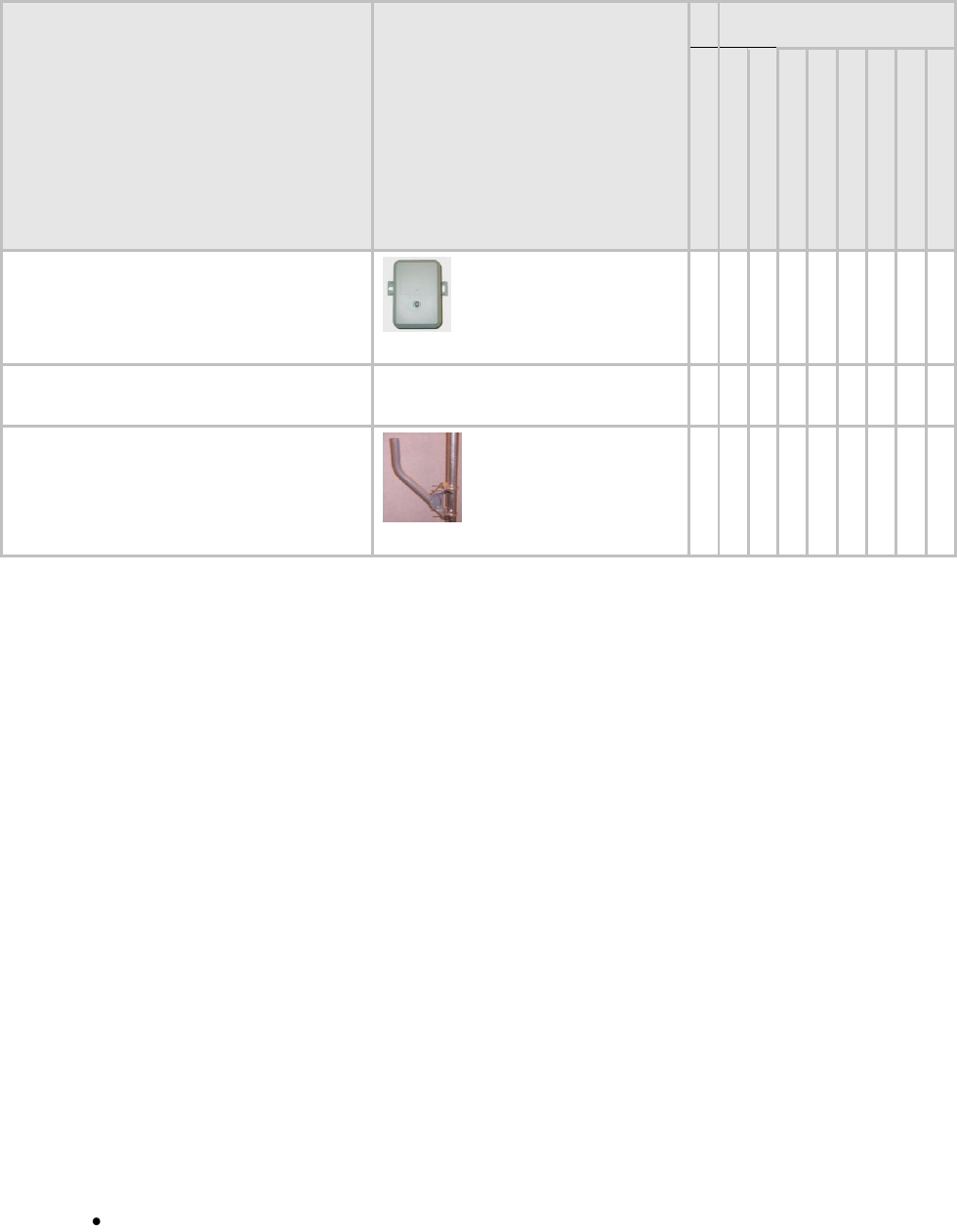
PMP 400/430 and PTP 200/230 Series Motorola PMP Solutions User Guide Supplement
Issue 6.0 May 2011 Page 22 of 77
Name
Model or Part Number
Typically use with
C
A
P
5
x
4
3
0
C
S
M
5
x
4
3
0
P
T
P
5
x
2
3
0
C
A
P
5
4
4
0
0
C
S
M
5
4
4
0
0
P
T
P
5
4
2
0
0
C
A
P
4
9
4
0
0
C
S
M
4
9
4
0
0
P
T
P
4
9
2
0
0
Surge suppressor (AP, SM, BH)
600SSD
X
X
X
X
X
X
X
X
X
Surge suppressor pole-mount kit
Refer to Figure 16 on page 25
SGHN5169A
X
X
X
X
X
X
Radio mounting bracket
SMMB2A
X
X
X
X
X
2.1 TECHNOLOGY AND BENEFITS
The radio automatically selects QPSK (Quadrature Phase Shift Keying), 16-QAM (Quadrature
Amplitude Modulation), or 64-QAM based on RF environment to provide 1X, 2X, and 3X
operation, respectively. This provides 3 speeds and a throughput of over 45 Mbps aggregate
(sum of up plus down when configured for 20MHz channel bandwidth) compared to FSK Canopy
products with 2 speeds and a throughput of up to 14 Mbps.
The OFDM radios feature lower receive sensitivity, FEC (Forward Error Correction), and higher
antenna gain, all of which combine to provide longer range within regulatory-specified EIRP
(Equivalent Isotropic Radiated Power).
Details on performance are listed in Table 8 on page 32.
The PMP 400 and PTP 200 Series radios use an OFDM physical layer with 10 MHz channels and
256 sub-carriers while the PMP 430 Series radios use an OFDM physical layer with configurable
channel bandwidth of 5, 10 or 20MHz. The PTP 230 Series radios use an OFDM physical layer
with configurable channel bandwidth of 10 or 20 MHz. A PMP 400 Series 5.4-GHz radio with
10MHz channels will interoperate with a PMP 430 Series 5.4-GHz radio configured with 10MHz
channel bandwidth and 1/4 cyclic prefix. However; due to the different carrier and modulation
schemes between these OFDM radios and FSK Canopy radios, the two do not interoperate over
the air. For example, a PMP 430/400 Series 5.4-GHz OFDM SM cannot connect to a 5.4-GHz
FSK AP.
2.1.1 nLOS Benefits and Limitations
In addition to providing LOS (Line-of-Sight) connectivity, use of OFDM technology can provide
nLOS (near Line-of-Sight) connectivity and sometimes NLOS (Non-Line-of-Sight) connectivity:
LOS: the installer can see the AP from the SM and the first Fresnel zone is clear.
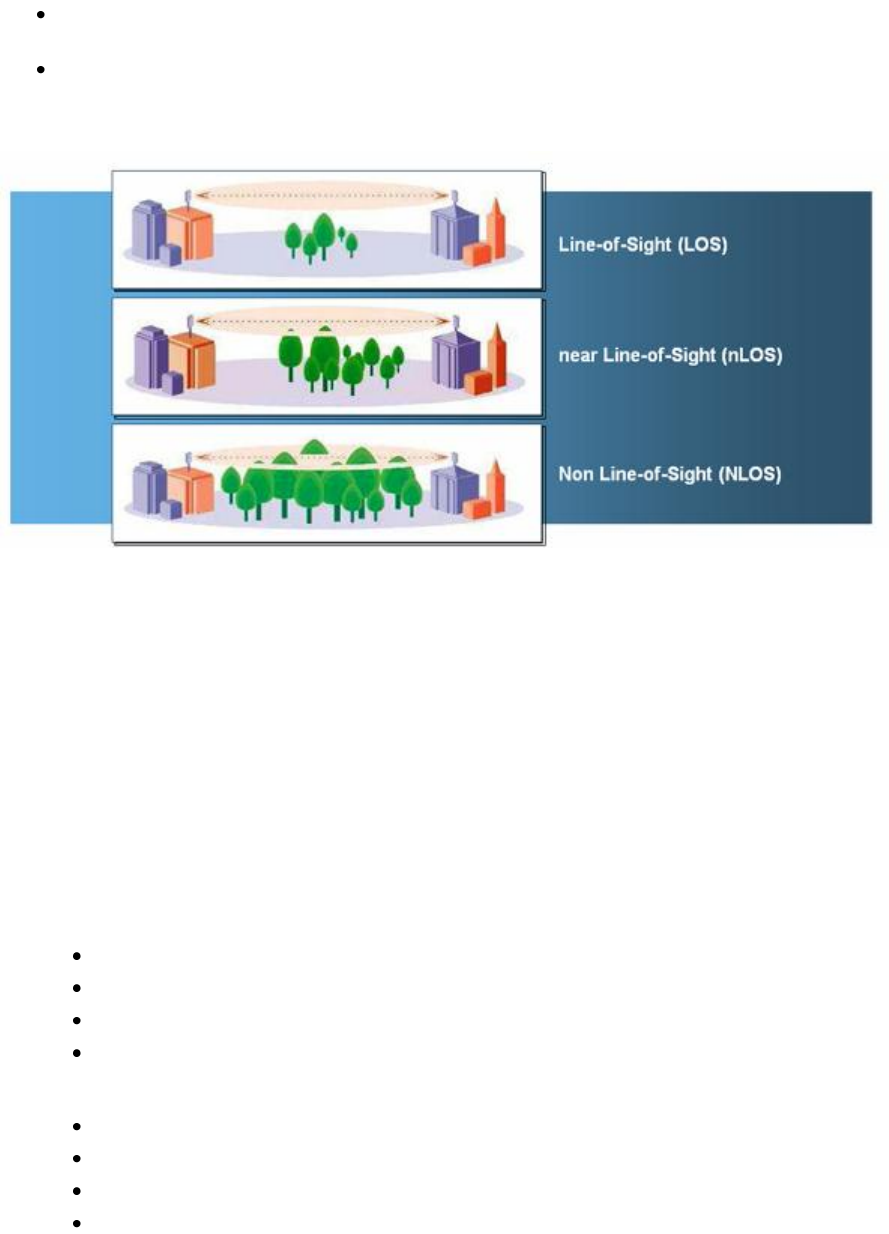
PMP 400/430 and PTP 200/230 Series Motorola PMP Solutions User Guide Supplement
Issue 6.0 May 2011 Page 23 of 77
nLOS: the installer can see the AP from the SM, but a portion of the first Fresnel zone is
blocked.
NLOS: the installer cannot see the AP from the SM and a portion or even much of the
first Fresnel zone is blocked, but subsequent Fresnel zones are open.
Figure 14 shows examples of LOS, nLOS, and NLOS links.
Figure 14: LOS, nLOS, and NLOS
Whereas multi-pathing degrades a link in some technologies (FSK, for example), OFDM can
often use multi-pathing to an advantage to overcome nLOS, especially in cases where the
Fresnel zone is only partially blocked by buildings, “urban canyons”, or foliage. OFDM tends to
help especially when obstacles are near the middle of the link, and less so when the obstacles
are very near the SM, AP, or BH.
However, attenuation through walls and trees is substantial for any use of the 5.8 GHz, 5.4 GHz
or 4.9 GHz frequency bands. Even with OFDM, these products should not be expected to
penetrate walls or extensive trees and foliage.
2.2 APPLICATIONS
Applications for the PMP 400/PTP 200 (5.4-GHz) and PMP 430/PTP 230 (5.4 & 5.8-GHz) Series
include:
High throughput enterprise applications
nLOS video surveillance in metro areas
Extend networks into urban areas
Extend networks into areas with foliage
Applications for the PMP 49400 (4.9-GHz) and PTP 49200 Series systems include:
High throughput licensed network for government applications
Municipal network - nLOS video surveillance in metro areas
Disaster relief network
Data service network - extend licensed networks into areas with foliage

PMP 400/430 and PTP 200/230 Series Motorola PMP Solutions User Guide Supplement
Issue 6.0 May 2011 Page 24 of 77
2.3 CONFIGURATION OPTIONS – RF, IP, DFS
These systems use the Canopy Media Access Controller (MAC) layer. Settings like Downlink
Data %, Range, and Control Slots are similar to Canopy FSK radios. An OFDM AP can
communicate to over 200 SMs, similar to a Canopy FSK AP.
The GUI (Graphical User Interface) is almost identical to Canopy’s FSK products, with a few
additions to support OFDM-specific features.
Network features like High Priority using DiffServ, MIR, CIR, NAT, DHCP and VLAN are available
for the PMP 400/430 and PTP 200/230 Series OFDM radios, and are configured in the same way
as they are for the PMP 100 Series and PTP 100 Series radios.
In the 5.4 and 5.8-GHz band, DFS (Dynamic Frequency Selection) is provided for regulatory
compliant operation, and is activated (if required per regulatory rules) using the “Region Code”
feature. Two alternate frequencies can be configured to provide service in the unlikely case a
module detects radar and triggers DFS, the same as standard Canopy. “External Antenna Gain”
may need to be configured consistent with any antennas used, to avoid making the system overly
sensitive to radar detection. “Whitening,” a technique used to avoid self-interference on Canopy
FSK radios, is not offered as an option on the PMP 400/430 and PTP 200/230 Series radios, as
whitening is not a technology applicable to an OFDM signal.
2.4 POWER AND GROUNDING
PMP 430 Series APs and PTP 230 BHs use a nominal 56 VDC power system with power on pins
5 and 8 and return on pins 4 and 7. PMP 430 Series APs must use a CMM4 with a 56 VDC
power supply. A CMMmicro will not power these units as it is providing the wrong voltage on the
wrong pins. PMP 430 Series SMs use a 29.5 VDC wall mount power supply.
PMP 54400 APs and SMs and PTP 54200 BHs use a nominal 30 VDC power system with power
on pins 7 and 8 and return on pins 4 and 5. PMP 54400 APs and PTP 54200 BHs can be
powered from either a CMMmicro with a 30 VDC power supply or a CMM4 with a 30 VDC power
supply. A 29.5 VDC wall mount power supply is available for PMP 54400 SMs.
PMP 49400 APs and SMs and PTP 49200 BHs use a nominal 56 VDC power system with power
on pins 5 and 8 and return on pins 4 and 7. PMP 49400 APs and PTP 49200 BHs must use a
CMM4 with a 56 VDC power supply. A CMMmicro will not power these units as it is providing the
wrong voltage on the wrong pins. A 56 VDC power supply is available for PMP 49400 SMs.
IMPORTANT!
When working on sites with both power systems, use care not to wrongly
mix power supplies and radios as the two power systems use different
pinouts as well as different voltages.
On sites with a mix of 30 VDC and 56 VDC radios (up to the limit of 8 radios supported by one
CMM4), a CMM4 connected to both a 30 VDC power supply and a 56 VDC power supply can be
used.
Due to the full metallic connection to the tower or support structure through the AP’s antenna or a
connectorized BH’s antenna, grounding the AP or BH and installing a 600SS surge suppressor
within 3 ft (1 m) of the AP or BH (see Figure 13) is strongly recommended to suppress over
voltages and over currents, such as those caused by near-miss lightning. APs and BHs provide a
grounding lug, as shown in Figure 15, for grounding to the tower or support structure.
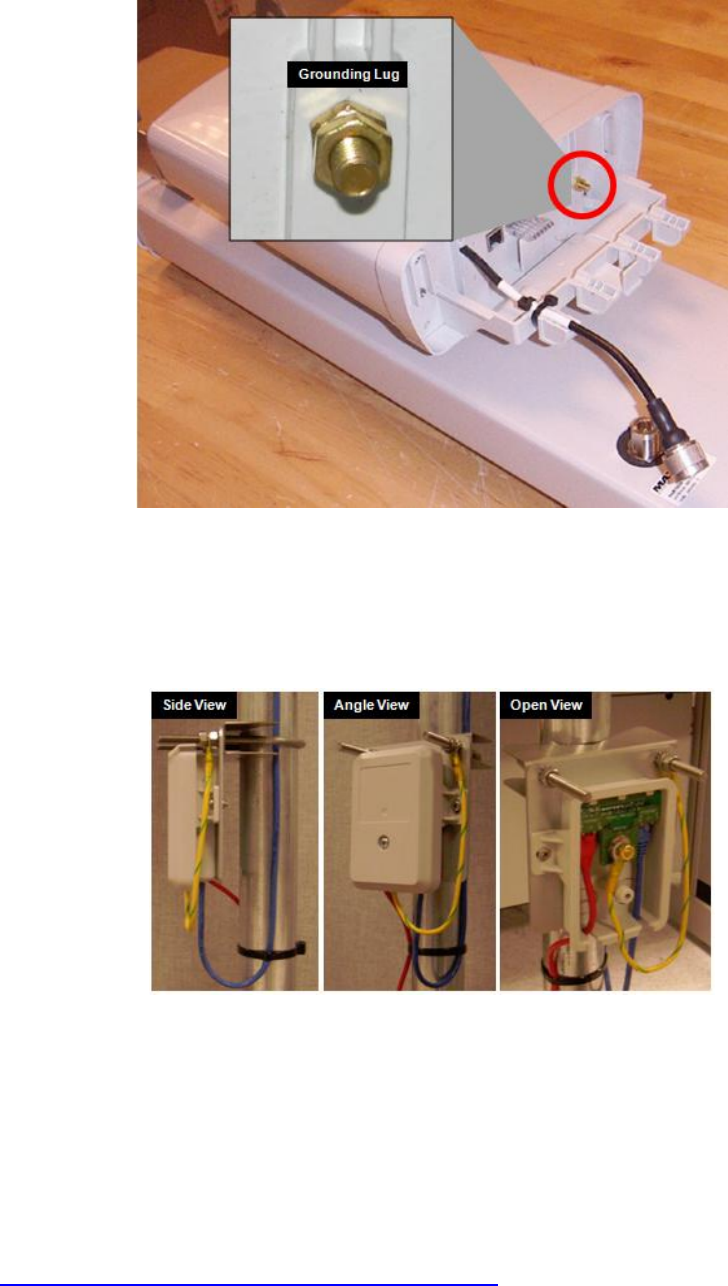
PMP 400/430 and PTP 200/230 Series Motorola PMP Solutions User Guide Supplement
Issue 6.0 May 2011 Page 25 of 77
Figure 15: AP Grounding Lug
A pole mount kit (model no. SGHN5169A) is available for the 600SS. The pole mount kit, shown
in Figure 16, provides a grounding point on one of its U-bolts that can be used for terminating
ground straps from both the 600SS and the AP.
Figure 16: 600SS pole mount kit
2.5 ADMINISTRATION SYSTEMS
Motorola Prizm 3.3 or One Point Wireless Manager v3.0 SP 1 is recommended for managing
PMP 400/430 and PTP 200 Series products with Release 11.0.1 and PTP 230 Series products
with Release 10.7.
Motorola Prizm 3.3 is available for download from the Motorola support web site:
http://motorola.wirelessbroadbandsupport.com/software/

PMP 400/430 and PTP 200/230 Series Motorola PMP Solutions User Guide Supplement
Issue 6.0 May 2011 Page 26 of 77
Motorola One Point Wireless Manager v3.0 SP 1 is available for download at:
http://motorola.wirelessbroadbandsupport.com/support/opws/software/
The Motorola Prizm 3.3 element management system is used to manage and monitor Canopy
modules and to update module software.
The One Point Wireless Manager v3.0 SP 1 is used to manage and monitor Canopy modules.
However; the standalone CNUT tool must be used to upgrade radio software.
CNUT 3.20.18 (Canopy Network Update Tool) is the stand-alone software update tool for PMP
400/430 and PTP 200/230 Series products for operators not using Prizm. CNUT is available at
http://motorola.wirelessbroadbandsupport.com/software/.
2.6 SPECIFICATIONS
PMP 430 (5.4 and 5.8-GHz) products are sold in the following formats:
SM - Radio with integrated antenna
AP - Kitted, connectorized radio (antenna included)
AP – Connectorized radio (antenna provided by operator)
PMP 400 (5.4 and 4.9-GHz) and PTP 200 (5.4 and 4.9-GHz) products are sold in the following
formats:
SM/BH - Radio with integrated antenna
AP/SM/BH - Connectorized radio (antenna provided by operator)
AP - Kitted, connectorized radio (antenna included)
PTP 230 (5.4 and 5.8-GHz) products are sold in the following format:
SM/BH - Radio with integrated antenna
The following sections list specifications for each format.
2.6.1 Radio specifications (common to all formats)
Radio Type
Frequency
Settable Transmit (Tx) Output Power Range by Channel Bandwidth
5 MHz
10 MHz
20 MHz
PMP 430 AP
and
PTP 230 BH
5.8 GHz
-30 to +21 dBm
-30 to +21 dBm
-30 to +21 dBm
PMP 430 AP
and
PTP 230 BH
5.4 GHz
-30 to +21 dBm
-30 to +21 dBm
-30 to +21 dBm
PMP 400 AP
and
PTP 200 BH
5.4 GHz
N/A
-30 to +12 dBm
N/A
PMP 400 AP
and
PTP 200 BH
4.9 GHz
N/A
-30 to +18 dBm
N/A

PMP 400/430 and PTP 200/230 Series Motorola PMP Solutions User Guide Supplement
Issue 6.0 May 2011 Page 27 of 77
SM
4.9, 5.4
and 5.8-
GHz
SM Auto Transmit Power Control (TPC) with power set by the AP to
provide power leveling for close-in SMs
PMP 430 AP/SM: configurable channel bandwidth: 5, 10 or 20MHz
PMP 430 AP/SM: configurable cyclic prefix (1/4, 1/8 or 1/16)
PMP 430 AP: Max range 1-30 miles for 5 and 10MHz channel bandwidth, 1-24 miles for
20MHz channel bandwidth
PMP 400 AP: Max range 1-30 miles
PMP 400 AP/SM and PTP 200 BH: channel bandwidth fixed at 10MHz
PMP 400 AP/SM: cyclic prefix fixed at 1/4
PTP 200 BH: configurable cyclic prefix (1/4 or 1/8)
PTP 230 BH: configurable channel bandwidth: 10 or 20MHz
PTP 230 BH: configurable cyclic prefix (1/4, 1/8 or 1/16)
PTP 230 BH: Max range 1-30 miles for 10MHz channel bandwidth, 1-24 miles for 20MHz
channel bandwidth
Under 22 W DC power
Environment range of -40°C to +55°C (-40°F to +131°F); 0 to 95% relative humidity, non-
condensing
PMP 400/430 and PTP 200/230 products are available with either DES or AES
encryption
2.6.2 Specifications for PMP 430 (5.4 & 5.8-GHz) SM and PTP 230 (5.4 & 5.8-GHz)
BH radio with integrated antenna
Radio with an integrated, internal vertically polarized antenna
1 lb, 11.75 x 3.4 x 3.4 in (hwd) or ~.45 kg, 29.9 x 8.6 x 8.6 cm (hwd)
PMP 430 Configurable channel bandwidth: 5, 10 or 20MHz
PTP 230 Configurable channel bandwidth: 10 or 20MHz
Configurable cyclic prefix: 1/4, 1/8 or 1/16
10 dBi patch antenna - 55° x 55° and 3 dB beam width
Optional LENS mounts directly to SM or BH– No additional mounting hardware required
o adds 6 dBi to 10 dB internal patch antenna which can increase range
o narrows beam width by 3x (from 55° to 18°) which can reduce interference
caused by multi-path reflections
o LENS part number: AN500A
Optional Reflector dish
o adds 15 dBi to 10 dB internal patch antenna which can increase range
o narrows beam width (from 55° to 6°) which can reduce interference caused by
multi-path reflections
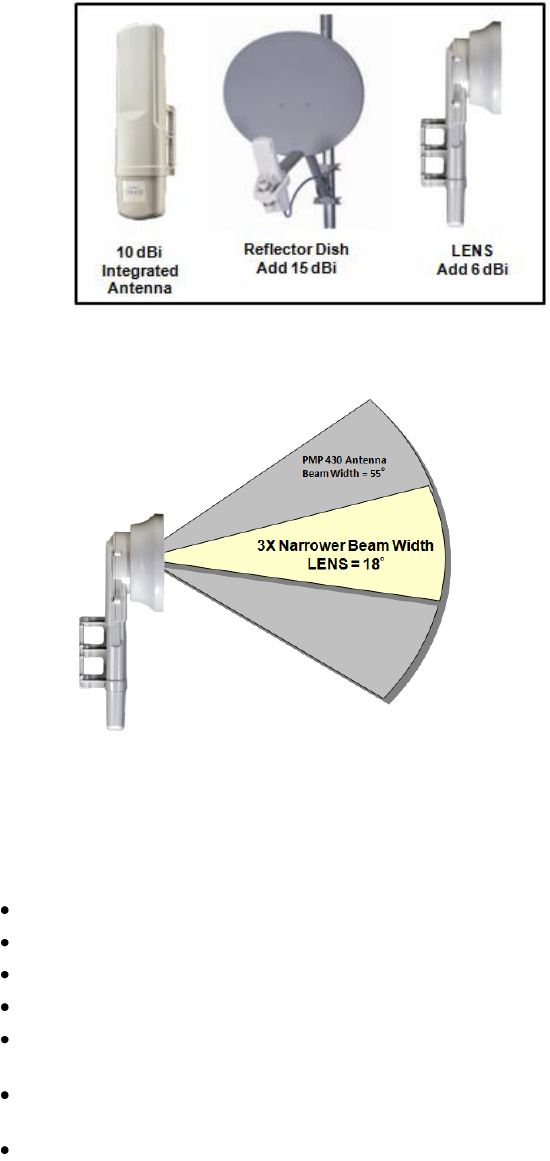
PMP 400/430 and PTP 200/230 Series Motorola PMP Solutions User Guide Supplement
Issue 6.0 May 2011 Page 28 of 77
Figure 17: PMP 430 SM
Figure 18: PMP 430 SM with Optional LENS
2.6.3 Specifications for PMP 400 (4.9 & 5.4-GHz) AP/SM and PTP 200 (4.9 & 5.4-
GHz) BH radio with integrated antenna
Radio with an integrated, internal vertically polarized antenna
10MHz channel bandwidth
1/4 Cyclic Prefix
15.5° elevation x 17.5° azimuth -- 3 dB beam
17 dBi gain for antenna at 5.4 GHz. 17 dBi antenna gain plus 10 dBm transmit power
gives the regulatory maximum of 27 dBm EIRP.
17 dBi gain for antenna at 4.9 GHz. 17 dBi antenna gain plus 18 dBm transmit power
gives 35 dBm EIRP.
2.8 lb, 13.25 x 8.25 x 4.38 in (hwd) or ~1.3 kg, 33.7 x 21 x 11.13 cm (hwd)
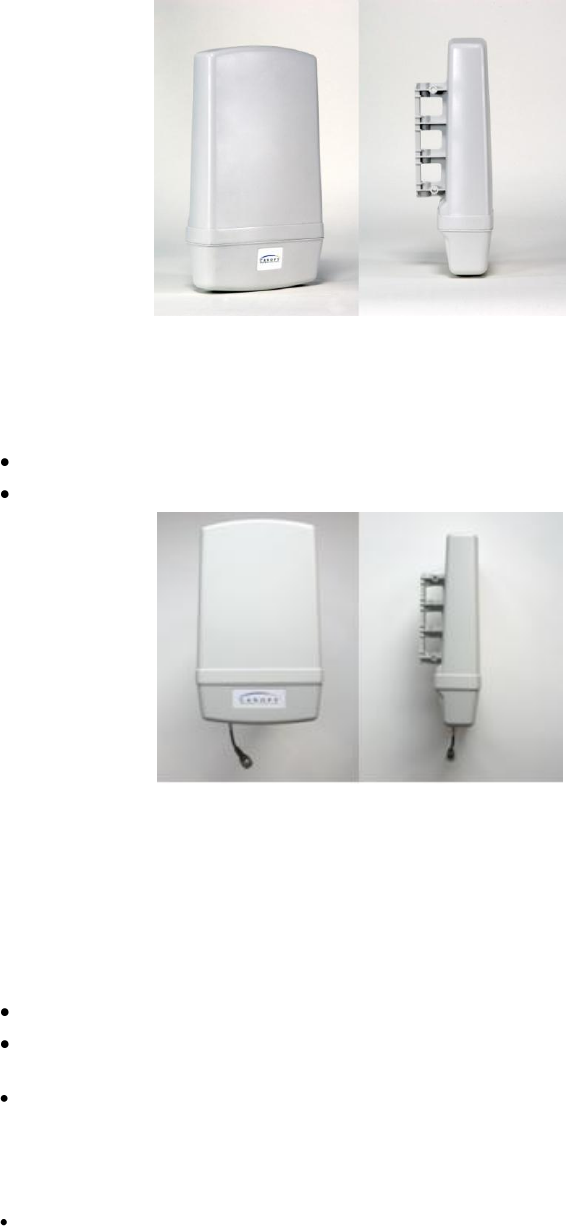
PMP 400/430 and PTP 200/230 Series Motorola PMP Solutions User Guide Supplement
Issue 6.0 May 2011 Page 29 of 77
Figure 19: PMP 400 and PTP 200 radio with integrated antenna
2.6.4 Specification for PMP 400/430 AP and PTP 200 BH connectorized radio
Connectorized radio only with N-type connector (antenna to be provided by operator)
2.8 lb, 13.25 x 8.25 x 4.38 in (hwd) or ~1.3 kg, 33.7 x 21 x 11.13 cm (hwd)
Figure 20: PMP 400/430 and PTP 200 BH connectorized radio
2.6.5 Specifications for PMP 400/430 kitted, connectorized radio (antenna included)
Connectorized radio (N-type connector) and connectorized antenna kitted together
Antenna optimized for system coverage vs. system self-interference for 90° sectors (3
dB beam pattern of 60° azimuth by 5° elevation, with near-in null fill)
5.8 GHz - 18 dBi gain for antenna. 18 dBi antenna gain minus 1 dB cable loss plus:
19 dBm tx power gives the U.S. regulatory max 36 dBm EIRP (5, 10 or 20 MHz Channel)
13 dBm tx power gives the Europe regulatory max 30 dBm EIRP. (5MHz Channel)
16 dBm tx power gives the Europe regulatory max 33 dBm EIRP. (10MHz Channel)
19 dBm tx power gives the Europe regulatory max 36 dBm EIRP. (20MHz Channel)
5.4 GHz - 18 dBi gain for antenna. 18 dBi antenna gain minus 1 dB cable loss plus:
7 dBm tx power gives the U.S./Europe regulatory max 24 dBm EIRP. (5MHz Channel)
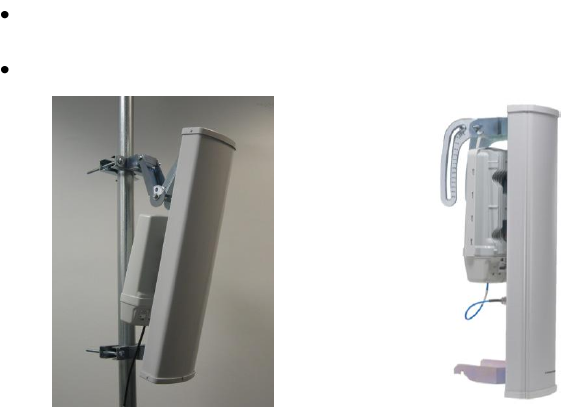
PMP 400/430 and PTP 200/230 Series Motorola PMP Solutions User Guide Supplement
Issue 6.0 May 2011 Page 30 of 77
10 dBm tx power gives the U.S./Europe regulatory max 27 dBm EIRP. (10MHz Channel)
13 dBm tx power gives the U.S./Europe regulatory max 30 dBm EIRP. (20MHz Channel)
4.9 GHz - 17 dBi gain for antenna. 17 dBi antenna gain plus 18 dBm tx power gives
35 dBm EIRP.
13 lb, 28 x 8.25 x 11 in (hwd) or ~6 kg, 71 x 21 x 28 cm (hwd)
Figure 21: CAP 49400
Figure 22: CAP 58430 and 54430

PMP 400/430 and PTP 200/230 Series Motorola PMP Solutions User Guide Supplement
Issue 6.0 May 2011 Page 32 of 77
Table 8: Performance Details
Product
Parameter
Performance Details
1X
2X
3X
PMP 58430
5.8 GHz
OFDM
and
PMP 54430
5.4-GHz
OFDM
Modulation
QPSK
16 QAM
64 QAM
5.8-GHz Max.
LOS Range
with Integrated SM antenna
6.4 miles /
10.24 km
5 miles /
8 km
2.3 miles /
3.68 km
with LENS that adds 6 dB to
SM Range
13 miles /
20.8 km
10 miles /
16 km
4.5 miles /
7.2 km
with Reflector Dish that adds
15 dB to SM Range
30 miles /
48 km
29 miles /
46.4 km
13 miles /
20.8 km
5.4-GHz Max.
LOS Range
with Integrated SM antenna
3.4 miles /
5.44 km
2.7 miles /
4.32 km
1.2 miles /
1.92 km
with LENS that adds 6 dB to
SM Range
6.8 miles /
10.88 km
5.4 miles /
8.64 km
2.4 miles /
3.84 km
with Reflector Dish that adds
15 dB to SM Range
7.6 miles /
12.16 km
6 miles /
9.6 km
2.7 miles /
4.32 km
5.4 and 5.8-GHz
Max. Aggregate
Throughput with
1/16 Cyclic
Prefix
5MHz Channel: (up+down)
3.5 Mbps
7 Mbps
10.5 Mbps
10 MHz Channel: (up+down)
7.5 Mbps
15 Mbps
22.5 Mbps
20 MHz Channel: (up+down)
16.5 Mbps
32 Mbps
45+ Mbps
5.4 and 5.8-GHz
Nominal Receive
Sensitivity
(including FEC)
5MHz Channel
-93 dBm
-86 dBm
-79 dBm
10MHz Channel
-90 dBm
-83 dBm
-76 dBm
20MHz Channel
-87 dBm
-80 dBm
-73 dBm
PTP 58230
5.8 GHz
OFDM
and
PTP 54230
5.4-GHz
OFDM
Modulation
QPSK
16 QAM
64 QAM
5.8-GHz Max.
LOS Range
with Integrated BH antenna
6.4 miles /
10.24 km
5 miles /
8 km
2.3 miles /
3.68 km
with LENS that adds 6 dB to
BHRange
13 miles /
20.8 km
10 miles /
16 km
4.5 miles /
7.2 km
with Reflector Dish that adds
15 dB to BH Range
30 miles /
48 km
29 miles /
46.4 km
13 miles /
20.8 km
5.4-GHz Max.
LOS Range
with Integrated BH antenna
3.4 miles /
5.44 km
2.7 miles /
4.32 km
1.2 miles /
1.92 km
with LENS that adds 6 dB to
BH Range
6.8 miles /
10.88 km
5.4 miles /
8.64 km
2.4 miles /
3.84 km
with Reflector Dish that adds
15 dB to BH Range
7.6 miles /
12.16 km
6 miles /
9.6 km
2.7 miles /
4.32 km
5.4 and 5.8-GHz
Max. Aggregate
Throughput with
1/16 Cyclic
Prefix
10 MHz Channel: (up+down)
7.5 Mbps
15 Mbps
23 Mbps
20 MHz Channel: (up+down)
17 Mbps
34 Mbps
50 Mbps
5.4 and 5.8-GHz
Nominal Receive
Sensitivity
(including FEC)
10MHz Channel
-90 dBm
-83 dBm
-76 dBm
20MHz Channel
-87 dBm
-80 dBm
-73 dBm

PMP 400/430 and PTP 200/230 Series Motorola PMP Solutions User Guide Supplement
Issue 6.0 May 2011 Page 33 of 77
PMP 54400
PTP 54200
5.4 GHz
OFDM
Modulation
QPSK
16 QAM
64 QAM
Maximum LOS Range with integrated SM antenna
Note: LENS and Reflector cannot be used.
5 miles /
8 km
3.4 miles /
5.5 km
1.4 miles/
2.25 km
10 MHz Channel: (up+down)
Max. Aggregate Throughput with 1/4 cyclic prefix
7.5 Mbps
14 Mbps
PMP: 20.3
Mbps
PTP: 21
Mbps
Nominal Receive Sensitivity (including FEC)
-89 dBm
-78 dBm
-70 dBm
PMP 49400
PTP 49200
4.9 GHz
OFDM
Modulation
QPSK
16 QAM
64 QAM
Maximum LOS Range with integrated SM antenna
Note: LENS and Reflector cannot be used.
10 miles /
16 km
4 miles /
6.4 km
1.4 miles /
2.25 km
10 MHz Channel: (up+down)
Max. Aggregate Throughput with 1/4 cyclic prefix
7.5 Mbps
14 Mbps
20.3 Mbps
Nominal Receive Sensitivity (including FEC)
-89 dBm
-78 dBm
-70 dBm

PMP 400/430 and PTP 200/230 Series Motorola PMP Solutions User Guide Supplement
Issue 6.0 May 2011 Page 34 of 77
3 Planning
PMP 400 and PTP 200 Series systems use 10 MHz channel bandwidth configurable on 5 MHz
channel centers while the PMP 430 Series is configurable with a 5, 10 or 20 MHz channel
bandwidth and the PTP 230 Series is configurable with a 10 or 20 MHz channel bandwidth. When
a PMP 430 is configured with 5 MHz channel bandwidth, the radio is configurable on 2.5 MHz
center channels and is configurable on 5 MHz center channels when it is configured for either 10
or 20 MHz channel bandwidth.
This channel size, along with some different characteristics due to the use OFDM carrier
technology and QPSK, 16 QAM, or 64 QAM modulations, supports somewhat different channel
planning than for standard Canopy. (For reference, PMP 100 Series uses 20 MHz channels
configurable on 5 MHz centers, single carrier technology, and 2-level and 4-level FSK
modulation.)
3.1 TOWER CHANNEL PLANNING
For a single cluster of 4 APs on a tower, 2-channel re-use with channels on 10 MHz channel
center spacing gives good performance. In channel design parlance, this can be stated as ABAB
channel planning, with no guard band needed between A and B. A typical arrangement might be
to use radios configured for 5480 MHz aimed north and south, and radios configured for 5490
MHz aimed east and west.
Available 5.8 GHz channel center frequencies for each region are shown in Table 9. These vary
by region due to different band edge RF specifications (for example, between Canada/US and
Europe).
Table 9: 5.8 GHz Channel Center Frequencies, by Region
Channel
Bandwidth
Region(s)
Range of Center
Frequencies
Available (MHz)
Center
Channel
Spacing
# of
center
channels
# of non-
overlapping
channels
5MHz
United States,
Canada, Australia,
Brazil and Russia
5727.5 –5845
2.5MHz
48
24
Europe and Other
5727.5 –5872.5
2.5MHz
59
30
India
5827.5 –5872.5
2.5MHz
19
10
10MHz
United States,
Canada, Australia,
Brazil and Russia
5730 – 5845
5MHz
24
12
Europe and Other
5730 – 5870
5MHz
29
15
India
5830 – 5870
5MHz
9
5
20MHz
United States,
Canada, Australia,
Brazil and Russia
5735 – 5840
5MHz
22
6
Europe and Other
5735 – 5865
5MHz
27
7
India
5835 – 5865
5MHz
7
2
20MHz FSK
(for
comparison)
United States,
Canada, Europe
and Australia
5735 – 5840
5MHz
22
6

PMP 400/430 and PTP 200/230 Series Motorola PMP Solutions User Guide Supplement
Issue 6.0 May 2011 Page 35 of 77
(For reference, standard Canopy uses 2-channel re-use with clusters of 6 APs on a tower with
channel center spacing of either 25 MHz for Advantage APs or 20 MHz for non-Advantage APs.
This is ABCABC channel planning, with 5 MHz guard band between the 20 MHz channels for
Advantage APs and no guard band needed for non-Advantage.)
Available 5.4 GHz channel center frequencies for each region are shown in Table 10. These vary
by region due to
different band edge RF specifications (for example, between Canada/US and Europe)
requirements in US, Canada, Europe and Australia to not impinge on the frequencies
between 5600 and 5650 MHz, which are frequencies on which some weather radar
operate
Table 10: 5.4 GHz Channel Center Frequencies, by Region
Channel
Bandwidth
Region(s)
Range of Center
Frequencies
Available (MHz)
Center
Channel
Spacing
# of
center
channels
# of non-
overlapping
channels
5MHz
United States,
Canada and
Australia
5475 – 5597.5 and
5652.5 – 5715
2.5MHz
76
38
Europe
5472.5 – 5597.5 and
5652.5 – 5717.5
2.5MHz
78
40
Brazil, India,
Russia and
Other
5475 –5715
2.5MHz
97
49
10MHz
United States,
Canada and
Australia
5480 – 5595 and
5655 – 5710
5MHz
36
18
Europe
5475 – 5595 and
5655 – 5715
5MHz
38
20
Brazil, India,
Russia and
Other
5480 – 5710
5MHz
47
24
20MHz
United States,
Canada and
Australia
5475 – 5590 and
5660 – 5705
5MHz
34
9
Europe
5470 – 5590 and
5660 – 5710
5MHz
36
9
Brazil, India,
Russia and
Other
5475 – 5705
5MHz
47
12
20MHz FSK
(for
comparison)
United States,
Canada,
Europe and
Australia
5495 – 5585 and
5665 – 5705
5MHz
28
8
Available 4.9 GHz channel center frequencies are shown in Table 11.

PMP 400/430 and PTP 200/230 Series Motorola PMP Solutions User Guide Supplement
Issue 6.0 May 2011 Page 36 of 77
Table 11: 4.9 GHz Channel Center Frequencies
Range of Center Frequencies Available (MHz)
(on 5 MHz centers within this range, inclusive)
Number of
center
channels
Maximum number of
non-overlapping
channels
4945 - 4985
9
5
The best practice for channel planning for APs is to conduct extensive site RF surveys before
choosing channels. The SM provides a basic Spectrum Analyzer that can be used for site
surveys. For more sophisticated analysis, consider consulting an experienced RF engineer and
using a full-featured spectrum analyzer.
3.2 DOWN TILT
The standard AP antenna produces a 3 db beam elevation (up and down) of 5°, with near-in null
fill that allows good coverage of close-in SMs that otherwise would be affected by the narrow
pattern. This is a narrower pattern than operators may be used to with standard Canopy’s 60° 3
dB beam, and may require down tilt on the antenna. The bracket of the standard antenna has
provision for measured down tilt. The recommended practice is to use one of the many radio
analysis and mapping tools or on-line tools to calculate down tilt based on antenna height above
the service area.
3.3 WEATHER RADAR
Spectrum between 5600 and 5650 MHz (sometimes called the “weather notch”) is used by some
weather radar and is not allowed for use by regulations in some regions, including US, Canada
and, for new equipment, Europe. When the Canopy module is set to either of those regions
(configured on the Configuration => General page of the module), it will not allow configuration of
the appropriate frequencies, as shown in Table 10. Even in regions where use of the spectrum
between 5600 and 5650 MHz is allowed, the best practice is to not use these channels if there
are any other usable channels available. Only use the channels in this “weather notch” after
monitoring the spectrum for a week or more using a spectrum analyzer to ascertain the spectrum
is clear and there is no weather radar in the area that will cause interference to your Canopy
system.
3.4 RANGE AND THROUGHPUT PLANNING
PMP 430 and PTP 230 5.4 and 5.8-GHz series modules provide 45+ Mbps aggregate throughput
at distances of 1.2 miles (1.92 km) and 2.3 miles (3.68 km) respectively. PMP 400 and PTP 200
Series modules provide up to 21 Mbps aggregate throughput at distances of 1.4 miles (2.25 km)
in RF environments with clear line-of-sight and low background interference levels. Additional
performance details are shown in Table 8 on page 32. RF environments with occluded Fresnel
zones or higher background interference levels may give lower, but still very good, performance,
depending on the specifics of the environment.
Similar to standard Canopy, at any given instant, any radios operating at 1X or 2X take more “air
time” to transmit a given amount of data than if they were running at 3X. Similar to standard
Canopy, PMP 400/430 and PTP 200/230 Series modules may see reduced total throughput when
handling traffic with a high percentage of small packets.
The effect of this, again similar to standard Canopy, is that at any given instant total throughput
depends on
Mix of links running at 3X, 2X, and 1X
Mix of packet sizes
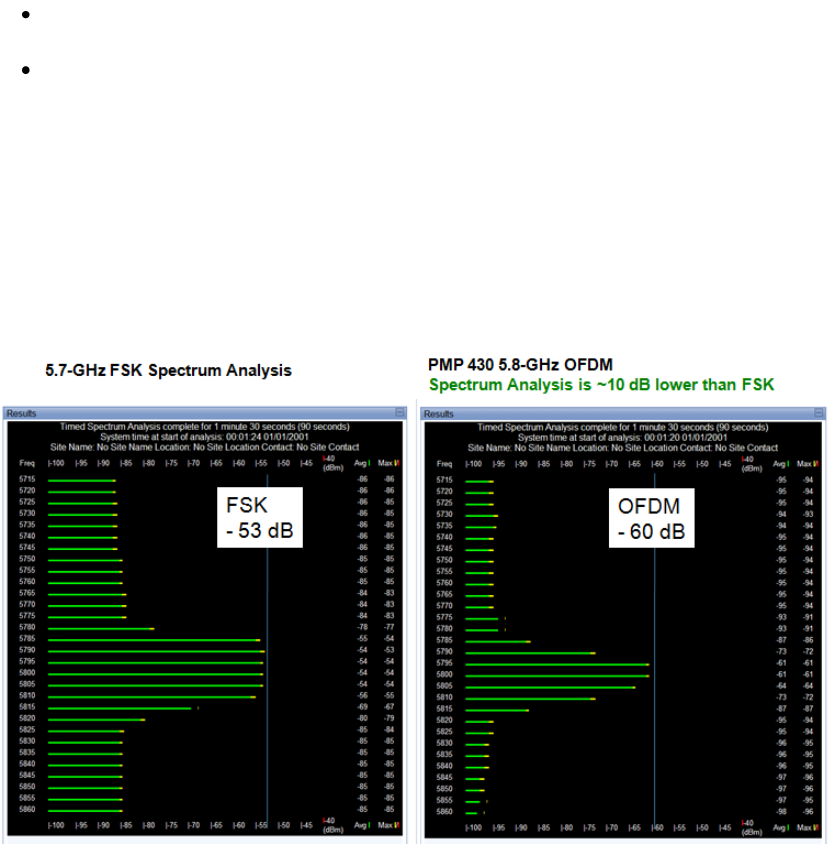
PMP 400/430 and PTP 200/230 Series Motorola PMP Solutions User Guide Supplement
Issue 6.0 May 2011 Page 37 of 77
3.5 SPECTRUM ANALYZER
A spectrum analyzer is available on the SM’s Tools => Spectrum Analyzer page. The spectrum
analyzer is also available on an AP by temporarily converting it to an SM by setting the Device
Type to SM on the AP’s Configuration => General page. The spectrum analyzer works like the
spectrum analyzer in classic FSK SMs.
Spectrum analyzer uses include:
Showing relative power levels (instantaneous and average) across the band, to aid in
selecting channels and performing RF planning.
Troubleshooting to finding the frequency, relative power level, and location of interferers
by rotating a single SM, or triangulating from multiple SMs in a geographical area.
Release 10.2 added a configurable setting on the Tools => Spectrum Analyzer web page to
display either instantaneous or averaging for spectrum analyzer results for the PTP 100 BHs and
PMP 430 5.8-GHz Series. Release 10.3 added this enhancement for the PMP 400/430 5.4-GHz,
PTP 200 BHs and PMP 100 Series.
The PMP 430 and PTP 230 Series uses average detector rather than peak detector algorithm
which results in ~10 dBm lower readings than PMP 400 Series and FSK which use peak
detectors. For example, when measuring power from an OFDM AP transmitting on a given
channel the PMP 430 5.8-GHz OFDM SM might show a Receive Power Level of -60 dBm while
a PMP 100 5.7-GHz FSK SM spectrum analyzer shows a power level of -53 for that channel.
Figure 23: PMP 430 spectrum analysis compared to FSK
In addition, an PMP 430 SM measures power across 5, 10 or 20-MHz channels (PTP 230
measures power across 10 or 20-MHz channels) while an FSK SM measures power across 20-
MHz channels, so power measurements are not directly comparable between the two. For both
FSK and OFDM, the receiver’s channel bandwidth has been added to the display. This is
important to note as the width of the OFDM channel (5, 10 or 20MHz) affects the bandwidth data
of the spectrum analyzer sample.

PMP 400/430 and PTP 200/230 Series Motorola PMP Solutions User Guide Supplement
Issue 6.0 May 2011 Page 38 of 77
The built-in spectrum analyzer can be very useful as a tool for troubleshooting and RF planning,
but doesn’t duplicate the accuracy and programmability of a dedicated, high-end spectrum
analyzer, which may be needed in some cases.
3.6 COLLOCATION OF 5.8 GHZ OFDM WITH STANDARD 5.7 GHZ
CANOPY FSK
When locating 5.8 GHz PMP 430 OFDM APs near 5.7 GHz standard Canopy FSK APs
(especially on the same tower, but also in the same geographical area), the following practices
should be followed to avoid interference between the two systems:
Plan spacing between OFDM and FSK channels to provide 25 MHz center spacing,
which gives a 10 MHz guard band between the 10 MHz OFDM channel and the 20
MHz FSK channel.
Coordinate Downlink Data %, Range, and Control Slot settings using both the
OFDM and the FSK frame calculators
The following paragraphs give more details on these recommended practices.
3.6.1 Channel Spacing
Center spacing of 25 MHz between collocated FSK and OFDM APs provides a 10 MHz guard
band between the 20 MHz and 10 MHz channels, which has proven useful and needed in field
testing. Alternatively, in cases where channel planning is severely restricted and the 10 MHz
guard band (25 MHz spacing) is not possible, using vertical separation of 5 feet or more between
the OFDM and FSK APs may allow collocation with no guard band (15 MHz spacing) in some
deployments.
3.6.2 Frame Calculations and Configuration Settings
Interference between collocated Canopy systems can be avoided by following two practices:
1. Use a CMM with GPS synchronization. This synchronizes frame start, so that all
collocated APs begin transmitting at the same time each 2.5 millisecond frame.
2. Use the frame calculators in each module, OFDM and FSK (the frame calculators are
different, as frame details are different) to select Downlink Data %, Range, and
Control Slots for each system that produce “Rec SEQ Start” values that are within
300 bit times. This ensures that all collocated APs end transmission each frame
before any collocated AP begins to receive.
When collocating only Canopy OFDM APs together, or collocating only Canopy hardware-
scheduled FSK APs together, the simple practice of setting the Downlink Data %, Range, and
Control Slots the same on all APs ensures they won’t interfere with each other. (These
parameters are set on the “Configuration => Radio” page of the AP.) However, due to the
different “physical” layer between Canopy OFDM and Canopy FSK, this doesn’t necessarily work
when collocating OFDM and FSK together.
You will need to use frame calculators on both the OFDM and FSK modules, as they are different
frame calculators. For the same Downlink Data %, Range, and Control Slots, the frame
calculators give different results. Use of the frame calculators is similar to the previous use when
collocating PMP 100 FSK software-scheduled and hardware-scheduled APs.

PMP 400/430 and PTP 200/230 Series Motorola PMP Solutions User Guide Supplement
Issue 6.0 May 2011 Page 39 of 77
3.7 COLLOCATION OF 5.4 GHZ OFDM WITH STANDARD 5.4 GHZ
CANOPY FSK
When locating 5.4 GHz PMP 400/430 and PTP 200/230 Series OFDM APs near 5.4 GHz
standard Canopy FSK APs (especially on the same tower, but also in the same geographical
area), the following practices should be followed to avoid interference between the two systems:
Plan spacing between OFDM and FSK channels to provide 25 MHz center spacing,
which gives a 10 MHz guard band between the 10 MHz OFDM channel and the 20
MHz FSK channel.
Coordinate Downlink Data %, Range, and Control Slot settings using both the
OFDM and the FSK frame calculators
The following paragraphs give more details on these recommended practices.
3.7.1 Channel Spacing
Center spacing of 25 MHz between collocated FSK and OFDM APs provides a 10 MHz guard
band between the 20 MHz and 10 MHz channels, which has proven useful and needed in field
testing. Alternatively, in cases where channel planning is severely restricted and the 10 MHz
guard band (25 MHz spacing) is not possible, using vertical separation of 5 feet or more between
the OFDM and FSK APs may allow collocation with no guard band (15 MHz spacing) in some
deployments.
3.7.2 Frame Calculations and Configuration Settings
Interference between collocated Canopy systems can be avoided by following two practices:
3. Use a CMM with GPS synchronization. This synchronizes frame start, so that all
collocated APs begin transmitting at the same time each 2.5 millisecond frame.
4. Use the frame calculators in each module, OFDM and FSK (the frame calculators are
different, as frame details are different) to select Downlink Data %, Range, and
Control Slots for each system that produce “Rec SEQ Start” values that are within
300 bit times. This ensures that all collocated APs end transmission each frame
before any collocated AP begins to receive.
When collocating only Canopy OFDM APs together, or collocating only Canopy hardware-
scheduled FSK APs together, the simple practice of setting the Downlink Data %, Range, and
Control Slots the same on all APs ensures they won’t interfere with each other. (These
parameters are set on the “Configuration => Radio” page of the AP.) However, due to the
different “physical” layer between Canopy OFDM and Canopy FSK, this doesn’t necessarily work
when collocating OFDM and FSK together.
You will need to use frame calculators on both the OFDM and FSK modules, as they are different
frame calculators. For the same Downlink Data %, Range, and Control Slots, the frame
calculators give different results. Use of the frame calculators is similar to the previous use when
collocating PMP 100 FSK software-scheduled and hardware-scheduled APs.
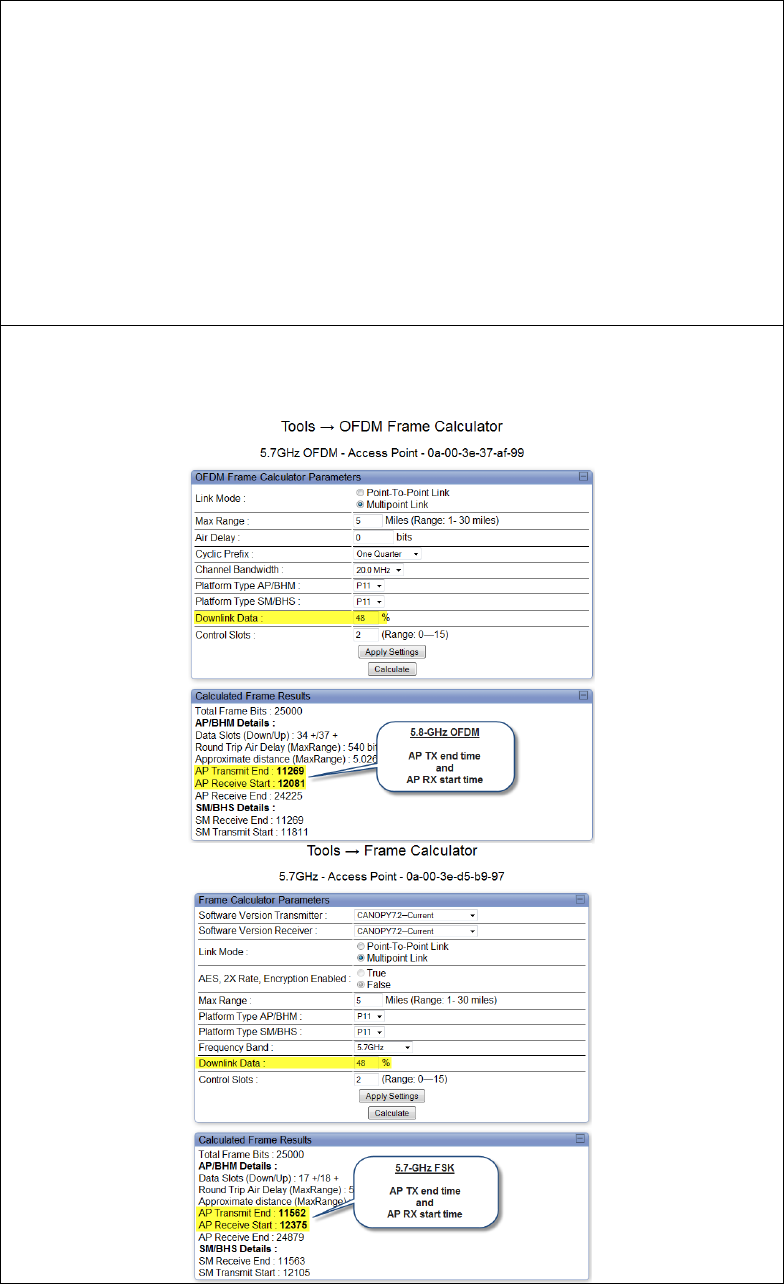
PMP 400/430 and PTP 200/230 Series Motorola PMP Solutions User Guide Supplement
Issue 6.0 May 2011 Page 40 of 77
Procedure 1: Finding collocation values using Frame Calculators
Using the “Tools => Frame Calculator” on an OFDM module, enter the desired
Downlink Data %, Range, and Control Slot settings, click Calculate, and observe
the “Rec SEQ Start” value.
Using the “Tools => Frame Calculator” on an FSK module, enter the desired Downlink
Data %, Range, and Control Slot settings, click Calculate, and observe the “Rec
SEQ Start” value.
Iterate, usually adjusting the FSK Downlink Data % and the OFDM Downlink Data %
values by a few percent each time, until the “Rec SEQ Start” times of all
collocated modules are within 300 bit times of each other.
Configure the OFDM modules using the resulting OFDM values, and the FSK
modules using the resulting FSK values.
The frame calculator page (FSK and OFDM) has been simplified with Release 10.3 to
show only information pertinent to co-location. It will now display AP TX end time and
AP RX start time which allows the operator to more easily calculate co-location duty
cycles.
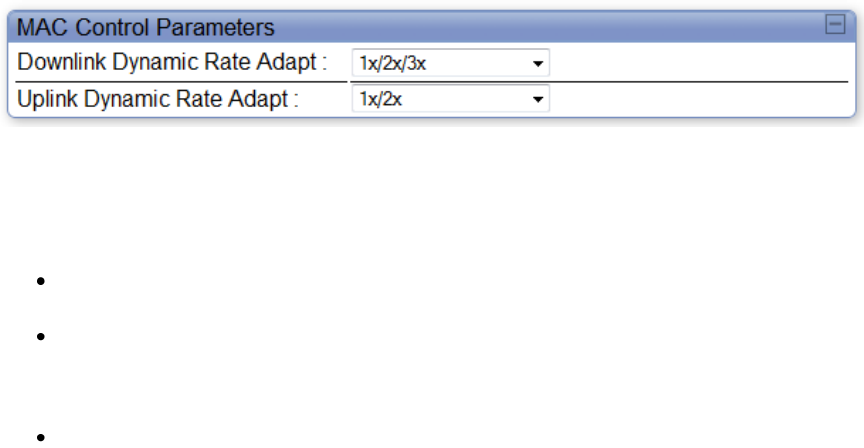
PMP 400/430 and PTP 200/230 Series Motorola PMP Solutions User Guide Supplement
Issue 6.0 May 2011 Page 41 of 77
4 Configuring
Most PMP 400/430 Series and PTP 200/230 Series configuration items are identical or very
similar to configuration items in standard FSK Canopy modules. This section discusses those that
are new or changed and also remarks on some that remain unchanged.
4.1 LINK OPERATION – 1X/2X/3X
PMP 400/430 and PTP 200/230 Series products offer three levels or speeds of operation – 1X,
2X, and 3X. If received power is less due to distance between the AP/BHM and the SM/BHS or
due to obstructions, or interference affects the RF environment, the Canopy system will
automatically and dynamically adjust links to the best operation level. Distance, rates and other
information associated with the operation levels are shown in Table 8 on page 32.
The system chooses its operation rate dynamically, based on Canopy’s internal ARQ (Automatic
Repeat reQuest) error control method. With ARQ, every data slot of every frame sent over the air
(except downlink broadcast) is expected to be acknowledged by the receiver, and if
acknowledgement is not received, the data is resent. The sending unit monitors these resends,
and adjusts the operation rate accordingly. A normal system may have links that move from 3X to
2X (or 1X) and back as the RF environment changes. Furthermore, the links operate
independently; normal operation can have a downlink running at 3X while the uplink RF
environment only supports 2X.
The default is for both AP/BHM and SM/BHS to be enabled for 3X operation. An operator may
“lock down” a link to 1X/2X operation or to only 1X operation using the Dynamic Rate Adapt
parameter on the SM’s/BHS’s Configuration => General page as shown in Figure 24. This
parameter locks down the uplink or downlink operation. An operator may lock down an entire
sector to 2X and 1X operation, or to only 1 X operation, using the Dynamic Rate Adapt parameter
on the AP’s Configuration => General page. This parameter locks down uplink or downlink of all
links in the sector, and overrides any SM 1X/2X/3X settings. For example, if an individual link is
set for 3X operation at the SM and the sector is set for 1X operation at the AP, all links in the
sector will be locked down to 1X operation.
Figure 24: Dynamic Rate Adapt on AP "Configuration => General" page
In most cases an operator is well-served to leave the setting at 1X/2X/3X and let the system
automatically and dynamically choose the best rate for each link. Cases when it may be useful to
lock down a link to 1X or 2X include:
If you are having trouble aiming a link or getting it to register, locking the link down to 2X
or 1X may help in some cases.
If the link is suspected to be oscillating between operation rates to the detriment of
throughput, locking the link down may increase throughput. Usually, even if the link is
moving rapidly between operation rates, overall link throughput and sector capacity are
highest if the link is left at 3X and the link can choose its own rate dynamically.
General link troubleshooting
Optimal sector utilization involves having as many links as possible running at 3X. This provides
as much capacity as possible for the sector. As an example, you want to limit throughput to an
individual subscriber to 1X rates. This does not mean you should set that link to 1X operation.

PMP 400/430 and PTP 200/230 Series Motorola PMP Solutions User Guide Supplement
Issue 6.0 May 2011 Page 42 of 77
Use MIR (Maximum Information Rate) settings to cap the SM’s bandwidth use, but let the link run
at as high an operation rate as the RF environment will allow. This ensures that any transmission
uses as little “air time” as possible, leaving more “air time” for other SMs.
4.2 TRANSMITTER OUTPUT POWER (AND NO JITTER)
The AP/BHM’s Transmitter Output Power is configured on the AP/BHM’s “Configuration =>
Radio” page.
Table 12: PMP 400/430 and PTP 200/230 Tx output power
Radio/
Frequency
Channel
Size
Region(s)
Transmit
Output Power
Range
TX
Default
Setting
Antenna
Gain
(18 dBi –
1dB cable
loss)
Max
EIRP
(Tx +
Antenna
Gain)
PMP 430
5.8 GHz
OFDM
5 MHz
United States and Canada
-30 to +19 dBm
19 dBm
17 dBm
36 dBm
Europe and India
-30 to +13 dBm
13 dBm
17 dBm
30 dBm
10 MHz
United States and Canada
-30 to +19 dBm
19 dBm
17 dBm
36 dBm
Europe and India
-30 to +16 dBm
16 dBm
17 dBm
33 dBm
20 MHz
United States, Canada,
Europe and India
-30 to +19 dBm
19 dBm
17 dBm
36 dBm
PMP 430
5.4 GHz
OFDM
5 MHz
United States, Canada,
Europe, India, Russia,
Brazil and Australia
-30 to +7 dBm
7 dBm
17 dBm
24 dBm
10 MHz
-30 to +10 dBm
10 dBm
17 dBm
27 dBm
20 MHz
-30 to +13 dBm
13 dBm
17 dBm
30 dBm
PTP 230
5.8 GHz
OFDM
10 MHz
United States and Canada
-30 to +19 dBm
19 dBm
17 dBm
36 dBm
Europe and India
-30 to +16 dBm
16 dBm
17 dBm
33 dBm
20 MHz
United States, Canada,
Europe and India
-30 to +19 dBm
19 dBm
17 dBm
36 dBm
PTP 230
5.4 GHz
OFDM
10 MHz
United States, Canada,
Europe, India, Russia,
Brazil and Australia
-30 to +7 dBm
7 dBm
17 dBm
24 dBm
-30 to +10 dBm
10 dBm
17 dBm
27 dBm
20 MHz
-30 to +13 dBm
13 dBm
17 dBm
30 dBm
PMP 400
PTP 200
5.4 GHz
OFDM
10 MHz
United States, Canada,
Europe, India, Russia,
Brazil and Australia
-30 to +12 dBm
10 dBm
17 dBm
27 dBm
PMP 400
PTP 200
4.9 GHz
OFDM
10 MHz
United States, Canada,
Europe, India, Russia,
Brazil and Australia
-30 to +18 dBm
18 dBm
17 dBm
35 dBm
For the PMP 400 5.4-GHz OFDM to meet 27 dBm EIRP with the connectorized 18 dBi antenna
(with 1 dB of cable loss) that comes with the 5440AP or 5441AP, or the integrated 17 dBi antenna
that comes with a 5440BH or 5441BH, the maximum setting allowed is 10 dBm (the default)
since 27-17=10.

PMP 400/430 and PTP 200/230 Series Motorola PMP Solutions User Guide Supplement
Issue 6.0 May 2011 Page 43 of 77
If a connectorized AP or BHM has been purchased and the operator has provided the antenna,
the Transmitter Output Power must be configured based on that antenna and consistent with
local or regional regulations. For example, if a 5440APC is being used with a 15 dBi antenna,
then the maximum setting allowed to meet 27 dBm EIRP is the full 12 dBm of which the radio is
capable.
IMPORTANT!
It is the responsibility of the operator and professional installer to ensure
Transmitter Output Power is set within regulatory limits for their country
or region. These must be set or confirmed on initial configuration and
after a module is reset to factory defaults, and should be confirmed after
the software on a module is upgraded.
In most cases the operator will want to set the AP’s Transmitter Output Power to the maximum
allowed so as to have the greatest overall range and the greatest range for 3X operation. It may
be useful to reduce Transmitter Output Power when Canopy systems are located close together,
with good coverage given because of their proximity and full power isn’t needed, or in cases
where an operator is trying to reduce interference from the Canopy system to other systems.
Each SM’s Transmitter Output Power is automatically set by the AP. The AP monitors the
received power from each SM, and adjusts each SM’s Transmitter Output Power so that the
received power at the AP from that SM is not greater than -60 dBm. In addition, for 5.4-GHz SMs,
the AP sets the SM’s Transmitter output power so the SM’s EIRP will be within regulatory
requirements.
PMP 400/430 Series networks use Auto-TPC because OFDM technology is more sensitive to
large differences in power levels from SMs operating at various distances from the AP than the
single carrier technology used in Canopy FSK.
PTP 200 Series bridges do not use Auto-TPC – the operator sets Transmitter Output Power on
the “Configuration => Radio” page of both the BHM and the BHS.
PMP 400/430 and PTP 200/230 Series modules display the typical Canopy “Receive Power
Level” as shown in Figure 25. Due to the different modulation technique no “jitter” is calculated or
displayed.
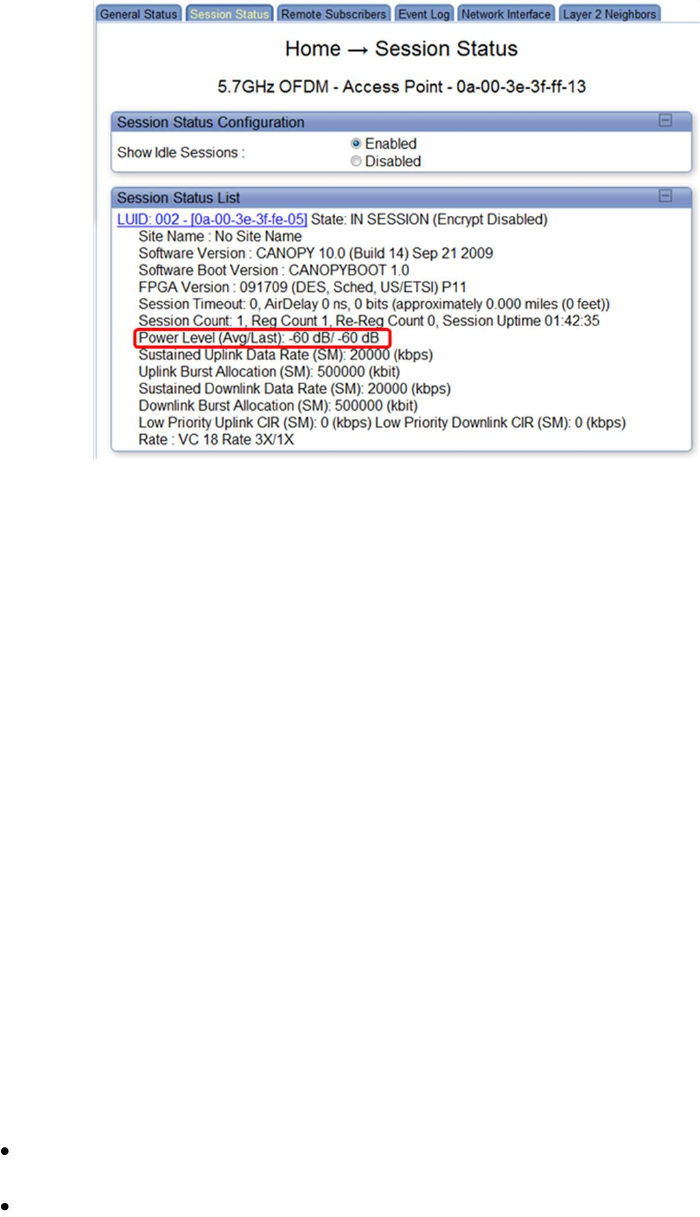
PMP 400/430 and PTP 200/230 Series Motorola PMP Solutions User Guide Supplement
Issue 6.0 May 2011 Page 44 of 77
Figure 25: SM Power Level on AP “Home => Session Status” page.
4.3 DOWNLINK DATA %, RANGE, AND CONTROL SLOTS
The Downlink Data parameter on the AP’s and BHM’s Configuration => General page can be set
in 1% increments between 10% and 90%. The default as shown in Figure 26 is 75%.
In order for U.S. model 5.4 GHz PTP Series radios to meet FCC DFS compliance, the Downlink
Data has been limited to 10-65% at the Backhaul Master. For all other regions of 5.4 GHz PTP
230 Series radios and all regions of 5.8 GHz PTP radios, the Downlink Data range remains 10-
90%.
The Range parameter on the AP’s Configuration => General page can be set in 1-mile
increments between 1 and 30 miles for PMP 430 5 and 10MHz channel bandwidth and between
1 and 24 miles for PMP 430 20MHz channel bandwidth. The default as shown in Figure 26 is 2
miles. Set the Range to the distance of the furthest SM from any AP in the area. The Range
parameter effectively determines frame structure of the Canopy over-the-air protocol, especially
turn-around guard time. Setting Range the same across a geographical area give best overall
performance.
Range does not change transmit power levels. Do not set a higher Range than needed. A higher
Range gives no higher power and slightly reduces throughput to allow for higher air delay and
turn-around time.
If the Range is set to greater than 5 miles, the SM limits the Downlink Data to a maximum of
85% to avoid close-in SMs having registration issues. For example, a Range of 6 miles and a
Downlink Data of 90% is not allowed. Operationally,
if the Downlink Data % is set to greater than 85% and the user enters a range greater
than 5 miles, the module will reset the Downlink Data % to 85%
if the range is set to greater than 5 miles and the user enters a Downlink Data % of
greater than 85%, the module will reset the Downlink Data % to 85%.
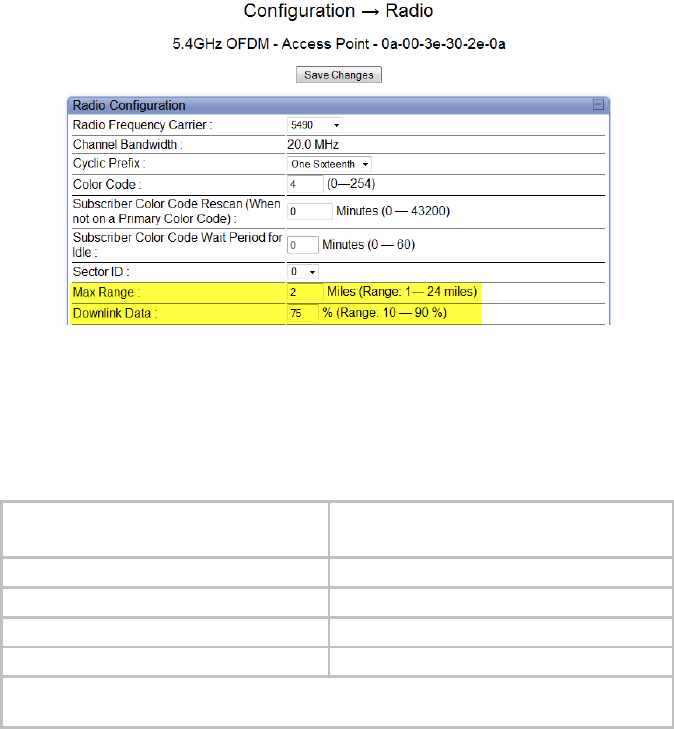
PMP 400/430 and PTP 200/230 Series Motorola PMP Solutions User Guide Supplement
Issue 6.0 May 2011 Page 45 of 77
Figure 26: Max Range & Downlink Data on AP "Configuration => Radio" page.
Suggested Control Slot settings as a function of number of SMs in the sector are shown in Table
13. Generally all APs in a cluster should use the same number of control slots so as to keep the
frame structures, and thereby the send and receive timing, the same.
Table 13: PMP 400/430 AP Control Slot Settings
Number of SMs that
Register to the AP
Suggested Number of
Control Slots
1 to 10
11 or 2
11 to 50
4
51 to 150
6
151 to 200
8
Note 1: Any OFDM sector with the Hi Priority Channel enabled on any SM
should be configured with at least 1 Control Slot on the AP.
In some cases operators may find that sectors with high levels of small packet requests, such as
might be seen in a sector handling several VoIP streams, benefit overall from slightly higher
Control Slot settings. If different sectors require different numbers of Control Slots, the operator
should use the Frame Calculator to find a combination of settings that put “Rec SEQ Start” times
within 300 bit times. See section 3.7.2 on page 39 for details.
Control Slots are reserved for SMs’ bandwidth requests and never handle data. A higher number
of control slots gives higher probability that an SM’s bandwidth request will be heard when the
system is heavily loaded, but with the tradeoff that sector capacity is reduced by about 100 kbps
for each Control Slot configured, so there will be less capacity to handle the request.
Uplink Data Slots are used first for data. If they are the not needed for data in a given frame the
data slot can be used by the SMs for bandwidth requests. This allows SMs in sectors with zero
control slots configured to still make bandwidth requests using unused data slots.
Downlink Data %, Range, and Control Slots should be set consistent with the results of any
collocation planning done using OFDM and FSK frame calculators in section 3.7.2 on page 39.
The BHM performs its own ranging and so no range need be set for it.
BHMs do not have settings for control slots, as there is no bandwidth request contention on the
one-to-one link.
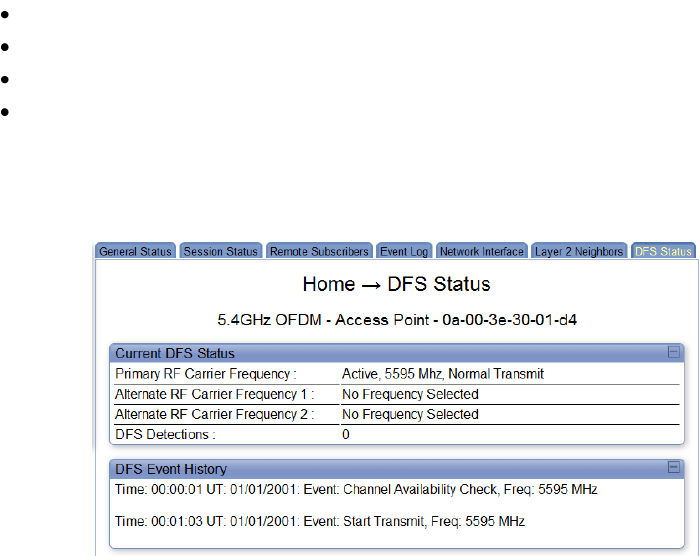
PMP 400/430 and PTP 200/230 Series Motorola PMP Solutions User Guide Supplement
Issue 6.0 May 2011 Page 46 of 77
4.4 DFS AND REGULATORY PARAMETERS FOR 5.8 & 5.4 GHZ RADIOS
Dynamic Frequency Selection (DFS) is a requirement in several countries and regions for 5 GHz
unlicensed systems to detect radar systems and avoid co-channel operation. DFS and other
regulatory requirements drive the settings for the following parameters, as discussed in this
section:
Region Code
Primary Frequency
Alternate 1 and Alternate 2 Frequencies
External Antenna Gain
On the AP/BHM, the “Home => DFS Status” page shows current DFS status of all three
frequencies and a DFS log of past DFS events. Unlike standard Canopy, the PMP 400/430 and
PTP 200/230 Series AP, SM, and BH do not offer “Whitening”, as the OFDM technology obviates
the need for it.
Figure 27: DFS Status on AP "Home => DFS Status" page.
4.4.1 Background and Operation
The modules use region-specific DFS based on the “Region Code” selected on the module’s
“Configuration => General” page. By directing installers and technicians to set the Region Code
correctly, the operator gains confidence the module is operating according to national or regional
regulations without having to deal with the details for each region.
Available “Region Codes” include Other, United States, Canada, Europe, Brazil, India, Russia,
Indonesia and Australia. Operators in regions or countries not listed and with requirements
aligned with one of the listed countries should set the Region Code to that country. Operators in
regions or countries with no requirements for DFS should use the “Other” Region Code.
New APs and BHMs from the factory will show a Region Code of “None”, and will not transmit
until the Region Code is set to a value other than “None”.
Canada, United States and Europe have requirements to avoid certain 5.4-GHz frequencies used
by some weather radar. To meet this requirement, modules set to a Region Code of Canada,
United States or Europe will display the center channel frequencies shown in Table 10 on page
35 on the AP’s and BHM’s Carrier Frequency pop-up and on the SM’s and BHS’s Frequency
Scan Selection List.

PMP 400/430 and PTP 200/230 Series Motorola PMP Solutions User Guide Supplement
Issue 6.0 May 2011 Page 47 of 77
Table 14 shows the details of DFS operation and channels available for each Region Code,
including whether DFS is active on the AP/BHM, SM/BHS, which DFS regulation apply, and any
channel restrictions. DFS does not apply to 4.9 GHz.
Table 14: 5.4 / 5.8 GHz OFDM DFS Operation based on Region Code
Region Code1
Frequency
AP/BHM
SM/BHS
Weather Radar Notch-
Out
United States
5.4 GHz
FCC/IC DFS3
No effect
Yes
5.8 GHz
No effect
No effect
No
Canada
5.4 GHz
FCC/IC DFS3
No effect
Yes
5.8 GHz
No effect
No effect
No
Europe
5.4 GHz
ETSI DFS4
ETSI DFS
Yes
5.8 GHz
ETSI DFS5
ETSI DFS
No
Brazil
5.4 GHz
ETSI DFS
No effect
No
5.8 GHz
No effect
No effect
No
Australia
5.4 GHz
FCC/IC DFS
No effect
Yes
5.8 GHz
No effect
No effect
No
Russia
5.4 GHz
No effect
No effect
No
5.8 GHz
No effect
No effect
No
India
5.4 GHz
No effect
No effect
No
5.8 GHz
No effect
No effect
No
Other
5.4 GHz
No effect
No effect
No
5.8 GHz
No effect
No effect
No
1. In all cases set the Region Code to the region you are in and the equipment will
provide DFS consistent with that region’s regulations. For countries or regions
not listed, use a Region Code that provides DFS functionality and channels
consistent with your country’s regulatory requirements.
2. In some countries and regions, 5600 MHz to 5650 MHz is “notched” out to meet
requirements to not transmit in weather radar frequencies.
3. FCC/IC indicates compliance with FCC Report and Order 03-287 and Industry
Canada requirements.
4. ETSI DFS indicates compliance with ETSI EN 301 893 v1.4.1
5. ETSI DFS indicates compliance with ETSI EN 302 502 v1.2.1
After an AP or BHM with DFS boots it performs a channel availability check on its main carrier
frequency for 1 minute, monitoring for the radar signature without transmitting. If no radar
signature is detected during this minute, the module then proceeds to normal beacon transmit
mode. If it does detect a radar signature, the frequency is marked for a 30 minute non-occupancy
period, and the module moves to its 1st alternate carrier frequency. The AP/BHM continues this
behavior through its 2nd alternate frequency if needed and then waits until the first frequency
ends the 30 minute non-occupancy period. While operating, if the AP/BHM detects a weather

PMP 400/430 and PTP 200/230 Series Motorola PMP Solutions User Guide Supplement
Issue 6.0 May 2011 Page 48 of 77
radar signature it marks the current carrier frequency for a 30 minute non-occupancy period and
moves to check the next-in-line carrier frequency.
An SM/BHS does not begin transmission until it detects a beacon from an AP/BHM. If APs/BHMs
are not transmitting, SMs/BHSs will be silent.
The FCC and IC require DFS only on APs/BHMs. Europe applies the ETSI specification to both
APs/BHMs and SMs/BHSs, while Brazil applies it only to AP/BHMs. In the ETSI case, when an
SM/BHS boots, it scans to find a Canopy beacon from a AP/BHM. If an AP/BHM is found, the
SM/BHS performs a channel availability check on that frequency for 1 minute, monitoring for the
radar signature, without transmitting. A DFS decision is made based on the following:
If no radar pulse is detected during this 1 minute, the SM/BHS proceeds through normal
steps to register to an AP/BHM.
If the SM/BHS does detect radar, it locks out that frequency for 30 minutes and continues
scanning other frequencies in its scan list.
Note, after an SM with DFS has seen a radar signature on a frequency and locked out that
frequency, it may connect to a different AP if color codes, AP transmitting frequencies, and SM
scanned frequencies support that connection.
BHSs would not be expected to connect to a different BHM, as backhaul links should be
configured using color codes and authentication to ensure a BHS only connects with its intended
BHM.
To simplify operation and ensure compliance, an SM/BHS takes on the DFS type of the AP/BHM
to which it registers. For example, when an SM in Europe registers to an AP with the Region
Code set to “Europe”, that SM will use ETSI DFS, no matter what its Region Code is set to, even
if its Region Code is set to “None”. Note, the operator should still configure the Region Code in
the SM correctly, as future releases may use the Region Code for additional region-specific
options.
For all modules running DFS, the module displays its DFS state on its Home => General Status
page as one of the following:
Checking Channel Availability Remaining time n seconds, where
n counts down from 60 to 1.
Normal Transmit
Radar Detected Stop Transmitting for n minutes, where n counts
down from 30 to 1.
Idle, only for SM/BHS, indicates module is scanning, but has not detected a
beacon from an AP/BHM. Once it detects beacon, the SM/BHS begins a Channel
Availability Check on that frequency.
4.4.2 Setting DFS and Regulatory Parameters
Setting the Region Code
All modules display a Region Code pop-up on the Configuration => General page as shown in
Figure 28 on page 50.
On new modules from the factory, or after resetting to factory defaults, the operator should set
this Region Code consistent with their country or region. For countries or regions not listed in the
Region Code pop-up, set the Region Code consistent with your country’s regulatory

PMP 400/430 and PTP 200/230 Series Motorola PMP Solutions User Guide Supplement
Issue 6.0 May 2011 Page 49 of 77
requirements. For example, several countries in South America follow the same DFS regulations
as Brazil, so in those countries the Region Code should be set to “Brazil”.
IMPORTANT!
Operators under regulatory requirements for DFS must ensure the new
Canopy parameter “Region Code” is set correctly. This applies to initial
configuration, after a module is reset to factory defaults, or after a
module is upgraded.
An AP or BHM will not transmit if the Region Code is configured to “None”.
IMPORTANT!
On APs or BHMs received from the factory, with Region Code set to
“None”, the operator must set the Region Code before the module will
transmit. The same is true of APs and BHMs which have been reset to
factory defaults.
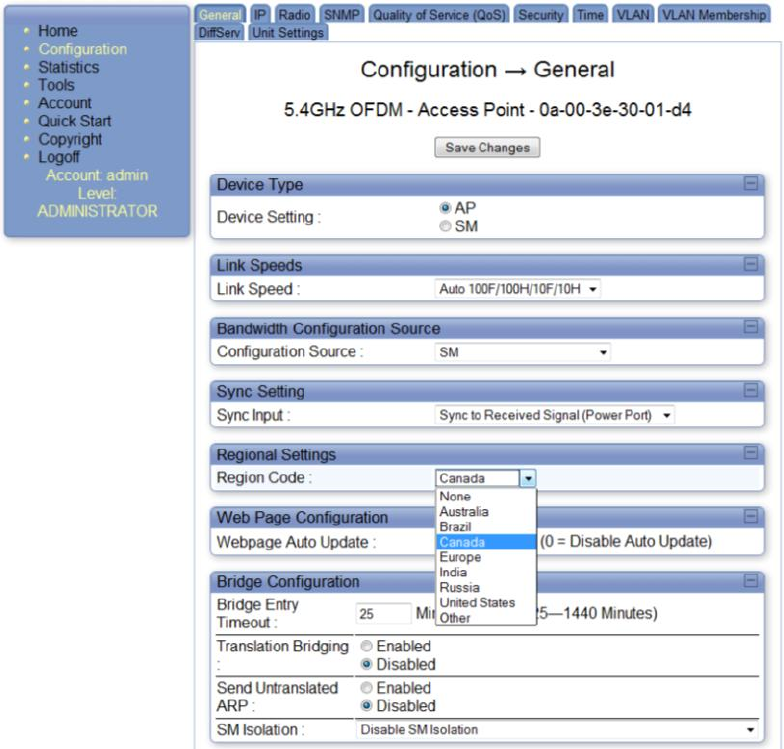
PMP 400/430 and PTP 200/230 Series Motorola PMP Solutions User Guide Supplement
Issue 6.0 May 2011 Page 50 of 77
Figure 28: Region Code on AP “Configuration => General” page
An SM/BHS has both a configurable Region Code and, once it registers to an AP or BHM, an
active Regional Code. After an SM/BHS registers to an AP/BHM, it uses the region code of the
AP/BHM to determine its DFS behavior and displays the AP/BHM’s region code on its Home =>
General Status page, as shown in Figure 30.
The two Region Codes on an SM/BHS should be the same in normal operation. However, they
will not be the same if, for example, an SM configured with a Region Code of “None” has
registered to an AP with a Region Code of Europe as shown in Figure 29 and Figure 30.
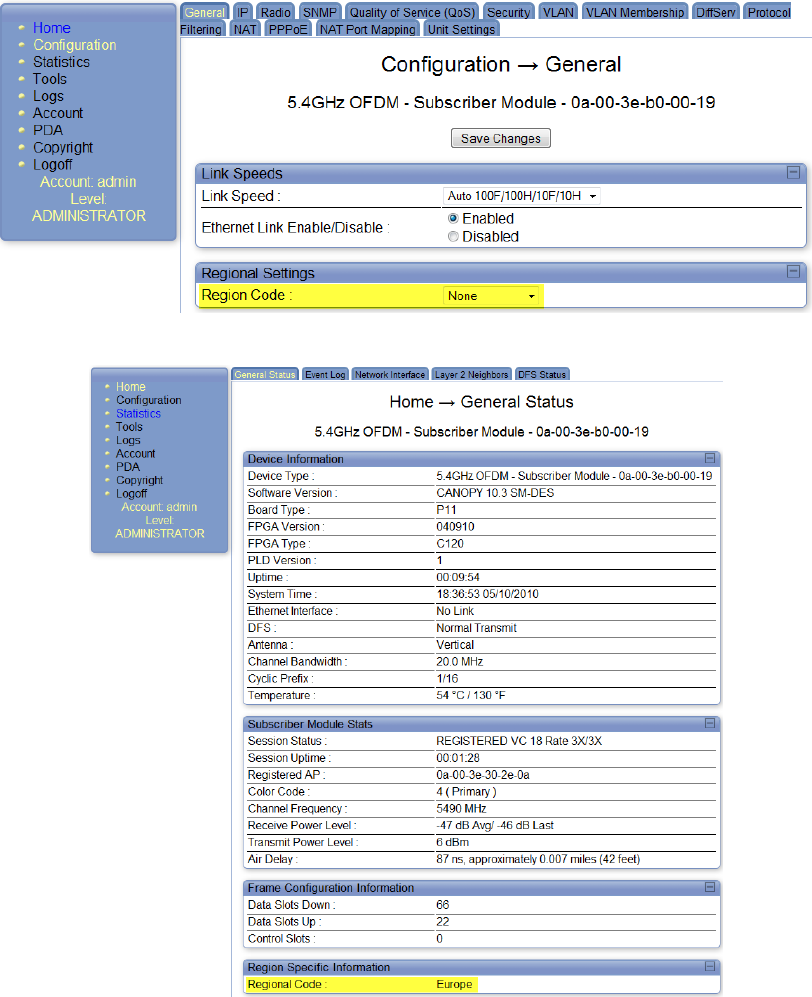
PMP 400/430 and PTP 200/230 Series Motorola PMP Solutions User Guide Supplement
Issue 6.0 May 2011 Page 51 of 77
Figure 29: Configured Region Code on SM Configuration => General page
Figure 30: Active Region Code on SM Home => General Status page
The AP or BHM always operates under its manually configured Region Code (the one on the
Configuration => General page), and so does not show a Region Code on its Home => General
Status page.
Under normal operations, APs and BHMs operating with DFS (see Table 14) will experience an
additional minute after power-up or reboot before they will register any SMs or BHSs. SMs and
BHSs operating with DFS (see Table 14) will experience an additional minute after they reboot
before they will register to an AP or BHM.
It takes two reboots to set the parameters described below on a module starting from factory
defaults. Set the Region Code as described above, Save Changes, and Reboot. If the module

PMP 400/430 and PTP 200/230 Series Motorola PMP Solutions User Guide Supplement
Issue 6.0 May 2011 Page 52 of 77
then invokes DFS (based on the region code and frequency band as shown in Table 14), the
Radio Frequency Carriers and External Antenna Gain parameters will be displayed. Set them
as described below, Save Changes, and Reboot again.
IMPORTANT!
Set the Region Code, Save Changes, and Reboot to see the context-
sensitive DFS parameters. Unlike with many context-sensitive
parameters, these do not appear in the GUI with only a Save Changes.
Setting Radio Frequencies
APs and BHMs running DFS include an option for setting up to two alternate frequencies on the
“Configuration => Radio” page, in addition to the primary frequency. These alternate frequencies
are used in the unlikely event radar is detected and the main frequency is locked out due to DFS
detection. If these are left at “None”, no backup frequencies will be used in the case of DFS
detection, and the AP or BHM will lock itself out from any transmission for 30 minutes.
If radar is detected on the main frequency, either at startup or during operation, a Channel
Availability Check will be performed on the 1st alternate frequency before it is then used for
transmission. If radar is detected on the 1st alternate frequency, either during Channel Availability
Check or during operation, a Channel Availability Check will be performed on the 2nd alternate
frequency before it is then used for transmission. If radar is detected on the 2nd alternate
frequency, either during Channel Availability Check or during operation, the radio will cease
transmission unless or until the primary channel clears its 30-minute lock-out.
The alternate frequencies configured in the AP/BHM must be included in the SM/BHS’s
Frequency Scan List, or the SMs/BHS can’t follow their AP/BHM if it switches to a new channel.
Additional frequencies may checked in the Frequency Scan List depending on local practices, for
example an operator may want to configure an SM to only register on certain frequencies to drive
a known SM to AP mapping. Another example would be an operator who configures an SM to
register on many frequencies so that it may find another AP to register to if its usual AP isn’t
available.
Note: use site surveys and RF planning to choose alternate frequencies useful for each sector,
and consider testing on the alternate frequencies to ensure compatibility with the sector’s RF
environment.
4.5 EXTERNAL GAIN FIELD
An AP, SM, or BH needs to know the gain of its antenna to perform DFS and Auto-TPC
(Automatic Transmit Power Control) (SM only) consistent with regional or national regulations.
The GUI includes an External Gain field to support this.
Key points about the External Gain field include:
External Gain is defined as the gain of the antenna minus the loss in the coaxial cable
and connectors.
The External Gain is set on the Configuration => Radio page of each module (AP, SM,
BHM, or BHS)
The default on a 5.4-GHz SM or a unit reset to factory defaults is 17 dB.
The default on a 5.8-GHz SM or a unit reset to factory default is 17 dB
The range is 0 to 35 dB.

PMP 400/430 and PTP 200/230 Series Motorola PMP Solutions User Guide Supplement
Issue 6.0 May 2011 Page 53 of 77
A 5.4-GHz SM or BH with an integrated antenna has an External Gain of 17 dB.
The antenna sold with the connectorized 5.4 or 5.8 GHz AP has a gain of 18 dB and
cable loss of approximately 1 dB, giving an External Gain of 17 dB.
A 4.9 GHz SM or BH with an integrated antenna has an External Gain of 17 dB.
The antenna sold with the connectorized 4.9 GHz AP has a gain of 18 dB and cable loss
of approximately 1 dB, giving an External Gain of 17 dB.
Any radio using DFS will use the External Gain to appropriately adjust sensitivity to radar
signals. The use of DFS is determined by the Region Code setting on the Configuration
=> Home page.
The Auto-TPC used by the PMP 400/430 and PTP 230 Series system takes into account
the External Gain so as not to exceed national or regional EIRP limits.
Procedure for setting the External Gain
1. If using a BH or SM with an integrated antenna or a connectorized AP with the
connectorized antenna sold with it, leave the External Gain on the Configuration =>
Radio page set to the factory default of 17 dB.
If using another antenna, set the External Gain to the gain of the antenna minus the loss
in coaxial cable and connectors.
IMPORTANT!
Ensure the External Gain is set correctly. Setting it low or high can lead
to either a system overly sensitive to DFS events or a system not
transmitting at its full legal power.
4.6 NETWORK CONTROL PARAMETERS
Parameters for High Priority/DiffServ, NAT, DHCP, VLAN, MIR, and CIR are configured the same
as they are in standard Canopy. The operator may (or may not) want to take advantage of the
higher possible MIR to provide greater bandwidth to a given SM.
4.7 FORWARD ERROR CORRECTION
PMP 400/430 and PTP 200 Series radios use FEC (Forward Error Correction) to extend the
range of the modules. They use Reed-Solomon error correction optimized at 3/4 coding. The
coding rate is not settable by the operator.
4.8 CYCLIC PREFIX (CONFIGURABLE ONLY ON PTP 200/230 BH & PMP
430 AP/SM)
OFDM technology uses a cyclic prefix, where a portion of the end of a symbol (slot) is repeated at
the beginning of the symbol (slot) to allow multi-pathing to settle before receiving the desired
data. A 1/4 cyclic prefix means that for every 4 bits of throughput data transmitted, an additional
bit is used, A 1/8 cyclic prefix means that for every 8 bit of throughput data transmitted, an
additional bit is used.

PMP 400/430 and PTP 200/230 Series Motorola PMP Solutions User Guide Supplement
Issue 6.0 May 2011 Page 54 of 77
PMP 400 Series networks use a cyclic prefix of 1/4 that is not configurable by the operator.
PMP 430 and PTP 230 Series networks use a default cyclic prefix of 1/4 that is configurable by
the operator to 1/8 or 1/16. The Cyclic Prefix is set on the Configuration => Radio page on the
AP. Changing the default from 1/4 to 1/8 can increase throughput by ~2 Mbps (assuming 75%
duty cycle in PMP 430 networks) in installations with low multipath conditions. It is recommended
to test 1/8 or 1/16 cyclic prefix to determine actual performance based on RF conditions.
PTP 200 Series modules (OFDM BHs) are settable for either 1/8 or 1/4 cyclic prefix. The use of
1/8 cyclic prefix provides about 11% higher maximum throughput, and is recommended for
backhaul operations in most cases.
The Cyclic Prefix is set on the Configuration => Radio page of the BHM.
The default on a new unit or when the unit is reset to factory defaults is 1/4 Cyclic Prefix.
In most deployments, 1/8 or 1/16 Cyclic Prefix will provide a high quality, higher
throughput link. In cases with severe multi-pathing or obstructions, 1/4 Cyclic Prefix may
give better overall results.
Procedure for setting the Cyclic Prefix
Set the Cyclic Prefix on the Configuration => Radio page of both the BHM and the BHS
to 1/8 before deployment.
IMPORTANT!
The Cyclic Prefix must be set the same on both the BHM and the BHS.
If they don’t match, the BHS will not register to the BHM.
During installation use Link Tests to confirm link quality per standard installation and
alignment procedures.
If a Link Test shows low throughput or efficiency, consider changing the Cyclic Prefix to
1/4 on both the BHM and the BHS along with other standard installation
troubleshooting procedures such as re-aiming, off-axis aiming, changing location,
raising or lowering the height of the radio, adjusting Transmission Power up or
down, or identifying and mitigating sources of interference.

PMP 400/430 and PTP 200/230 Series Motorola PMP Solutions User Guide Supplement
Issue 6.0 May 2011 Page 55 of 77
5 Installation
WARNING!
Installing a unit usually involves height, electricity, and exposure to RF
(Radio Frequency) energy. To avoid personal injury, follow applicable
national and local safety regulations along with industry best practices.
Also follow the specific guidelines in this document, including Exposure
Separation Distances in section 6.3 on page 71.
5.1 INSTALLING AN AP WITH CONNECTORIZED ANTENNA
This section addresses installation aspects specific to the PMP 400/430 and PTP 200 Series AP.
General communications equipment, infrastructure, and facilities site design should be performed
in line with Motorola’s “Standards and Guidelines for Communications Sites” (also known as the
R56 manual). The R56 manual is available in either CD soft copy (part no. 9880384V83) or three-
ring bound color hard copy (6881089E50). Both may be purchased from Motorola Customer Care
Services (1-800-814-0601).
These procedures are specific to the case of as AP purchased as a kit consisting of a
connectorized antenna and a connectorized radio. They are also generally applicable to
connectorized APs, SMs, or BHs when the antenna is purchased separately by the operator.
A short coaxial cable from the radio terminates in a male N connector. The antenna has a
chassis-mounted female N connector. The antenna includes tower mount brackets with
adjustable down-tilt.
Installing an AP typically consists of four phases:
5. Configuring the AP at an operator's facility or at the installation site using the
information and settings defined previously in Planning (Section 3) and Configuring
(Section 4).
6. Assembling the AP (radio and antenna and brackets) and physically installing it using
Procedure 2 for 5.8 and 5.4 GHz APs or Procedure 3 for 4.9 GHz APs, along with
physically installing a CMMmicro (for PMP 54400 AP only) or CMM4 (for either PMP
58430, 54430, 54400 or PMP 49400).
7. Cabling the AP to the CMMmicro (for PMP 54400 AP only) or CMM4 (for either PMP
58430, 54430, 54400 or PMP 49400), and grounding it to Protective Earth – PE
using Procedure 4. This phase can also include cabling to backhauls, or running
terrestrial feeds.
8. Confirming operation, using SMs in the field.
Local practices and choices of installation options will dictate the actual processes. For example,
variations on these generalized procedures can be used to install on a building or install multiple
APs on a pipe mount before hoisting up a tower for final attachment.
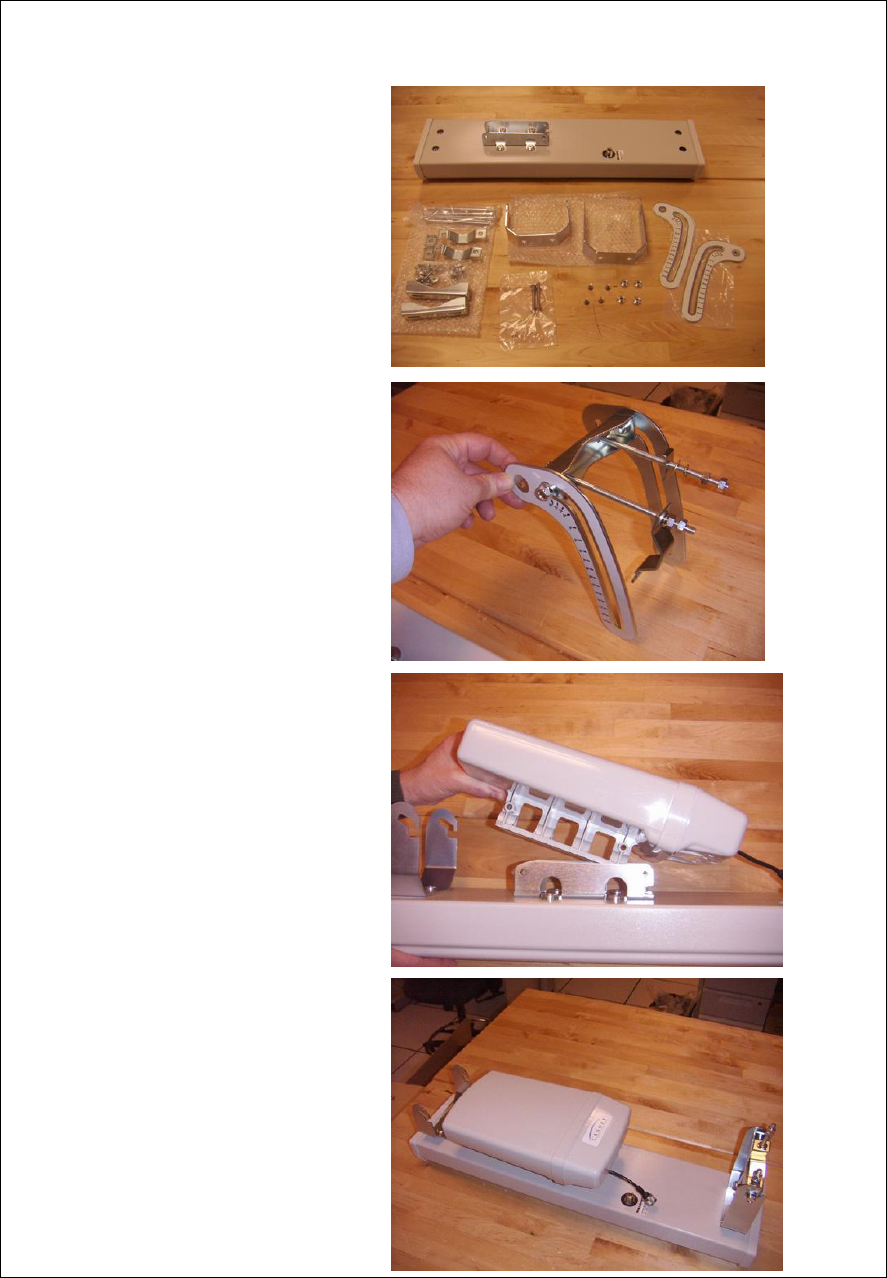
PMP 400/430 and PTP 200/230 Series Motorola PMP Solutions User Guide Supplement
Issue 6.0 May 2011 Page 56 of 77
Procedure 2: Assembling a 5.8 or 5.4 GHz AP, and attaching to tower
1. Perform a parts check to ensure all
parts are present.
2. Assemble the upper bracket, per the
diagram that comes with the
antenna.
3. Connect the radio to the antenna by
sliding it into the captive space.
Secure the radio to the antenna
using the two bolts provided.
4. Assemble the lower bracket on the
antenna assembly.
Although it may seem intuitive to
attach both brackets to the tower or
pole and then hang the antenna, it
usually works better to have the
bottom bracket already attached to
the antenna before climbing.
5. Weatherproof the connector with
waterproof wrap.
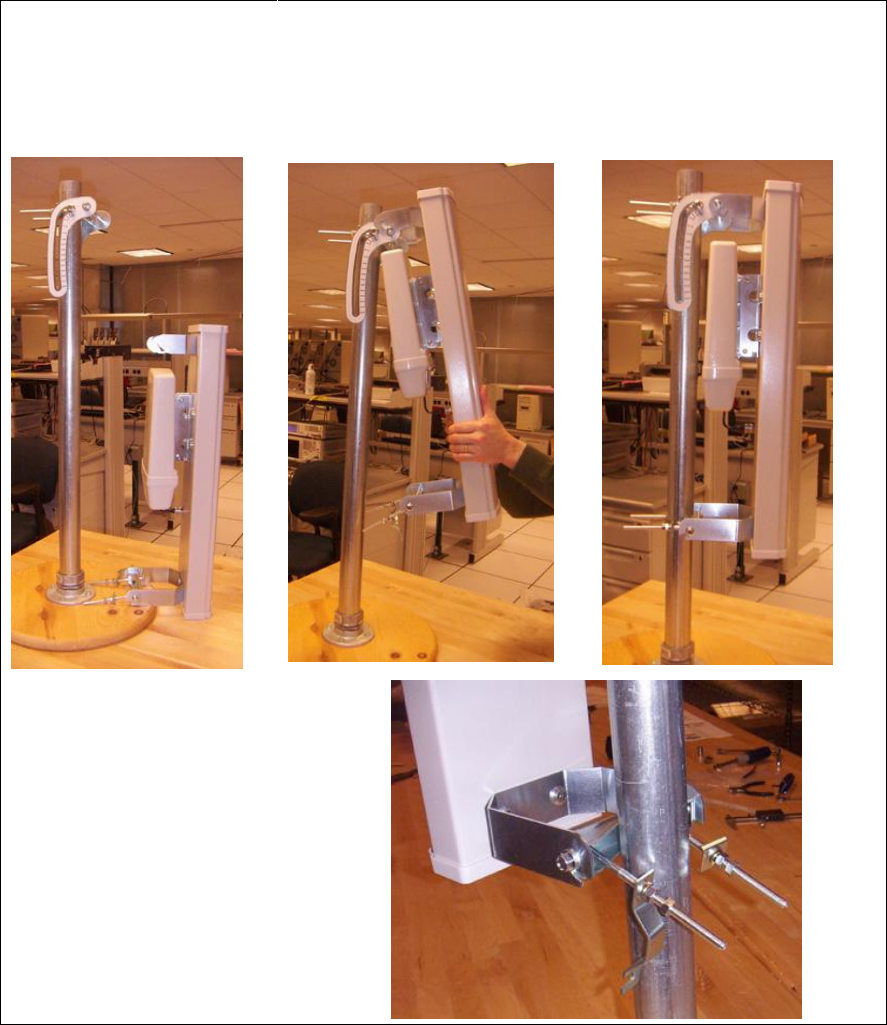
PMP 400/430 and PTP 200/230 Series Motorola PMP Solutions User Guide Supplement
Issue 6.0 May 2011 Page 57 of 77
6. Use standard work and
safety practices for
tower climbing. Connect
the upper bracket to a
pole, mounting fixture,
or the tower.
7. Hang the antenna assembly
on the upper bracket.
8. Connect the lower bracket
to the pole or tower using
the quick-connect system
provided
9. The quick-connect system allows
easy attachment, detachment, and
adjustment without any lose parts.
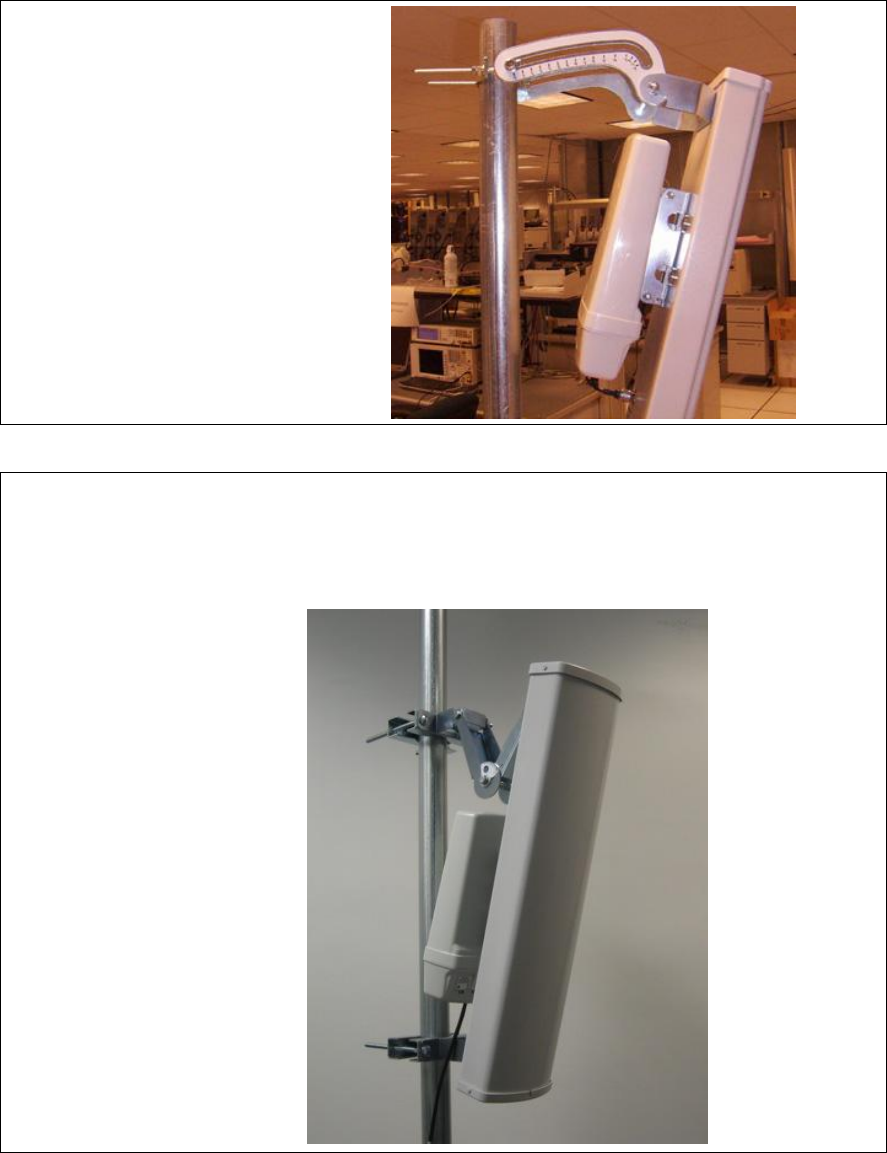
PMP 400/430 and PTP 200/230 Series Motorola PMP Solutions User Guide Supplement
Issue 6.0 May 2011 Page 58 of 77
10. Adjust down tilt per calculations
done during Planning. Confirm
down tilt after the radio is
operational using SMs in the field at
selected test locations.
Procedure 3: Assembling a 4.9 GHz AP, and attaching to tower
1. Perform a parts check to
ensure all parts are
present.
2. Assemble unit per the
instructions that come with
the kit.
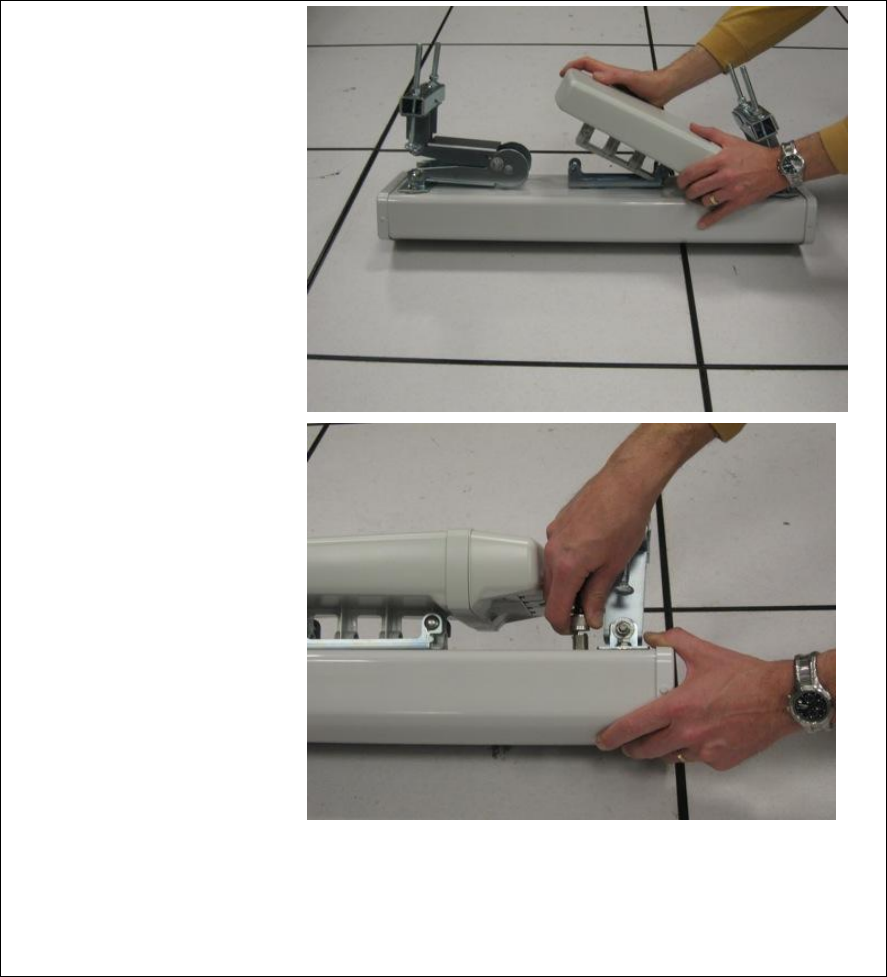
PMP 400/430 and PTP 200/230 Series Motorola PMP Solutions User Guide Supplement
Issue 6.0 May 2011 Page 59 of 77
3. Connect the radio to the
antenna by sliding it into
the captive space. Secure
the radio to the antenna
using the two bolts
provided.
4. Connect coax N-connector
5. Use standard work and
safety practices for tower
climbing, and connect the
upper assembly to a pole,
mounting fixture, or the
tower.
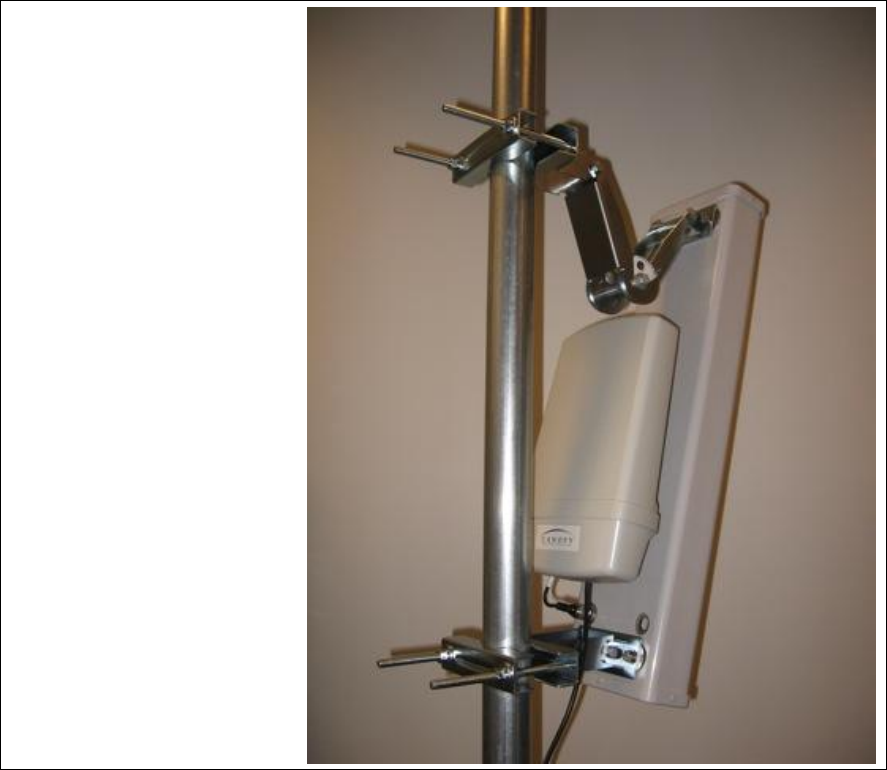
PMP 400/430 and PTP 200/230 Series Motorola PMP Solutions User Guide Supplement
Issue 6.0 May 2011 Page 60 of 77
6. Adjust down tilt per
previous calculations done
during Planning. Confirm
down tilt after the radio is
operational using SMs in
the field at selected test
locations.
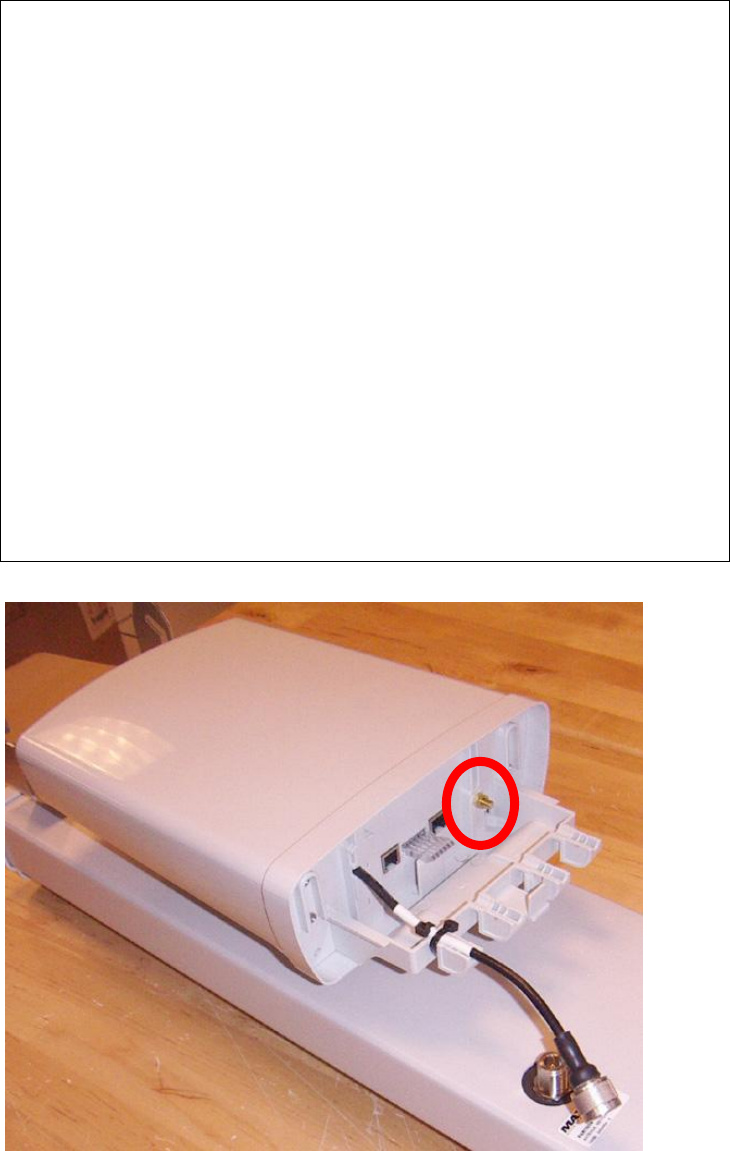
PMP 400/430 and PTP 200/230 Series Motorola PMP Solutions User Guide Supplement
Issue 6.0 May 2011 Page 61 of 77
Procedure 4: Cabling and Grounding/Earthing the AP
1. Standard Canopy installation practices apply, including using shielded
Ethernet cable for all infrastructure cabling, using drip loops, providing extra
cable for future use at any termination, and ensuring the tower or structure
is fully grounded (Protective Earth – PE).
2. Use dielectric grease (which is uniformly non-conducting) on all
connections and in all RJ-45 Ethernet connectors. The best practice is to
use enough grease to fill the RJ-45 female connector, and then insert the
RJ-45 male connector and push the grease further into the Canopy unit and
around the RJ-45 connector. Excess grease can be wiped over the
connector area to provide some resistance to water ingress around the
connector.
3. Use a 600SS surge suppressor within 3 ft (~1 m) of the AP and ground it to
known good ground (Protective Earth - PE) on the tower or support
structure with a 10 AWG ground strap.
4. A pole mount kit is available for mounting the 600SS to the tower or mast.
The mount includes a termination point for the ground strap from the
600SS.
5. Run a 10 AWG ground strap from the ground lug on the AP (see Figure 31)
to known good ground (Protective Earth - PE) to complete the grounding
and protection of the AP. The termination point on the 600SS pole mount kit
may be used for this.
Figure 31: Ground lug highlighted on AP
The PMP 400/430 AP and PTP 200 Series BH have metal-to-metal contact from the tower or
support structure, through the antenna, through the coax cable, to the radio. Installing surge
suppression at the AP is strongly recommended to provide the best protection from near lightning
hits.
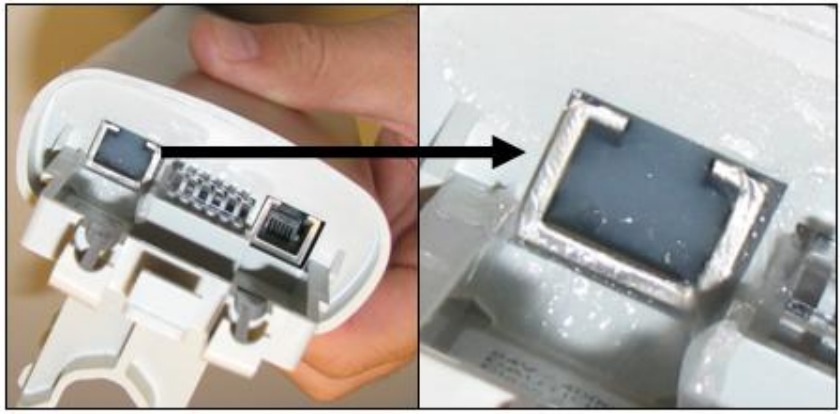
PMP 400/430 and PTP 200/230 Series Motorola PMP Solutions User Guide Supplement
Issue 6.0 May 2011 Page 62 of 77
Install a 600SS surge suppressor within 3 ft (~1 m) of an AP or BH. A pole mount kit for the
600SS is shown in Figure 16 to facilitate installation of the 600SS by the AP or BH.
Up to four 600SS surge suppressors may be mounted in series on an Ethernet link without
degrading the link. The equivalent of a 600SS is built into each of the 8 ports on a CMM4 and
counts as one of the four. The CMMmicro uses a different protection scheme and does not have
the equivalent of a 600SS on each port.
As an example, a typical installation might have properly-grounded 600SS units within 3 ft of each
AP and additional properly-grounded 600SS units on each Ethernet cable mounted outside at the
point of cable entry to a telecommunications hut that contains the CMM4.
5.2 INSTALLING AN SM OR BH WITH AN INTEGRATED ANTENNA
Installing an SM or BH with an integrated antenna is very similar to installing standard Canopy
SMs as described in the Motorola PMP Solutions User Guide, with the differences outlined below.
Use an SMMB2 SM mounting bracket for the PMP 54400 and 49400 SM and a SMMB1 mounting
bracket for the PMP 58430/54430 SM and PTP 58230/54230 BH. The PMP 400 Series SM or the
PTP 200 Series BH is heavier and has a higher wind load than a classic Canopy module, and so
the stronger SMMB2 is required. The SMMB2 is the mounting arm used with Canopy 900 MHz
integrated APs and SMs, and used with reflectors.
Use dielectric grease (which is uniformly non-conducting) on all connections and in all RJ-45
Ethernet connectors. The best practice is to use enough grease to fill the RJ-45 female
connector, and then insert the RJ-45 male connector and push the grease further into the Canopy
unit and around the RJ-45 connector. Excess grease can be wiped over the connector area to
provide some resistance to water ingress around the connector.
Figure 32: Dielectric Grease – Apply to RJ45 connector
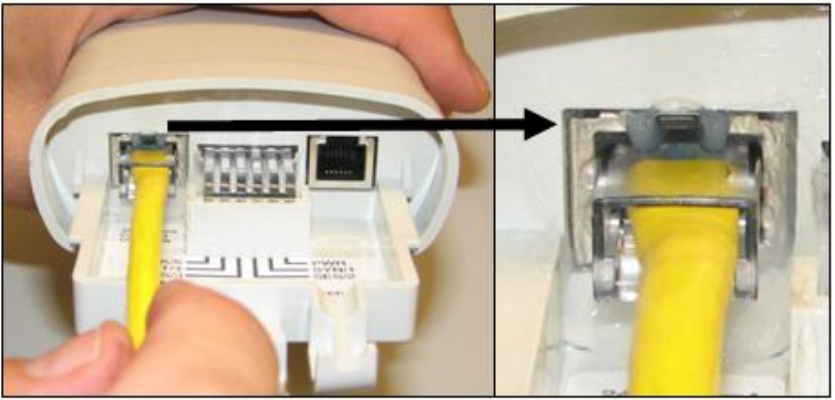
PMP 400/430 and PTP 200/230 Series Motorola PMP Solutions User Guide Supplement
Issue 6.0 May 2011 Page 63 of 77
Figure 33: Dielectric Grease - Insert Ethernet Cable
The PMP 400 SM and PTP 200 BH have a ground/Protective Earth lug, just like the AP. Although
not as critical as in the case of the AP (where there is metal-to-metal connectivity through the
coax and antenna to ground), the lug can be used to ground the SM or BH for additional
protection. In addition, a 600SS can be used within 3 ft (1 m) of the SM or BH to provide
additional protection. Especially for a BH, or in cases where the SM is mounted high and is more
exposed, or in known difficult areas for lightning, consider using these two techniques to increase
the radio’s resistance to lightning.
In all cases where Ethernet cables penetrate a building, home, or telecommunications hut, mount
a properly-grounded 600SS outside at the point of Ethernet cable building entry to protect
persons and property in the building.
PMP 400/430 and PTP 200/230 Series modules do not display a jitter value. Use Receive Power
Level for aiming and then use Link Tests to confirm alignment.
The Receive Power Level is a relative, not absolute, value. The Receive Power Level on a
module is useful during installation to aid in aiming where relative values over a short period of
time are of interest. The displayed Receive Power Level is not designed to be highly accurate
over time. The displayed Receive Power Level will vary with board-level temperature and may
vary from module to module even if the actual received power is not varying. Know the limitations
and use caution and judgment for any other use of Receive Power Level. Caution is advised
when using Receive Power Level for monitoring a link over time, deciding if the link is within
operating margins, deciding if a link is serviceable (link tests give a much better indication), or
comparing the link to other links.
The alignment headset will play a tone that varies in pitch (received power level), but not volume
(jitter), since PMP 400/430 and PTP 200/230 Series modules don’t calculate a jitter.

PMP 400/430 and PTP 200/230 Series Motorola PMP Solutions User Guide Supplement
Issue 6.0 May 2011 Page 64 of 77
6 Regulatory and Legal Notices
6.1 IMPORTANT NOTE ON MODIFICATIONS
Intentional or unintentional changes or modifications to the equipment must not be made unless
under the express consent of the party responsible for compliance. Any such modifications could
void the user’s authority to operate the equipment and will void the manufacturer’s warranty.
6.2 NATIONAL AND REGIONAL REGULATORY NOTICES
6.2.1 U.S. Federal Communication Commission (FCC) Notification
For 5.4-GHz and 5.8-GHz devices:
This device complies with Part 15 of the US FCC Rules and Regulations. Operation is subject to
the following two conditions: (1) This device may not cause harmful interference, and (2) This
device must accept any interference received, including interference that may cause undesired
operation.
This equipment has been tested and found to comply with the limits for a Class B digital device,
pursuant to Part 15 of the US FCC Rules. These limits are designed to provide reasonable
protection against harmful interference in a residential installation. This equipment generates,
uses, and can radiate radio-frequency energy and, if not installed and used in accordance with
these instructions, may cause harmful interference to radio communications. If this equipment
does cause harmful interference to radio or television reception, which can be determined by
turning the equipment on and off, the user is encouraged to correct the interference by one or
more of the following measures:
Increase the separation between the affected equipment and the unit;
Connect the affected equipment to a power outlet on a different circuit from that
which the receiver is connected to;
Consult the dealer and/or experienced radio/TV technician for help.
For 4.9-GHz devices:
The 4.9-GHz band is a licensed band allocated to public safety services. State and local
government entities that provide public safety services are eligible to apply for 4.9 GHz licenses.
For additional information, refer to FCC regulations.
FCC IDs and the specific configurations covered are listed in Table 15.

PMP 400/430 and PTP 200/230 Series Motorola PMP Solutions User Guide Supplement
Issue 6.0 May 2011 Page 65 of 77
Table 15: US FCC IDs and Industry Canada Certification Numbers and Covered Configurations
FCC ID
Industry
Canada Cert
Number
Frequencies
Module
Families
Antenna
Maximum
Tx Output
Power
ABZ89FT7634
---
5 MHz channels,
centered on 5727.5-
5845 in 5 MHz
increments (within the
5725-5850 MHz ISM
band)
5780APC
17 dBi connectorized
PCTEL Model
8514724E01 antenna (60°
x 5° -3 dB beam width)
with 1 dB connector cable
loss
19 dBm
10 MHz channels,
centered on 5730-
5845 in 5 MHz
increments (within the
5725-5850 MHz ISM
band)
20 MHz channels,
centered on 5735-
5840 in 5 MHz
increments (within the
5725-5850 MHz ISM
band)
ABZ89FT7635
109W-5790
5 MHz channels,
centered on 5727.5-
5845 in 5 MHz
increments (within the
5725-5850 MHz ISM
band)
5790SM
10 dBi (55° x 55° and 3 dB
beam width)
19 dBm
10 MHz channels,
centered on 5730-
5845 in 5 MHz
increments (within the
5725-5850 MHz ISM
band)
20 MHz channels,
centered on 5735-
5840 in 5 MHz
increments (within the
5725-5850 MHz ISM
band)
10 MHz channels,
centered on 5730-
5845 in 5 MHz
increments (within the
5725-5850 MHz ISM
band)
5780 BH
5781 BH
10 dBi (55° x 55° and 3 dB
beam width)
19 dBm
20 MHz channels,
centered on 5735-
5840 in 5 MHz
increments (within the
5725-5850 MHz ISM
band)

PMP 400/430 and PTP 200/230 Series Motorola PMP Solutions User Guide Supplement
Issue 6.0 May 2011 Page 66 of 77
ABZ89FT7637
109W-5480
10 MHz channels,
centered on 5480-
5595 and 5655-5710
MHz in 5 MHz
increments (within the
5470-5725 MHz U-NII
band with 5600-5650
MHz excluded)
5480 APC
17 dBi connectorized
PCTEL Model
8514724E01 antenna (60°
x 5° -3 dB beam width)
with 1 dB connector cable
loss
10 dBm
20 MHz channels,
centered on 5485-
5590 and 5660-5705
MHz in 5 MHz
increments (within the
5470-5725 MHz U-NII
band with 5600-5650
MHz excluded)
13 dBm
ABZ89FT7638
109W-5490
10 MHz channels,
centered on 5480-
5595 and 5655-5710
MHz in 5 MHz
increments (within the
5470-5725 MHz U-NII
band with 5600-5650
MHz excluded)
5490 SM
5480 BH
5481 BH
10 dBi (55° x 55° -3 dB
beam width)
17 dBm
20 MHz channels,
centered on 5485-
5590 and 5660-5705
MHz in 5 MHz
increments (within the
5470-5725 MHz U-NII
band with 5600-5650
MHz excluded)
19 dBm
---
109W-5780
5 MHz channels,
centered on 5727.5-
5845 in 5 MHz
increments (within the
5725-5850 MHz ISM
band)
5780APC
17 dBi connectorized
PCTEL Model
8514724E01 antenna (60°
x 5° -3 dB beam width)
with 1 dB connector cable
loss
19 dBm
10 MHz channels,
centered on 5730-
5845 in 5 MHz
increments (within the
5725-5850 MHz ISM
band)
20 MHz channels,
centered on 5735-
5840 in 5 MHz
increments (within the
5725-5850 MHz ISM
band)
---
109W-5790
5 MHz channels,
centered on 5727.5-
5845 in 5 MHz
increments (within the
5725-5850 MHz ISM
band)
5790SM
10 dBi (55° x 55° and 3 dB
beam width)
19 dBm

PMP 400/430 and PTP 200/230 Series Motorola PMP Solutions User Guide Supplement
Issue 6.0 May 2011 Page 67 of 77
10 MHz channels,
centered on 5730-
5845 in 5 MHz
increments (within the
5725-5850 MHz ISM
band)
20 MHz channels,
centered on 5735-
5840 in 5 MHz
increments (within the
5725-5850 MHz ISM
band)
ABZ89FT7629
---
10 MHz channels,
centered on 5480-
5595 and 5655-5710
MHz in 5 MHz
increments (within the
5470-5725 MHz U-NII
band)
5440 AP
18 dBi connectorized
PCTEL Model
8514724E01 antenna (60°
x 5° -3 dB beam width)
with 1 dB connector cable
loss
10 dBm
5440 SM
5440 BH
17 dBi integrated antenna
(15° x 15° -3 dB beam
width)
10 dBm
---
109W-5440
10 MHz channels,
centered on 5480-
5595 and 5655-5710
MHz in 5 MHz
increments (within the
5470-5725 MHz U-NII
band with 5600-5650
MHz excluded)
5440 AP
18 dBi connectorized
PCTEL Model
8514724E01 antenna (60°
x 5° -3 dB beam width)
with 1 dB connector cable
loss
10 dBm
5440 SM
5440 BH
17 dBi integrated antenna
(15° x 15° -3 dB beam
width)
10 dBm
ABZ89FT7631
109W-4940
10 MHz channels,
centered on 4945-
4985 in 5 MHz
increments (within the
4940-4990 MHz
public safety licensed
band)
4940 AP
18 dBi connectorized
PCTEL Model AP
85010066001 antenna (60°
x 5° -3 dB beam width)
with 1 dB cable loss
18 dBm
4940 SM
4940 BH
17 dBi integrated antenna
(15.5° x 17.5° (el x az) -3
dB beam width)
18 dBm
Note 1: To ensure regulatory compliance, including DFS compliance, the professional installer is responsible
for:
setting the Region Code on the Configuration => General page to the correct region
setting the Transmitter Output Power on the Confiiguration => Radio page no higher than listed for a given
configuration
setting the External Gain on the Configuration => Radio page, if displayed, to the gain of any external
device (such as a reflector or lens)
6.2.2 Industry Canada (IC) Notification
For 5.4 and 5.8-GHz devices:
This device complies with RSS-210 of Industry Canada. Operation is subject to the following two
conditions: (1) This device may not cause harmful interference, and (2) This device must accept
any interference received, including interference that may cause undesired operation.
Users should be cautioned to take note that in Canada high power radars are allocated as
primary users (meaning they have priority) of 5650 – 5850 MHz and these radars could cause
interference and/or damage to license-exempt local area networks (LELAN).

PMP 400/430 and PTP 200/230 Series Motorola PMP Solutions User Guide Supplement
Issue 6.0 May 2011 Page 68 of 77
This equipment has been tested and found to comply with the limits for a Class B digital device,
pursuant to RSS-210 of Industry Canada. These limits are designed to provide reasonable
protection against harmful interference in a residential installation. This equipment generates,
uses, and can radiate radio-frequency energy and, if not installed and used in accordance with
these instructions, may cause harmful interference to radio communications. If this equipment
does cause harmful interference to radio or television reception, which can be determined by
turning the equipment on and off, the user is encouraged to correct the interference by one or
more of the following measures:
Increase the separation between the affected equipment and the unit;
Connect the affected equipment to a power outlet on a different circuit from that
which the receiver is connected to;
Consult the dealer and/or experienced radio/TV technician for help.
To reduce potential radio interference to other users, the antenna type and its gain should be
chosen so its Equivalent Isotropic Radiated Power (EIRP) is not more than that permitted for
successful communication.
Industry Canada Certification Numbers and the specific configurations covered are listed in Table
15.
This device has been designed to operate with the antennas listed in Table 15 and having a
maximum gain as shown in Table 15. Antennas not included in Table 15 or having a gain greater
than as shown in Table 15 are strictly prohibited from use with this device. Required antenna
impedance is 50 ohms.
For 4.9-GHz devices:
The 4.9-GHz band is a licensed band allocated to public safety services. State and local
government entities that provide public safety services are eligible to apply for 4.9 GHz licenses.
For additional information, refer to Industry Canada regulations.
6.2.3 Regulatory Requirements for CEPT Member States (www.cept.org)
When operated in accordance with the instructions for use, Motorola Canopy Wireless equipment
operating in the 5.4 GHz bands is compliant with CEPT Recommendation 70-03 Annex 3 for
Wideband Data Transmission and HIPERLANs. For compliant operation in the 5.4 GHz band, the
transmit power (EIRP) from the integrated antenna or a connectorized antenna shall be no more
than 0.5 W (27 dBm).
For EU member states, RLAN equipment in the 5.4GHz bands is exempt from individual licensing
under Commission Recommendation 2003/203/EC. Contact the appropriate national
administrations for details on the conditions of use for the bands in question and any exceptions
that might apply. Also see www.ero.dk for further information.
10 MHz channels are used, centered on 5475 to 5595 and 5655 to 5715 in 5 MHz increments.
This is within the 5470 to 5725 MHz U-NII band with 5600 to 5650 MHz excluded.
Motorola Canopy Radio equipment operating in the 5470 to 5725 MHz band are categorized as
“Class 1” devices within the EU in accordance with ECC DEC(04)08 and are “CE” marked
to show compliance with the European Radio & Telecommunications Terminal Equipment
(R&TTE) directive 1999/5/EC. The relevant Declaration of Conformity can be found at
http://motorola.wirelessbroadbandsupport.com/doc.php.
A European Commission decision, implemented by Member States on 31 October 2005, makes
the frequency band 5470-5725 MHz available in all EU Member States for wireless access
systems. Under this decision, the designation of Canopy 5.4GHz products become “Class 1
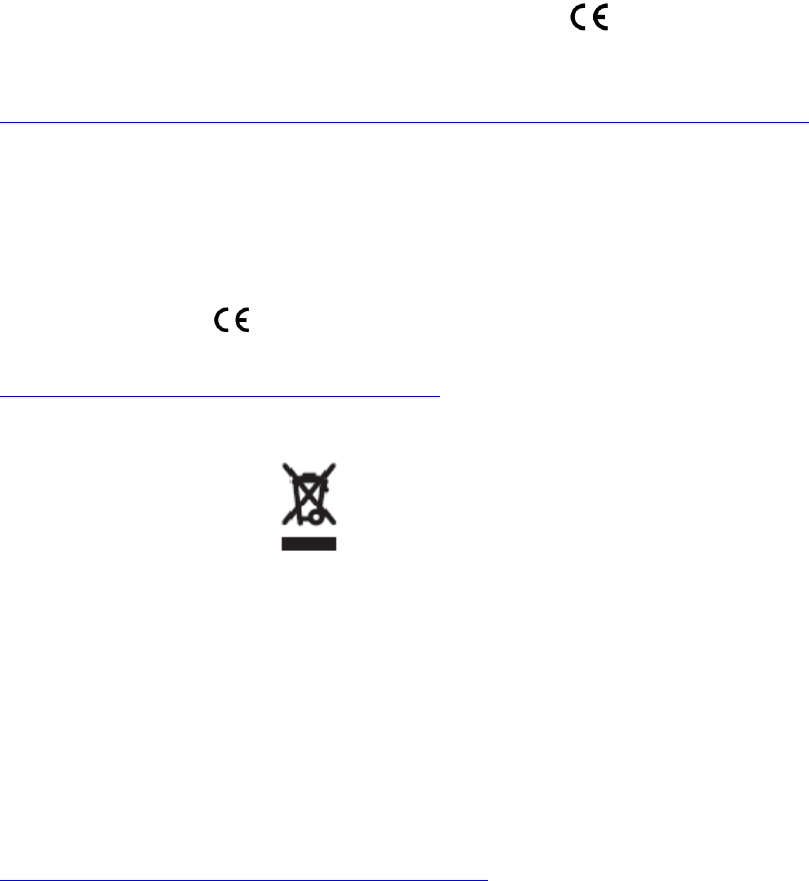
PMP 400/430 and PTP 200/230 Series Motorola PMP Solutions User Guide Supplement
Issue 6.0 May 2011 Page 69 of 77
devices” and these do not require notification under article 6, section 4 of the R&TTE Directive.
Consequently, these 5.4GHz products are only marked with the symbol and may be used in
any member state.
For further details, see
http://europa.eu.int/information_society/policy/radio_spectrum/ref_documents/index_en.htm
6.2.4 European Union Notification for 5.8 GHz Product
The 5.7 and 5.8 GHz connectorized product is a two-way radio transceiver suitable for use in Broadband
Wireless Access System (WAS), Radio Local Area Network (RLAN), or Fixed Wireless Access (FWA)
systems. It is a Class 2 device and uses operating frequencies that are not harmonized throughout the EU
member states. The operator is responsible for obtaining any national licenses required to operate this
product and these must be obtained before using the product in any particular country.
This equipment is marked to show compliance with the European R&TTE directive 1999/5/EC.
The relevant Declaration of Conformity can be found at
http://motorola.wirelessbroadbandsupport.com/doc.php.
6.2.5 Equipment Disposal
Waste (Disposal)
of Electronic
and Electric
Equipment
Please do not dispose of Electronic and Electric Equipment or Electronic and Electric Accessories
with your household waste. In some countries or regions, collection systems have been set up to
handle waste of electrical and electronic equipment. In European Union countries, please contact
your local equipment supplier representative or service center for information about the waste
collection system in your country.
6.2.6 EU Declaration of Conformity for RoHS Compliance
Motorola hereby declares that these Motorola products are in compliance with the essential
requirements and other relevant provisions of Directive 2002/95/EC, Restriction of the use of
certain Hazardous Substances (RoHS) in electrical and electronic equipment.
The relevant Declaration of Conformity can be found at
http://motorola.wirelessbroadbandsupport.com/doc.php.
6.2.7 UK Notification
The 5.8 GHz connectorized product has been notified for operation in the UK, and when operated in
accordance with instructions for use it is compliant with UK Interface Requirement IR2007. For UK use,
installations must conform to the requirements of IR2007 in terms of EIRP spectral density against elevation
profile above the local horizon in order to protect Fixed Satellite Services. The frequency range 5795-5815
MHz is assigned to Road Transport & Traffic Telematics (RTTT) in the U.K. and shall not be used by FWA
systems in order to protect RTTT devices. UK licensing specifies that radiolocation services shall be
protected by a Dynamic Frequency Selection (DFS) mechanism to prevent co-channel operation in the
presence of radar signals.
6.2.8 Luxembourg Notification
5.4GHz products can only be used for mobile services.

PMP 400/430 and PTP 200/230 Series Motorola PMP Solutions User Guide Supplement
Issue 6.0 May 2011 Page 70 of 77
6.2.9 Czech Republic Notification
5.4 GHz products can be operated in accordance with the Czech General License
No. GL-30/R/2000.
6.2.10 Greece Notification
The outdoor use of 5470-5725MHz is under license of EETT but is being harmonized according
to the CEPT Decision ECC/DEC/(04) 08, of 9th July. End users are advised to contact the EETT
to determine the latest position and obtain any appropriate licenses.
6.2.11 Brazil Notification
Brazil regulatory authorities have not approved these devices for operation in Brazil. Until
they are approved, they are not available for sale in Brazil, and the information in this
section is provisional and preliminary.
For compliant operation in the 5.4 GHz band, the Equivalent Isotropic Radiated Power from the
integrated antenna or connectorized anteanna shall not exceed 27 dBm (0.5 W).
The operator is responsible for enabling the DFS feature on any Canopy 5.4 GHz radio by setting
the Region Code to “Brazil”, including after the module is reset to factory defaults.
Important Note: This equipment operates as a secondary application, so it has no rights against
harmful interference, even if generated by similar equipment, and cannot cause harmful
interference on systems operating as primary applications.
6.2.12 Labeling and Disclosure Table for China
The People’s Republic of China requires that Motorola’s products comply with China
Management Methods (CMM) environmental regulations. (China Management Methods refers to
the regulation Management Methods for Controlling Pollution by Electronic Information Products.)
Two items are used to demonstrate compliance; the label and the disclosure table.
The label is placed in a customer visible position on the product.
Logo 1 means that the product contains no substances in excess of the maximum
concentration value for materials identified in the China Management Methods regulation.
Logo 2 means that the product may contain substances in excess of the maximum
concentration value for materials identified in the China Management Methods regulation,
and has an Environmental Friendly Use Period (EFUP) in years, fifty years in the
example shown.
Logo 1
Logo 2
The Environmental Friendly Use Period (EFUP) is the period (in years) during which the Toxic
and Hazardous Substances (T&HS) contained in the Electronic Information Product (EIP) will not
leak or mutate causing environmental pollution or bodily injury from the use of the EIP. The EFUP
indicated by the Logo 2 label applies to a product and all its parts. Certain field-replaceable parts,
such as battery modules, can have a different EFUP and are marked separately.
The Disclosure Table (see Table 16) is intended only to communicate compliance with China
requirements; it is not intended to communicate compliance with EU RoHS or any other
environmental requirements.

PMP 400/430 and PTP 200/230 Series Motorola PMP Solutions User Guide Supplement
Issue 6.0 May 2011 Page 71 of 77
Table 16: Disclosure Table
部件名称
有毒有害物质或元素
铅
(Pb)
汞
(Hg)
镉
(Cd)
六价铬
(Cr6+)
多溴联苯
(PBB)
多溴二苯醚
(PBDE)
金属部件
×
○
×
×
○
○
电路模块
×
○
×
×
○
○
电缆及电缆组件
×
○
×
×
○
○
塑料和聚合物部件
○
○
○
○
○
×
○: 表示该有毒有害物质在该部件所有均质材料中的含量均在SJ/T11363-2006 标准规定的限量要求以下。
×: 表示该有毒有害物质至少在该部件的某一均质材料中的含量超出SJ/T11363-2006 标准规定的限量要求。
6.3 EXPOSURE SEPARATION DISTANCES
To protect from overexposure to RF energy, install Canopy radios so as to provide and maintain
the minimum separation distances from all persons shown in Table 17.
Table 17: Exposure Separation Distances
Module Type
Separation Distance from Persons
PMP 400/430 AP or SM or PTP 200/230 BH
At least 20 cm (approx 8 in)
PMP 430 SM or PTP 230 with Reflector Dish
At least 1.5 m (approx 5 ft)
PMP 430 SM or PTP 230 with LENS
At least 50 cm (approx 20 in)
Canopy Module (for comparison)
At least 20 cm (approx 8 in)
Section 6.3.1 and Table 18 give details and discussion of the associated calculations.
6.3.1 Details of Exposure Separation Distances Calculations and Power Compliance
Margins
Limits and guidelines for RF exposure come from:
US FCC limits for the general population. See the FCC web site at http://www.fcc.gov,
and the policies, guidelines, and requirements in Part 1 of Title 47 of the Code of Federal
Regulations, as well as the guidelines and suggestions for evaluating compliance in FCC
OET Bulletin 65.
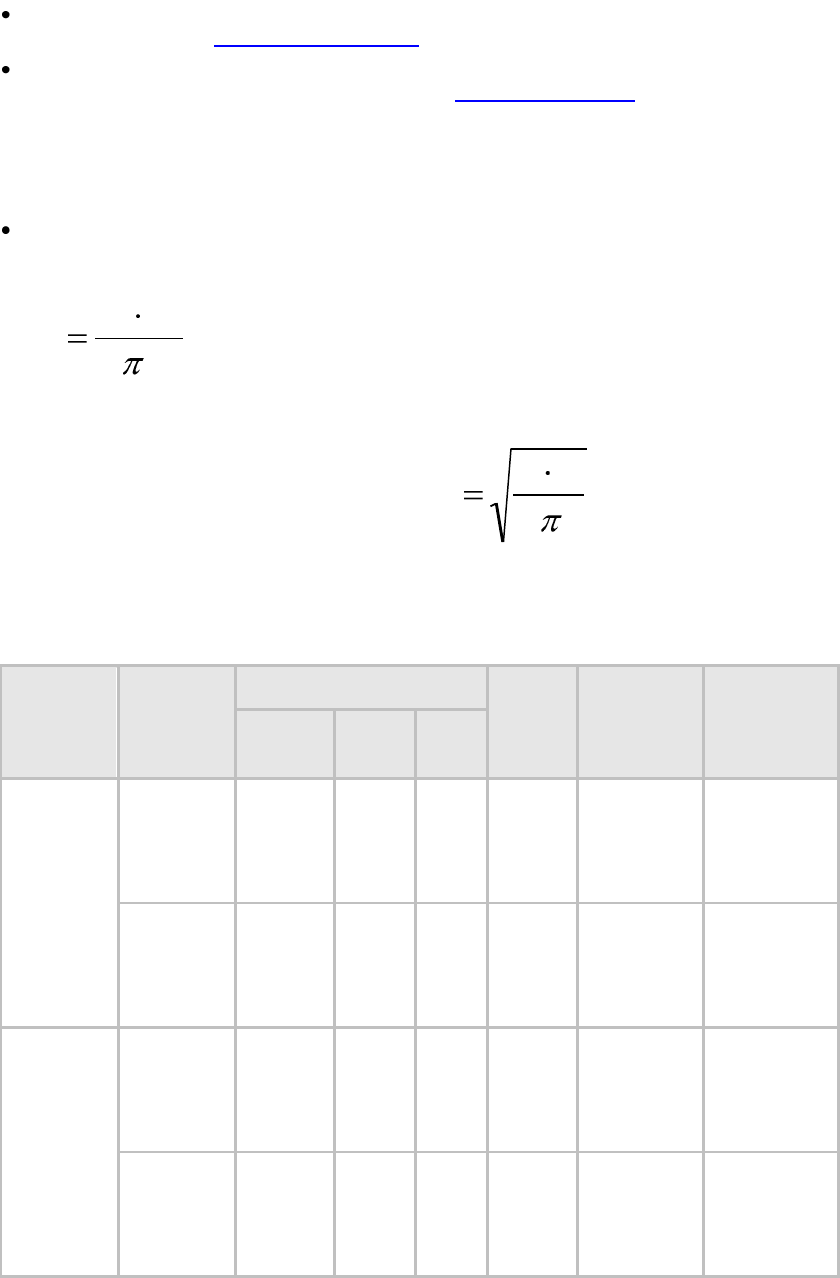
PMP 400/430 and PTP 200/230 Series Motorola PMP Solutions User Guide Supplement
Issue 6.0 May 2011 Page 72 of 77
Health Canada limits for the general population. See Safety Code 6 on the Health
Canada web site at http://www.hc-sc.gc.ca/.
ICNIRP (International Commission on Non-Ionizing Radiation Protection) guidelines for
the general public. See the ICNIRP web site at http://www.icnirp.de/ and Guidelines for
Limiting Exposure to Time-Varying Electric, Magnetic, and Electromagnetic Fields.
The applicable power density exposure limits from the documents referenced above are
10 W/m2 for RF energy in the 5.4-GHz frequency bands.
Peak power density in the far field of a radio frequency point source is calculated as follows:
SP G
4d2
where
S = power density in W/m2
P = RMS transmit power capability of the radio, in W
G = total Tx gain as a factor, converted from dB
d = distance from point source, in m
Rearranging terms to solve for distance yields
dP G
4S
Table 18 shows calculated minimum separation distances d, recommended distances and
resulting power compliance margins for each frequency band and antenna combination.
Table 18: Calculated Exposure Distances and Power Compliance Margins
Frequency
Band
Antenna
Variable
d
(calcu-
lated)
Recom-
mended
Separation
Distance
Power
Compliance
Margin
P
G
S
5.4 / 5.8
GHz OFDM
Integrated,
10 dBi
0.079 W
(19 dBm)
10
(10 dB)
10
W/m2
or 1
mW/c
m2
8 cm
20 cm
(8 in)
6.3
Connectori
zed, 17 dBi
0.05 W
(10 dBm)
50
(17 dB)
10
W/m2
or 1
mW/c
m2
6 cm
20 cm
(8 in)
10
4.9 GHz
OFDM
Integrated,
10 dBi
0.079 W
(19 dBm)
10
(10 dB)
10
W/m2
or 1
mW/c
m2
8 cm
20 cm
(8 in)
6.3
Connectori
zed, 17 dBi
0.063 W
(18 dBm)
40
(16 dB)
10
W/m2
or 1
mW/c
m2
14 cm
20 cm
(8 in)
2

PMP 400/430 and PTP 200/230 Series Motorola PMP Solutions User Guide Supplement
Issue 6.0 May 2011 Page 73 of 77
The “Recommended Distances” are chosen to give significant compliance margin in all cases.
They are also chosen so that an OFDM module has the same exposure distance as a Canopy
module, to simplify communicating and heeding exposure distances in the field.
These are conservative distances:
They are along the beam direction (the direction of greatest energy). Exposure to the
sides and back of the module will be significantly less.
They meet sustained exposure limits for the general population (not just short term
occupational exposure limits), with considerable margin.
The calculated compliance distance d is overestimated because the far-field equation
models the antenna as a point source and neglects the physical dimension of the
antenna.
6.4 LEGAL NOTICES
6.4.1 Software License Terms and Conditions
ONLY OPEN THE PACKAGE, OR USE THE SOFTWARE AND RELATED PRODUCT IF YOU
ACCEPT THE TERMS OF THIS LICENSE. BY BREAKING THE SEAL ON THIS DISK KIT /
CDROM, OR IF YOU USE THE SOFTWARE OR RELATED PRODUCT, YOU ACCEPT THE
TERMS OF THIS LICENSE AGREEMENT. IF YOU DO NOT AGREE TO THESE TERMS, DO
NOT USE THE SOFTWARE OR RELATED PRODUCT; INSTEAD, RETURN THE SOFTWARE
TO PLACE OF PURCHASE FOR A FULL REFUND. THE FOLLOWING AGREEMENT IS A
LEGAL AGREEMENT BETWEEN YOU (EITHER AN INDIVIDUAL OR ENTITY), AND
MOTOROLA, INC. (FOR ITSELF AND ITS LICENSORS). THE RIGHT TO USE THIS
PRODUCT IS LICENSED ONLY ON THE CONDITION THAT YOU AGREE TO THE
FOLLOWING TERMS.
Now, therefore, in consideration of the promises and mutual obligations contained herein, and for
other good and valuable consideration, the receipt and sufficiency of which are hereby mutually
acknowledged, you and Motorola agree as follows:
Grant of License. Subject to the following terms and conditions, Motorola, Inc., grants to you a
personal, revocable, non-assignable, non-transferable, non-exclusive and limited license to use
on a single piece of equipment only one copy of the software contained on this disk (which may
have been pre-loaded on the equipment)(Software). You may make two copies of the Software,
but only for backup, archival, or disaster recovery purposes. On any copy you make of the
Software, you must reproduce and include the copyright and other proprietary rights notice
contained on the copy we have furnished you of the Software.
Ownership. Motorola (or its supplier) retains all title, ownership and intellectual property rights to
the Software and any copies, including translations, compilations, derivative works (including
images) partial copies and portions of updated works. The Software is Motorola’s (or its
supplier's) confidential proprietary information. This Software License Agreement does not
convey to you any interest in or to the Software, but only a limited right of use. You agree not to
disclose it or make it available to anyone without Motorola’s written authorization. You will
exercise no less than reasonable care to protect the Software from unauthorized disclosure. You
agree not to disassemble, decompile or reverse engineer, or create derivative works of the
Software, except and only to the extent that such activity is expressly permitted by applicable law.
Termination. This License is effective until terminated. This License will terminate immediately
without notice from Motorola or judicial resolution if you fail to comply with any provision of this
License. Upon such termination you must destroy the Software, all accompanying written
PMP 400/430 and PTP 200/230 Series Motorola PMP Solutions User Guide Supplement
Issue 6.0 May 2011 Page 74 of 77
materials and all copies thereof, and the sections entitled Limited Warranty, Limitation of
Remedies and Damages, and General will survive any termination.
Limited Warranty. Motorola warrants for a period of ninety (90) days from Motorola’s or its
customer’s shipment of the Software to you that (i) the disk(s) on which the Software is recorded
will be free from defects in materials and workmanship under normal use and (ii) the Software,
under normal use, will perform substantially in accordance with Motorola’s published
specifications for that release level of the Software. The written materials are provided "AS IS"
and without warranty of any kind. Motorola's entire liability and your sole and exclusive remedy
for any breach of the foregoing limited warranty will be, at Motorola's option, replacement of the
disk(s), provision of downloadable patch or replacement code, or refund of the unused portion of
your bargained for contractual benefit up to the amount paid for this Software License.
THIS LIMITED WARRANTY IS THE ONLY WARRANTY PROVIDED BY MOTOROLA, AND
MOTOROLA AND ITS LICENSORS EXPRESSLY DISCLAIM ALL OTHER WARRANTIES,
EITHER EXPRESS OF IMPLIED, INCLUDING BUT NOT LIMITED TO IMPLIED WARRANTIES
OF MERCHANTABILITY AND FITNESS FOR A PARTICULAR PURPOSE AND
NONINFRINGEMENT. MOTOROLA DOES NOT WARRANT THAT THE OPERATION OF THE
SOFTWARE WILL BE UNINTERRUPTED OR ERROR-FREE, OR THAT DEFECTS IN THE
SOFTWARE WILL BE CORRECTED. NO ORAL OR WRITTEN REPRESENTATIONS MADE
BY MOTOROLA OR AN AGENT THEREOF SHALL CREATE A WARRANTY OR IN ANY WAY
INCREASE THE SCOPE OF THIS WARRANTY. MOTOROLA DOES NOT WARRANT ANY
SOFTWARE THAT HAS BEEN OPERATED IN EXCESS OF SPECIFICATIONS, DAMAGED,
MISUSED, NEGLECTED, OR IMPROPERLY INSTALLED. BECAUSE SOME JURISDICTIONS
DO NOT ALLOW THE EXCLUSION OR LIMITATION OF IMPLIED WARRANTIES, THE ABOVE
LIMITATIONS MAY NOT APPLY TO YOU.
Limitation of Remedies and Damages. Regardless of whether any remedy set forth herein fails
of its essential purpose, IN NO EVENT SHALL MOTOROLA OR ANY OF THE LICENSORS,
DIRECTORS, OFFICERS, EMPLOYEES OR AFFILIATES OF THE FOREGOING BE LIABLE TO
YOU FOR ANY CONSEQUENTIAL, INCIDENTAL, INDIRECT, SPECIAL OR SIMILAR
DAMAGES WHATSOEVER (including, without limitation, damages for loss of business profits,
business interruption, loss of business information and the like), whether foreseeable or
unforeseeable, arising out of the use or inability to use the Software or accompanying written
materials, regardless of the basis of the claim and even if Motorola or a Motorola representative
has been advised of the possibility of such damage. Motorola's liability to you for direct damages
for any cause whatsoever, regardless of the basis of the form of the action, will be limited to the
price paid for the Software that caused the damages. THIS LIMITATION WILL NOT APPLY IN
CASE OF PERSONAL INJURY ONLY WHERE AND TO THE EXTENT THAT APPLICABLE
LAW REQUIRES SUCH LIABILITY. BECAUSE SOME JURISDICTIONS DO NOT ALLOW THE
EXCLUSION OR LIMITATION OF LIABILITY FOR CONSEQUENTIAL OR INCIDENTAL
DAMAGES, THE ABOVE LIMITATION MAY NOT APPLY TO YOU.
Maintenance and Support. Motorola shall not be responsible for maintenance or support of the
software. By accepting the license granted under this agreement, you agree that Motorola will be
under no obligation to provide any support, maintenance or service in connection with the
Software or any application developed by you. Any maintenance and support of the Related
Product will be provided under the terms of the agreement for the Related Product.
Transfer. In the case of software designed to operate on Motorola equipment, you may not
transfer the Software to another party except: (1) if you are an end-user, when you are
transferring the Software together with the Motorola equipment on which it operates; or 2) if you
are a Motorola licensed distributor, when you are transferring the Software either together with
such Motorola equipment or are transferring the Software as a licensed duly paid for upgrade,
update, patch, new release, enhancement or replacement of a prior version of the Software. If
you are a Motorola licensed distributor, when you are transferring the Software as permitted
herein, you agree to transfer the Software with a license agreement having terms and conditions
PMP 400/430 and PTP 200/230 Series Motorola PMP Solutions User Guide Supplement
Issue 6.0 May 2011 Page 75 of 77
no less restrictive than those contained herein. You may transfer all other Software, not
otherwise having an agreed restriction on transfer, to another party. However, all such transfers
of Software are strictly subject to the conditions precedent that the other party agrees to accept
the terms and conditions of this License, and you destroy any copy of the Software you do not
transfer to that party. You may not sublicense or otherwise transfer, rent or lease the Software
without our written consent. You may not transfer the Software in violation of any laws,
regulations, export controls or economic sanctions imposed by the US Government.
Right to Audit. Motorola shall have the right to audit annually, upon reasonable advance notice
and during normal business hours, your records and accounts to determine compliance with the
terms of this Agreement.
Export Controls. You specifically acknowledge that the software may be subject to United
States and other country export control laws. You shall comply strictly with all requirements of all
applicable export control laws and regulations with respect to all such software and materials.
US Government Users. If you are a US Government user, then the Software is provided with
"RESTRICTED RIGHTS" as set forth in subparagraphs (c)(1) and (2) of the Commercial
Computer Software-Restricted Rights clause at FAR 52 227-19 or subparagraph (c)(1)(ii) of the
Rights in Technical Data and Computer Software clause at DFARS 252.227-7013, as applicable.
Disputes. You and Motorola hereby agree that any dispute, controversy or claim, except for any
dispute, controversy or claim involving intellectual property, prior to initiation of any formal legal
process, will be submitted for non-binding mediation, prior to initiation of any formal legal process.
Cost of mediation will be shared equally. Nothing in this Section will prevent either party from
resorting to judicial proceedings, if (i) good faith efforts to resolve the dispute under these
procedures have been unsuccessful, (ii) the dispute, claim or controversy involves intellectual
property, or (iii) interim relief from a court is necessary to prevent serious and irreparable injury to
that party or to others.
General. Illinois law governs this license. The terms of this license are supplemental to any
written agreement executed by both parties regarding this subject and the Software Motorola is to
license you under it, and supersedes all previous oral or written communications between us
regarding the subject except for such executed agreement. It may not be modified or waived
except in writing and signed by an officer or other authorized representative of each party. If any
provision is held invalid, all other provisions shall remain valid, unless such invalidity would
frustrate the purpose of our agreement. The failure of either party to enforce any rights granted
hereunder or to take action against the other party in the event of any breach hereunder shall not
be deemed a waiver by that party as to subsequent enforcement of rights or subsequent action in
the event of future breaches.
6.4.2 Hardware Warranty in US
Motorola US offers a warranty covering a period of 1 year from the date of purchase by the
customer. If a product is found defective during the warranty period, Motorola will repair or
replace the product with the same or a similar model, which may be a reconditioned unit, without
charge for parts or labor.
6.5 LIMIT OF LIABILITY
IN NO EVENT SHALL MOTOROLA BE LIABLE TO YOU OR ANY OTHER PARTY FOR ANY
DIRECT, INDIRECT, GENERAL, SPECIAL, INCIDENTAL, CONSEQUENTIAL, EXEMPLARY OR
OTHER DAMAGE ARISING OUT OF THE USE OR INABILITY TO USE THE PRODUCT
(INCLUDING, WITHOUT LIMITATION, DAMAGES FOR LOSS OF BUSINESS PROFITS,
BUSINESS INTERRUPTION, LOSS OF BUSINESS INFORMATION OR ANY OTHER
PECUNIARY LOSS, OR FROM ANY BREACH OF WARRANTY, EVEN IF MOTOROLA HAS
BEEN ADVISED OF THE POSSIBILITY OF SUCH DAMAGES. (Some states do not allow the
PMP 400/430 and PTP 200/230 Series Motorola PMP Solutions User Guide Supplement
Issue 6.0 May 2011 Page 76 of 77
exclusion or limitation of incidental or consequential damages, so the above exclusion or
limitation may not apply to you.) IN NO CASE SHALL MOTOROLA’S LIABILITY EXCEED THE
AMOUNT YOU PAID FOR THE PRODUCT.